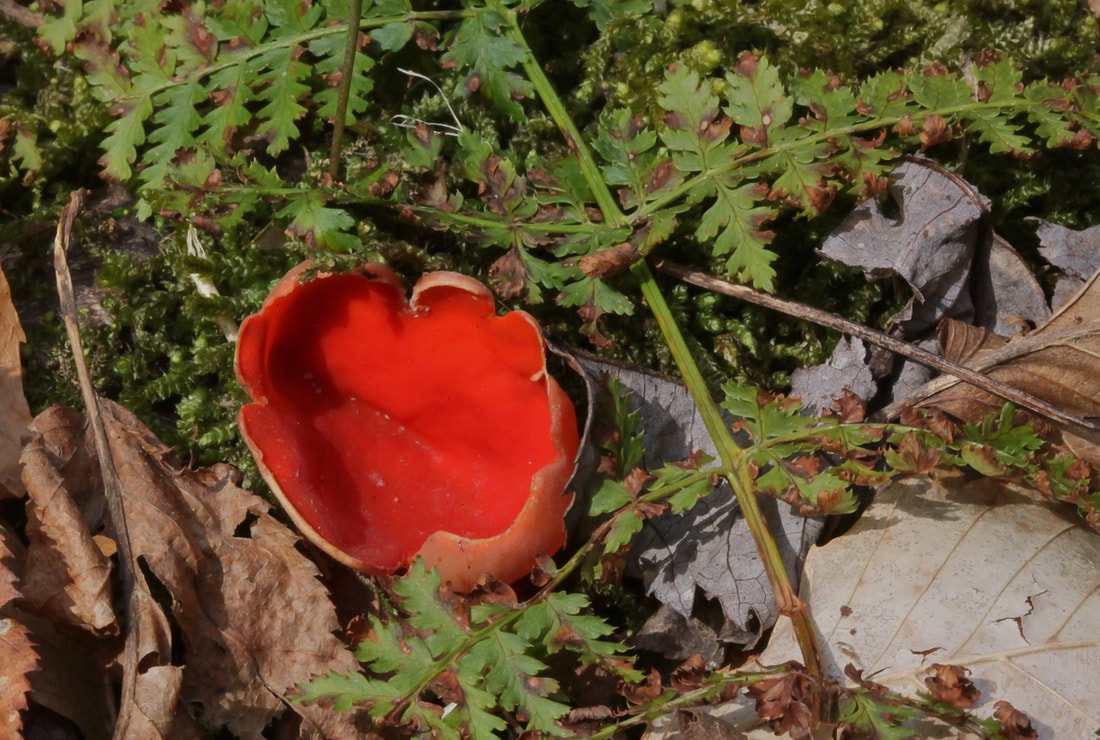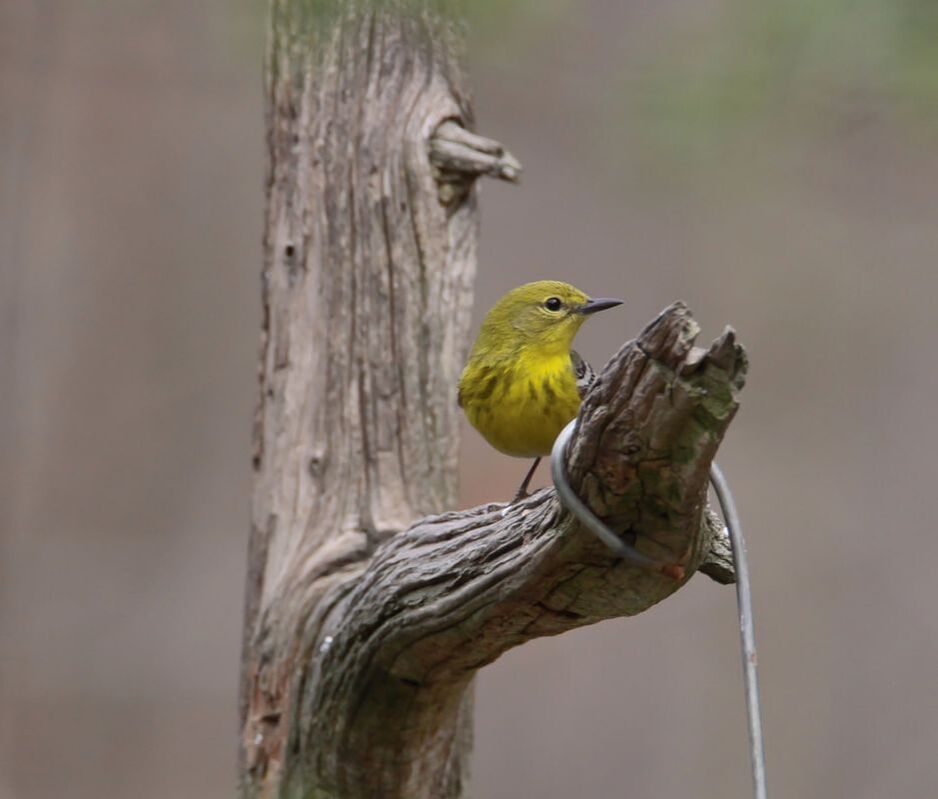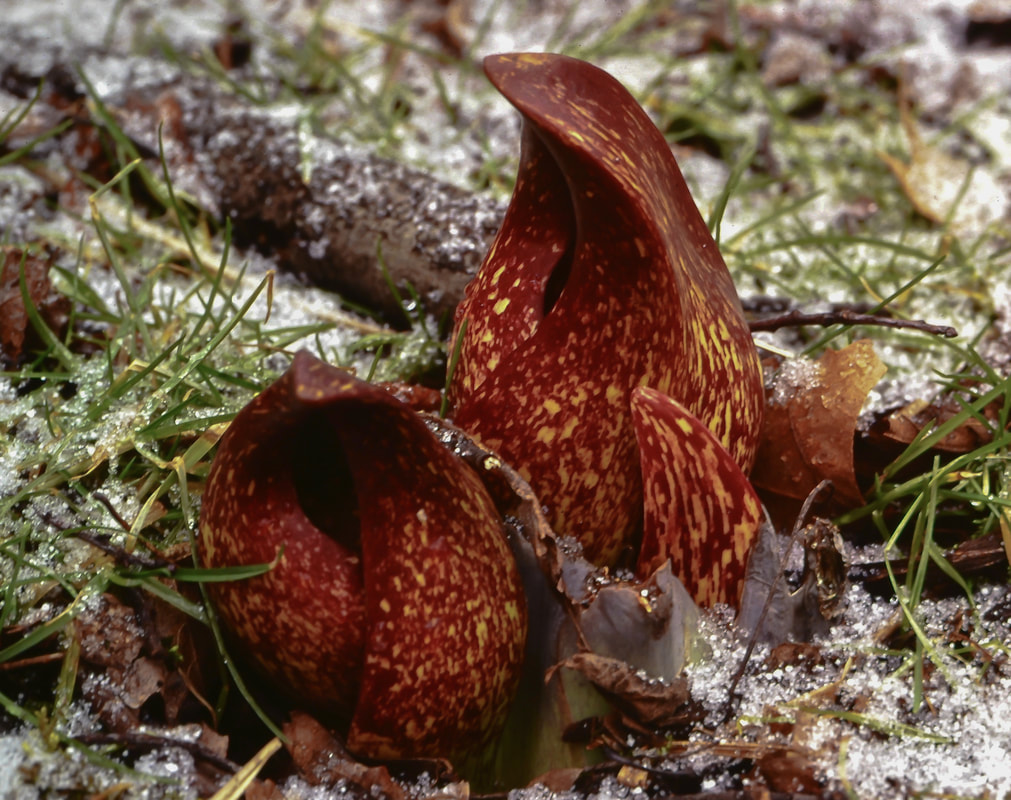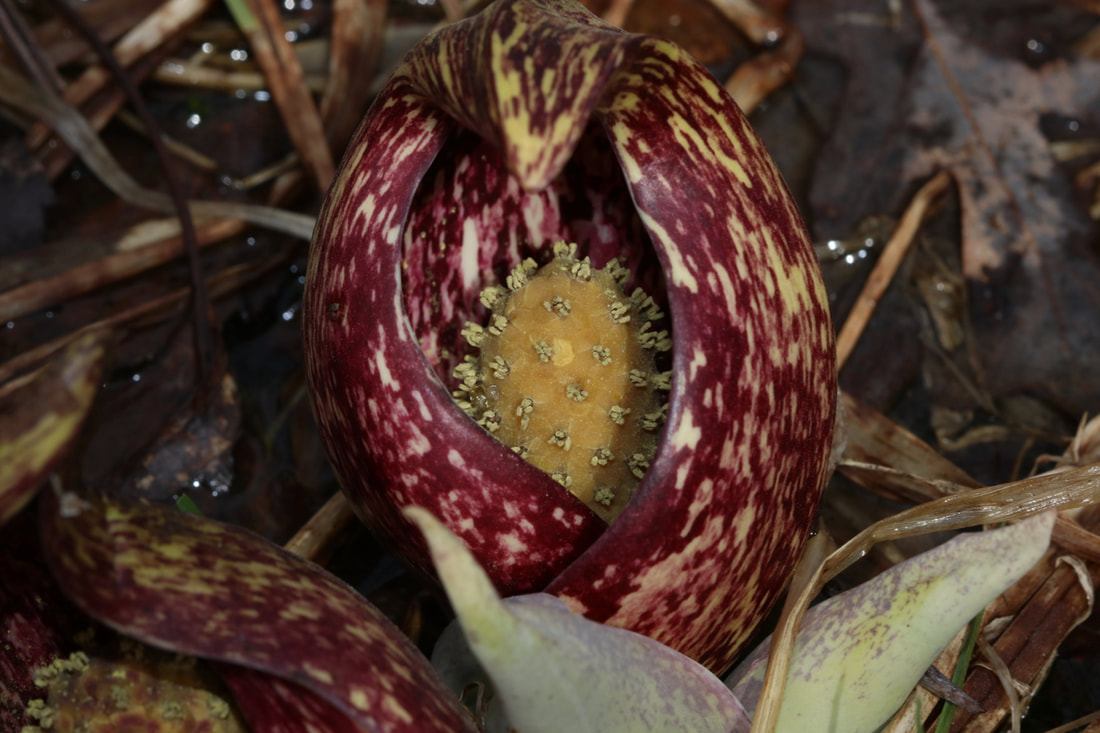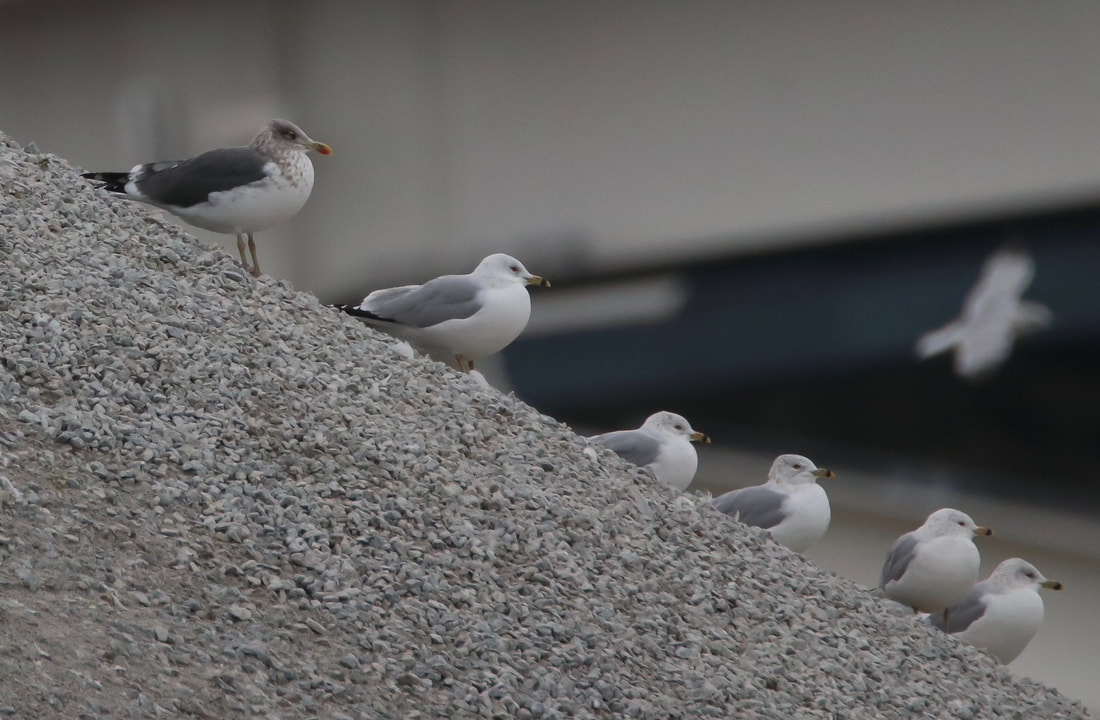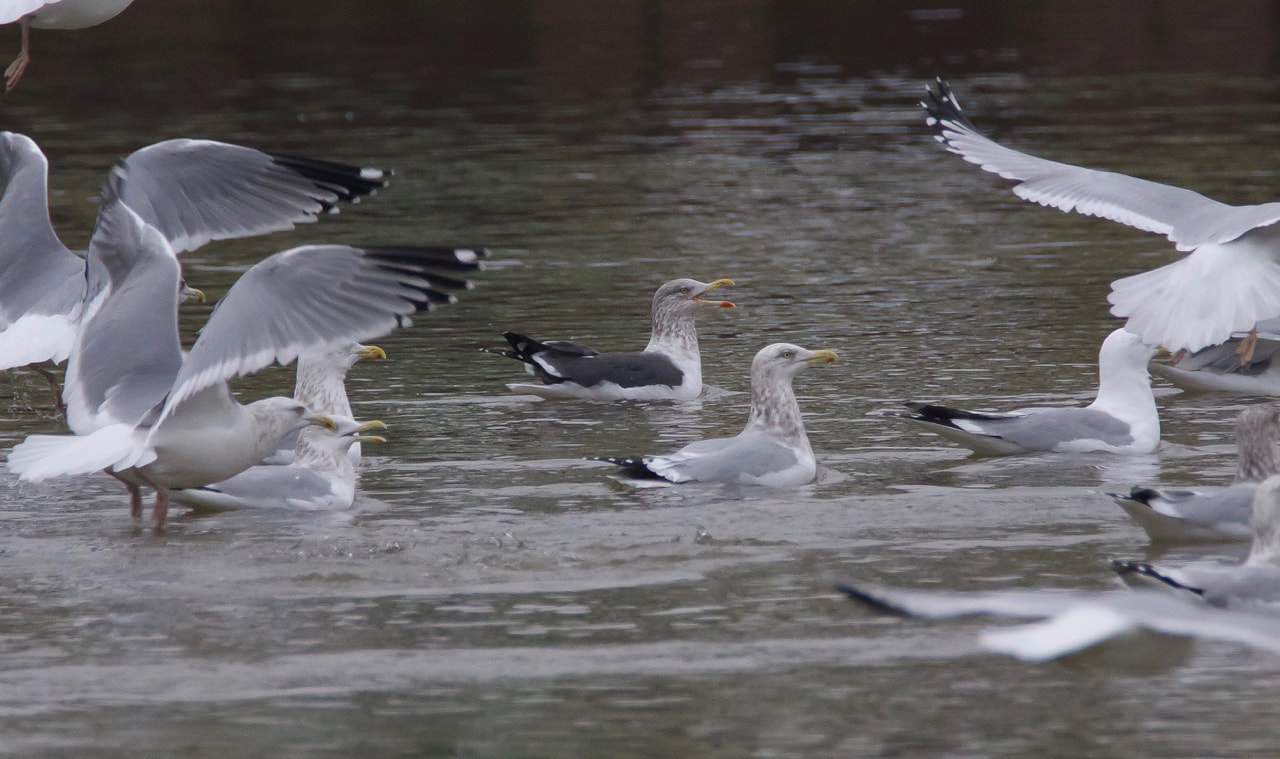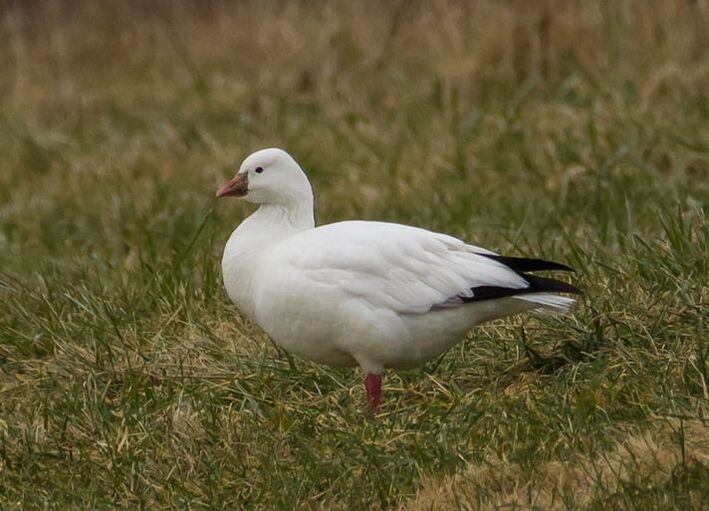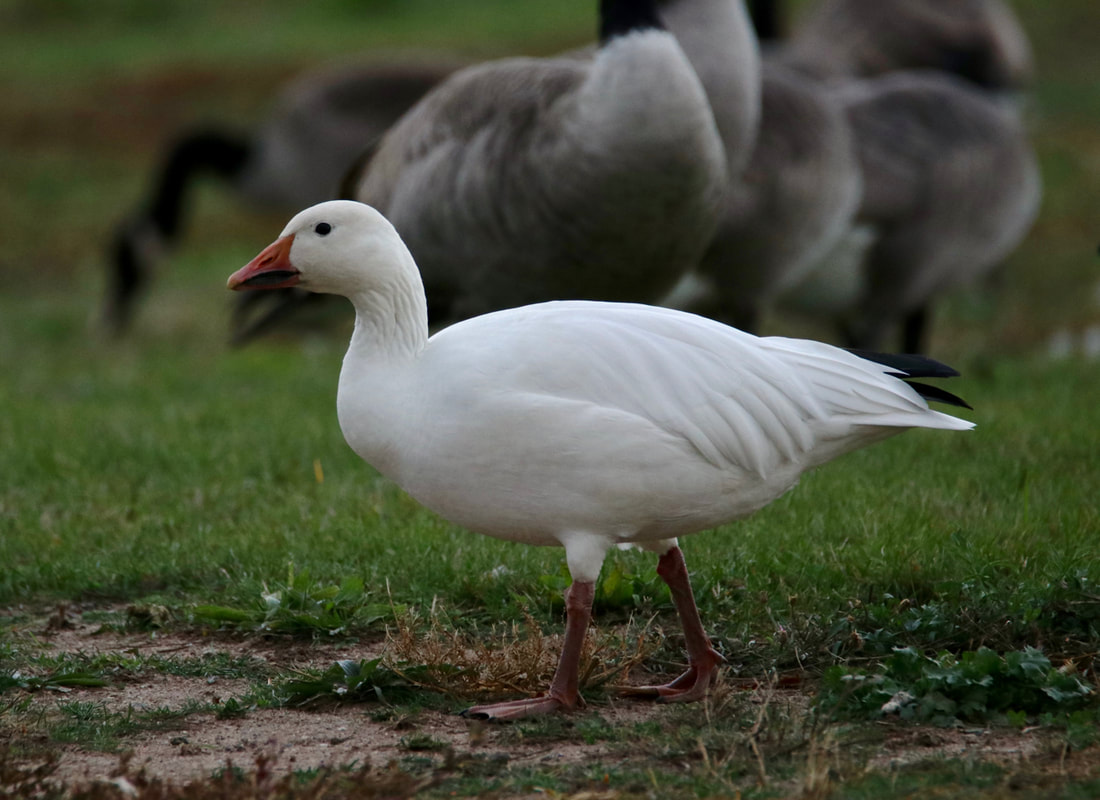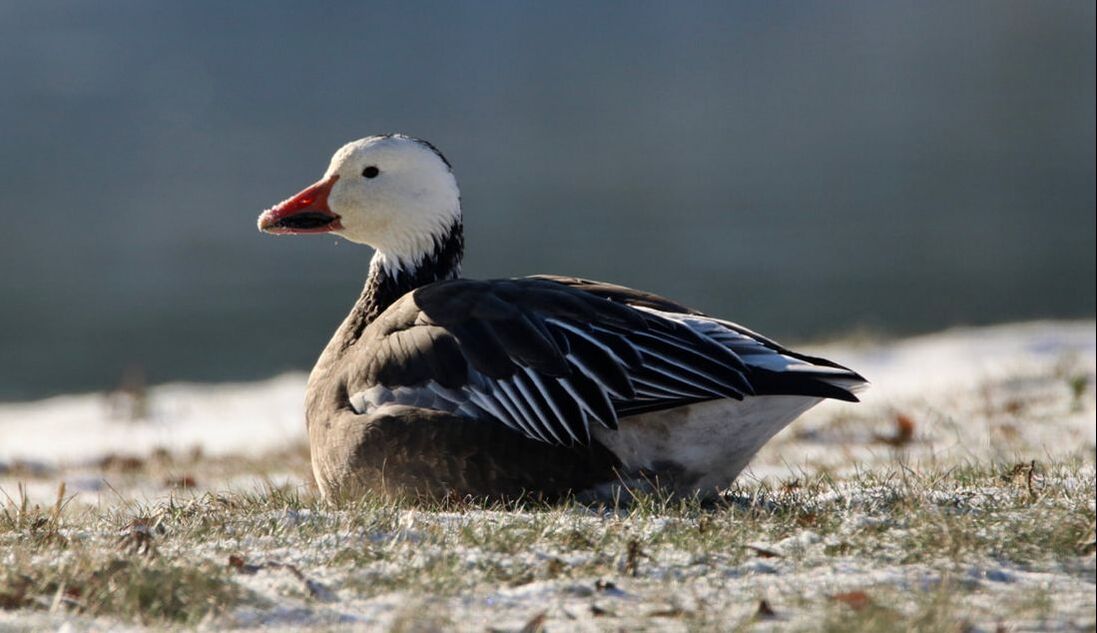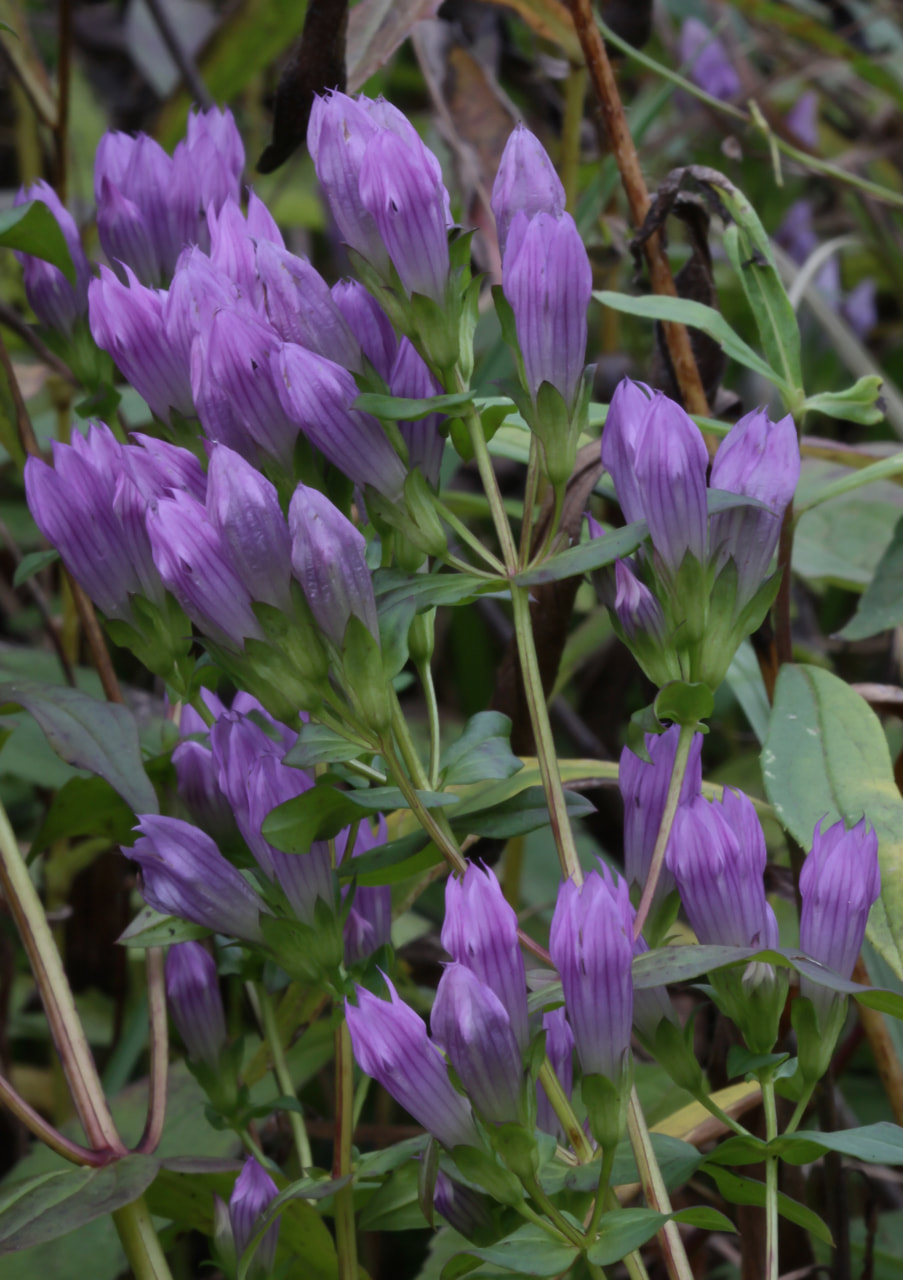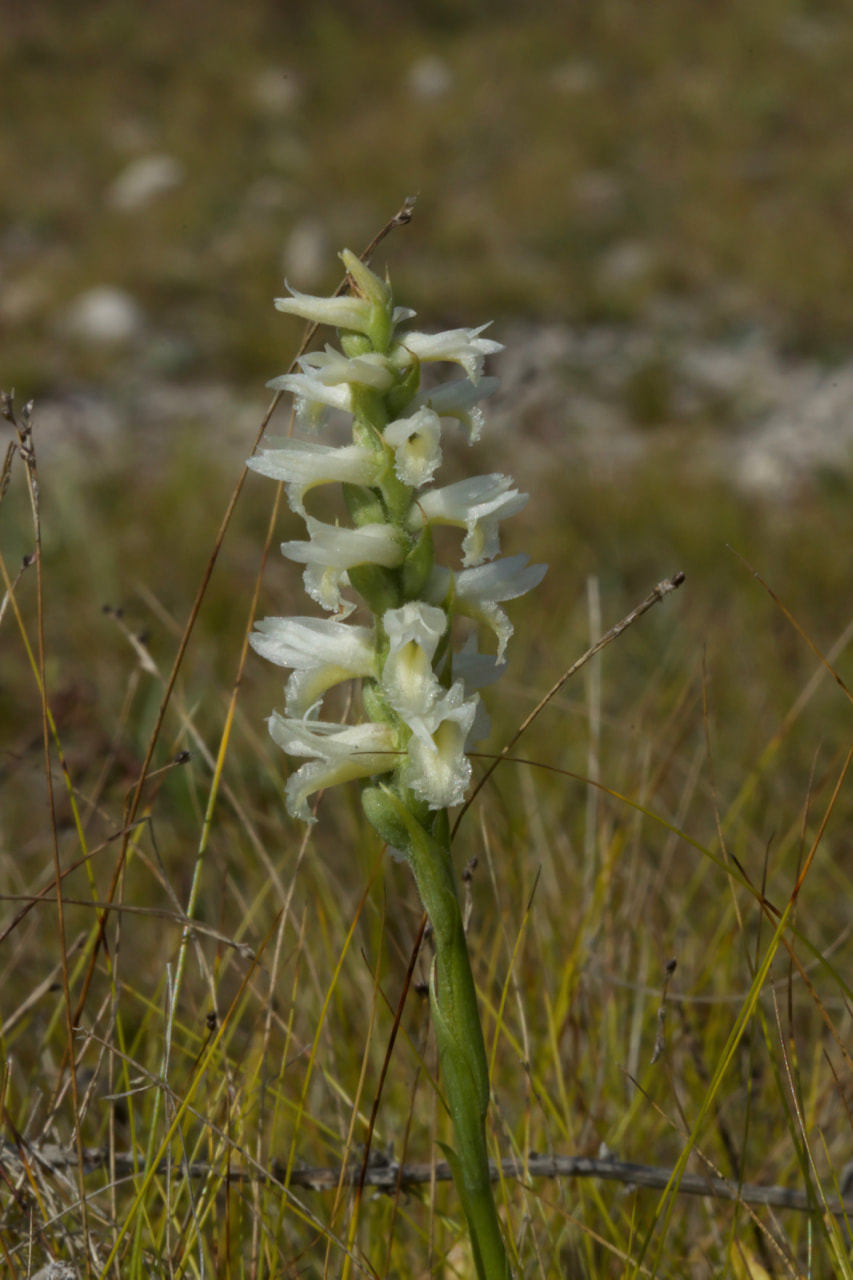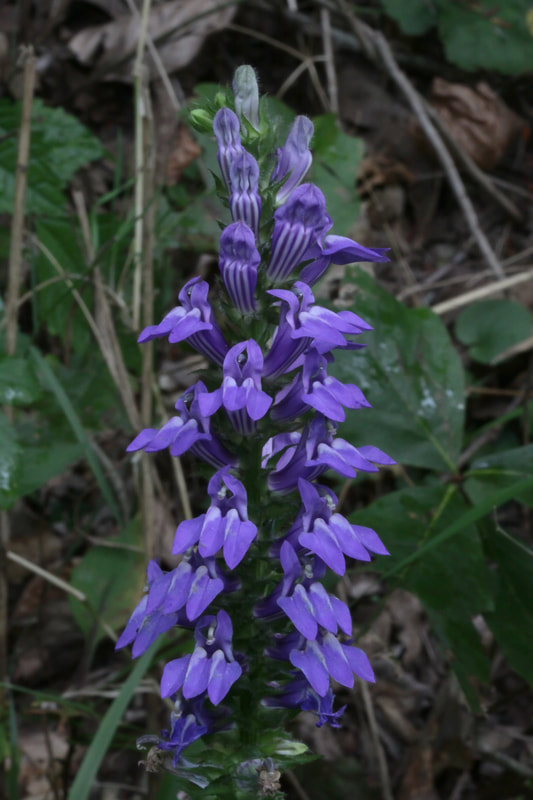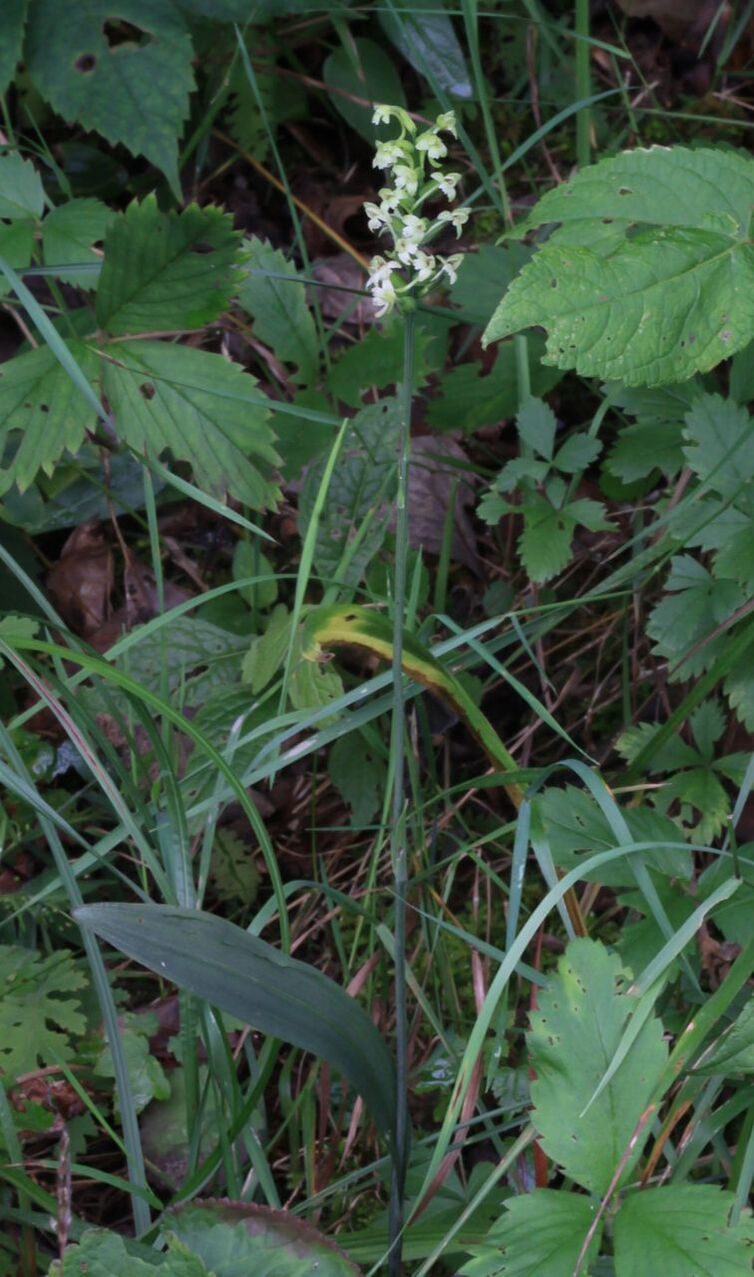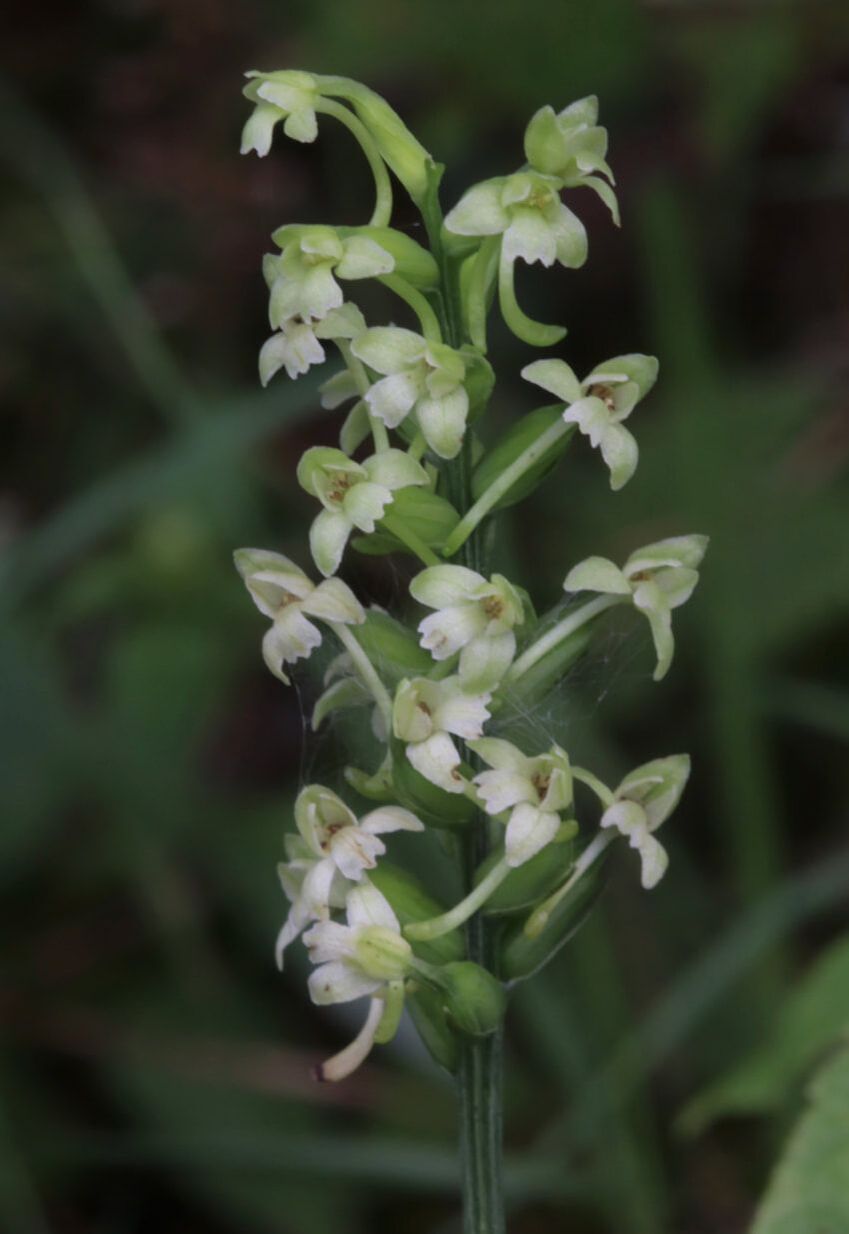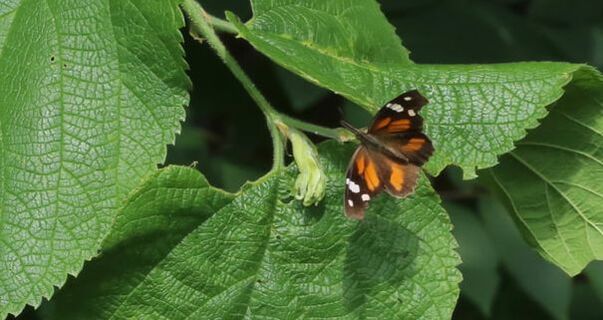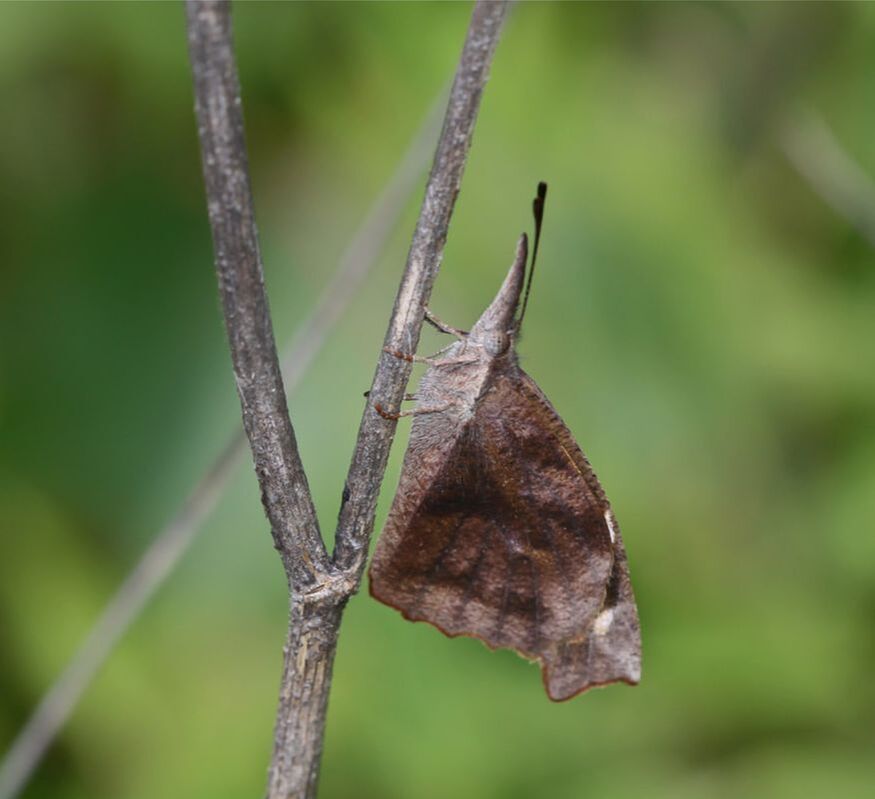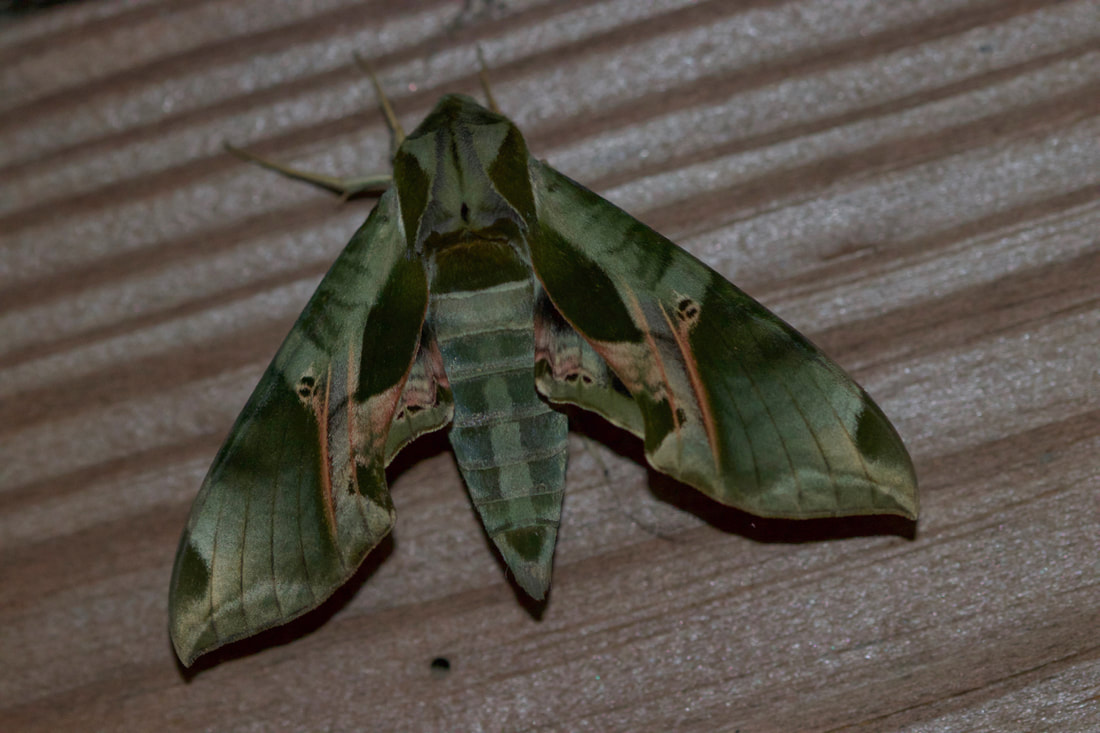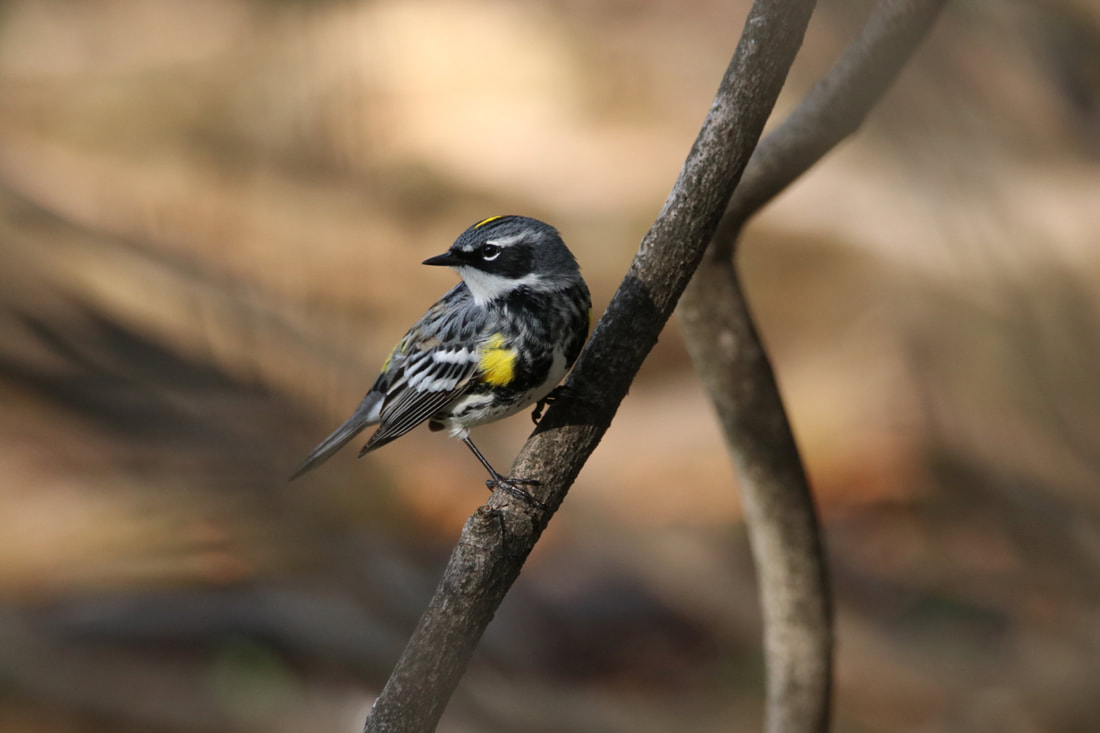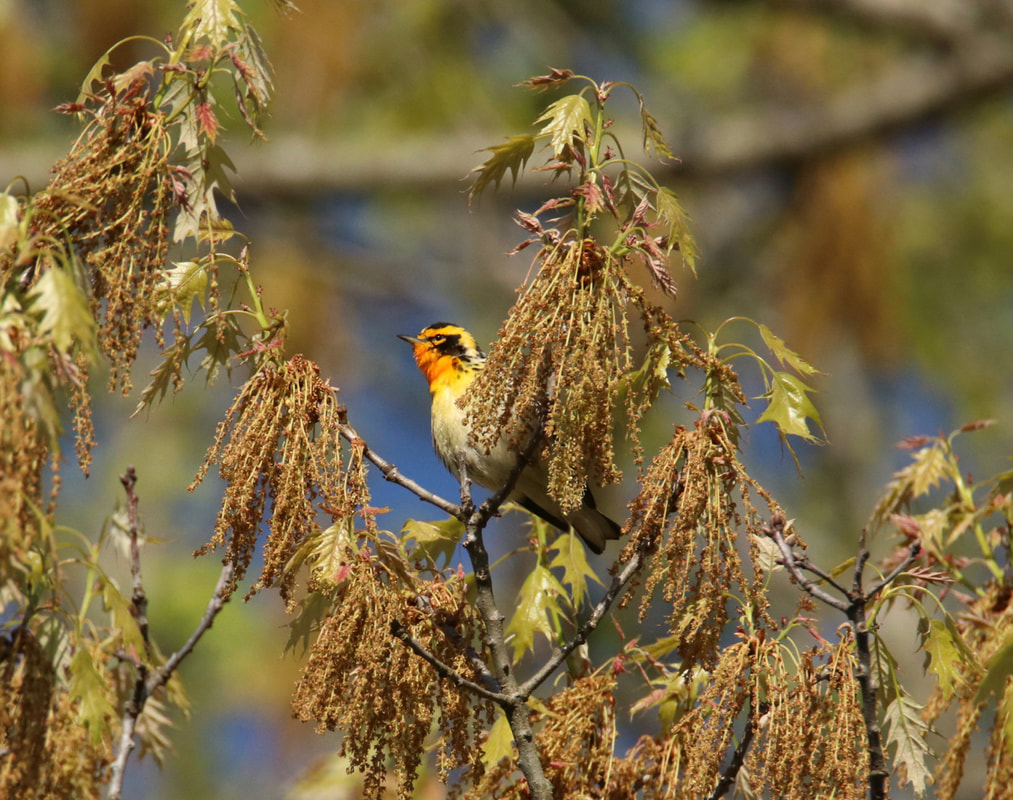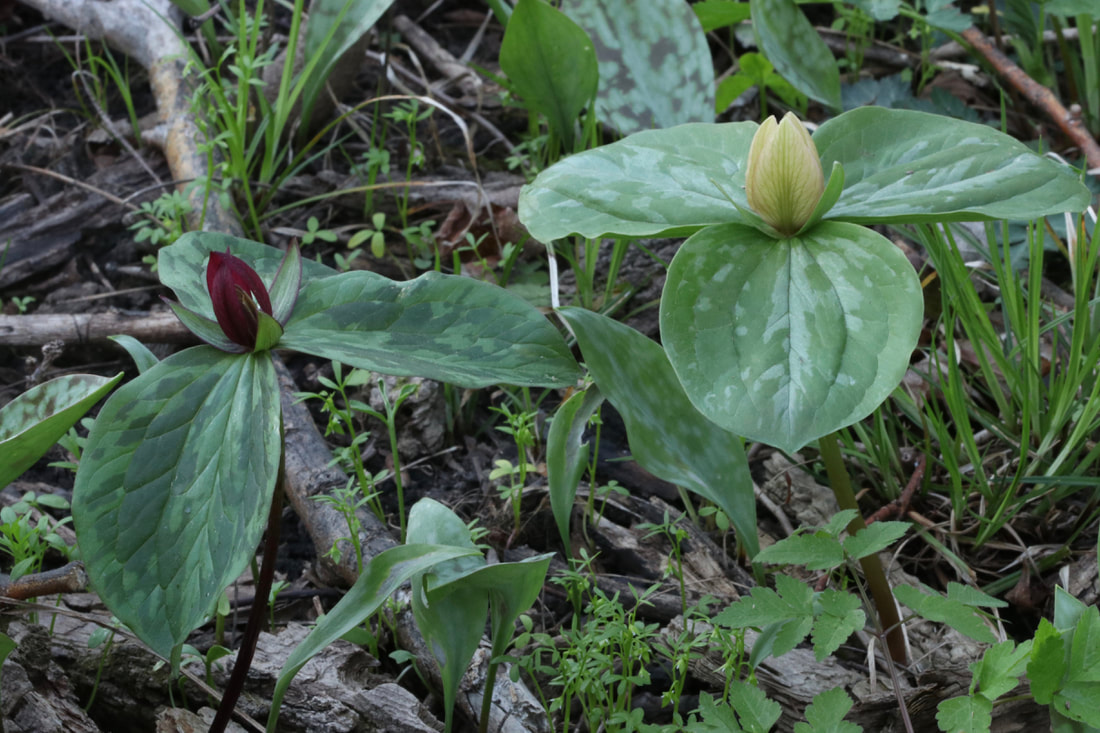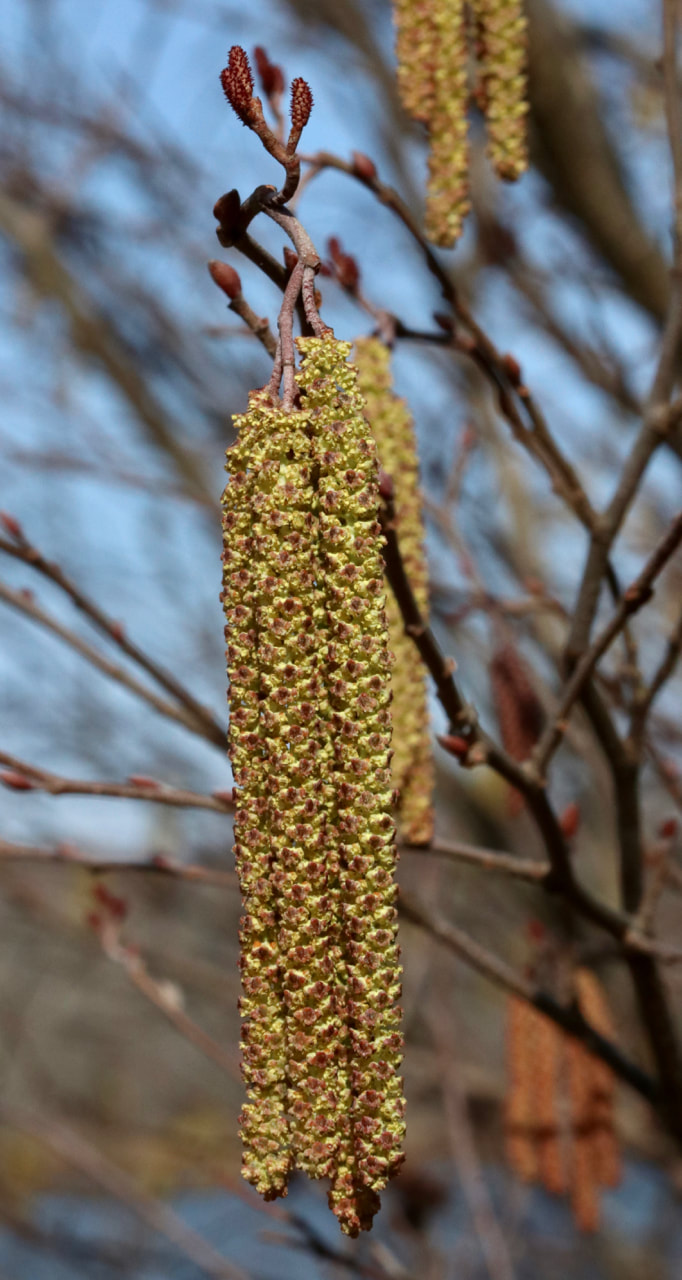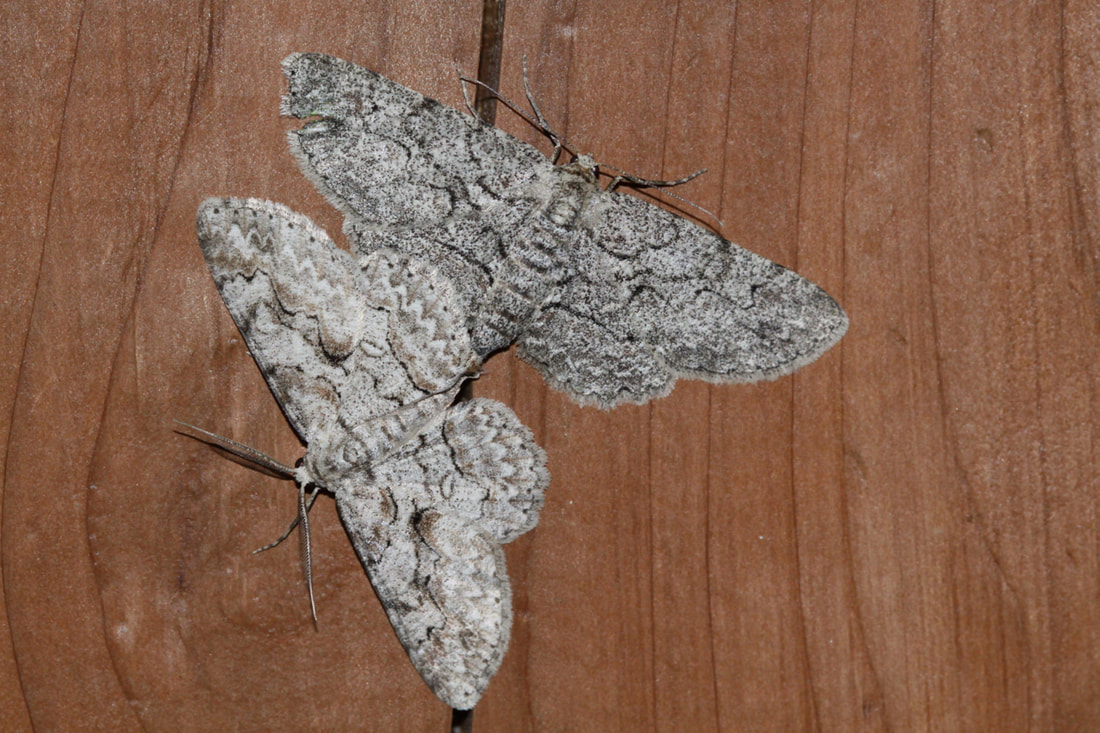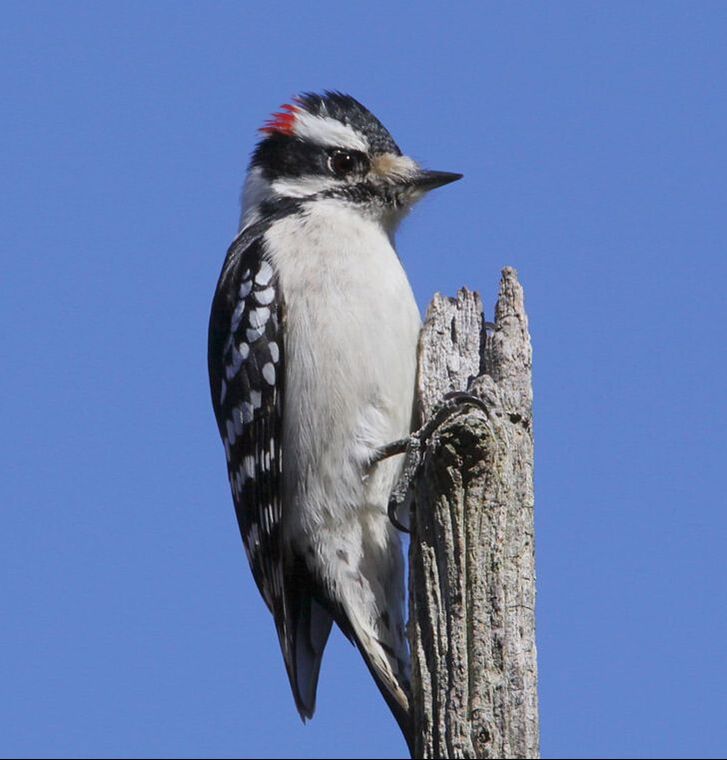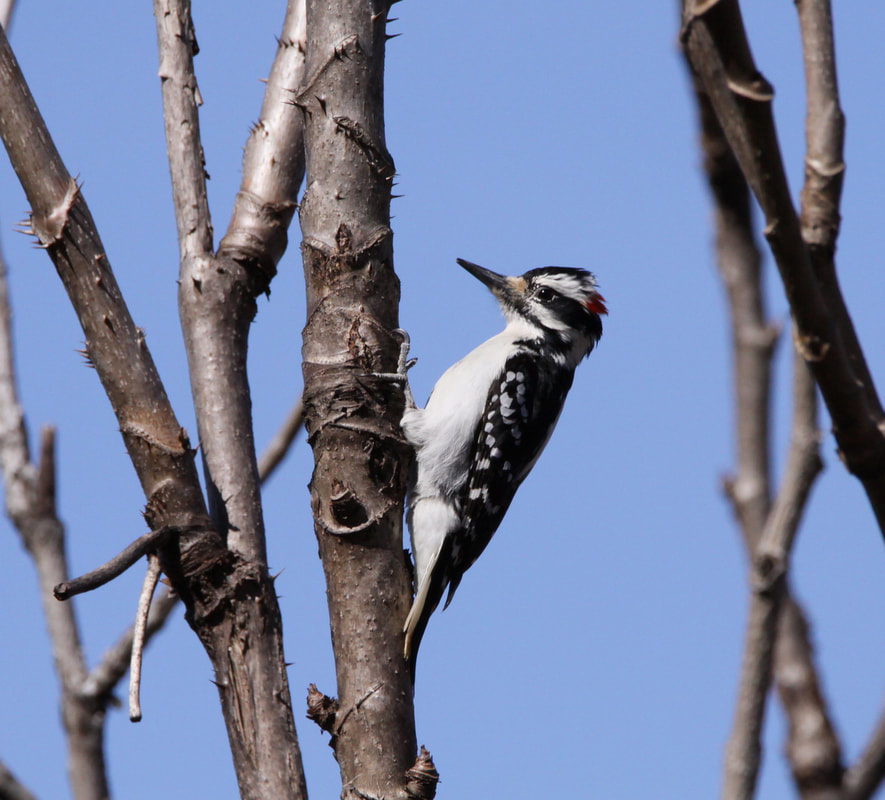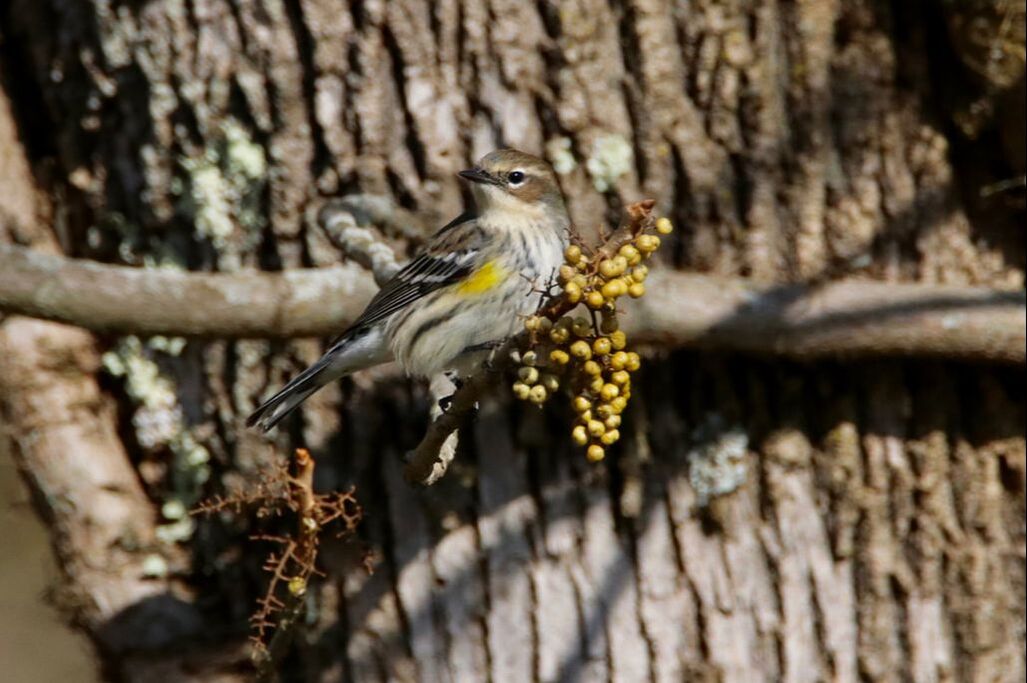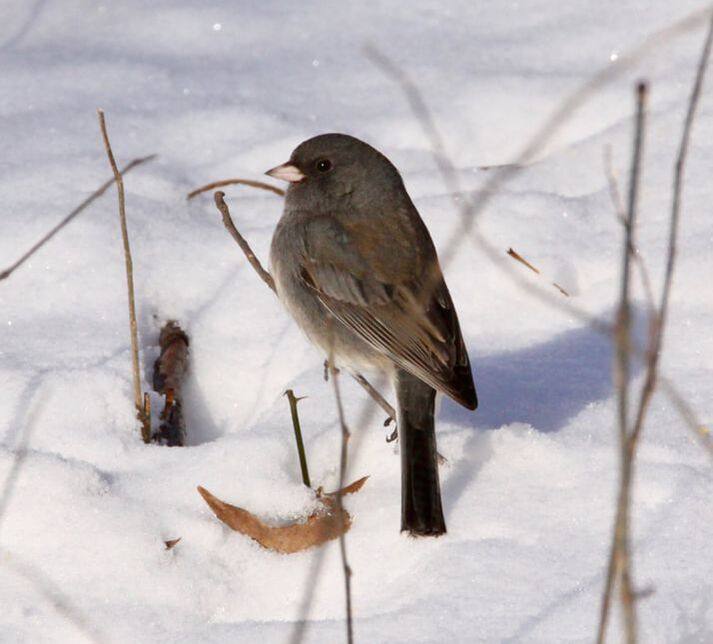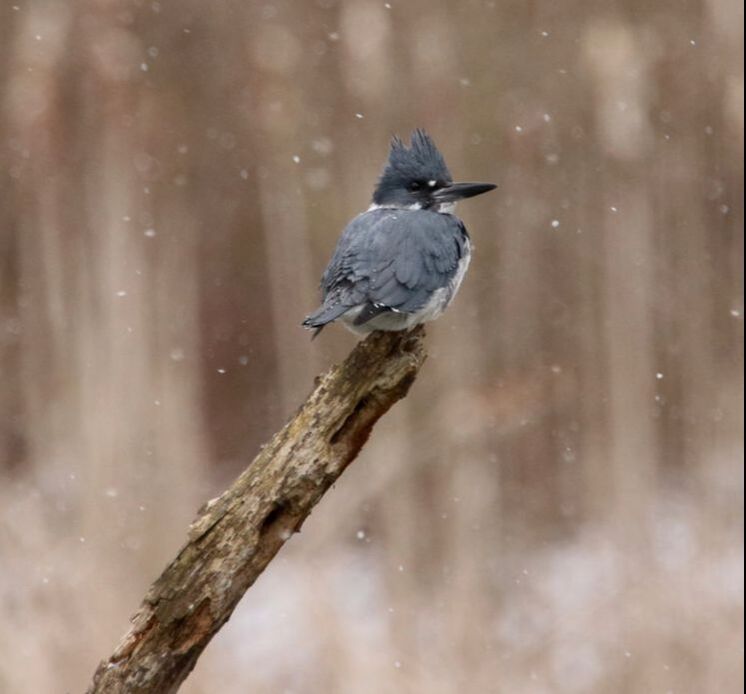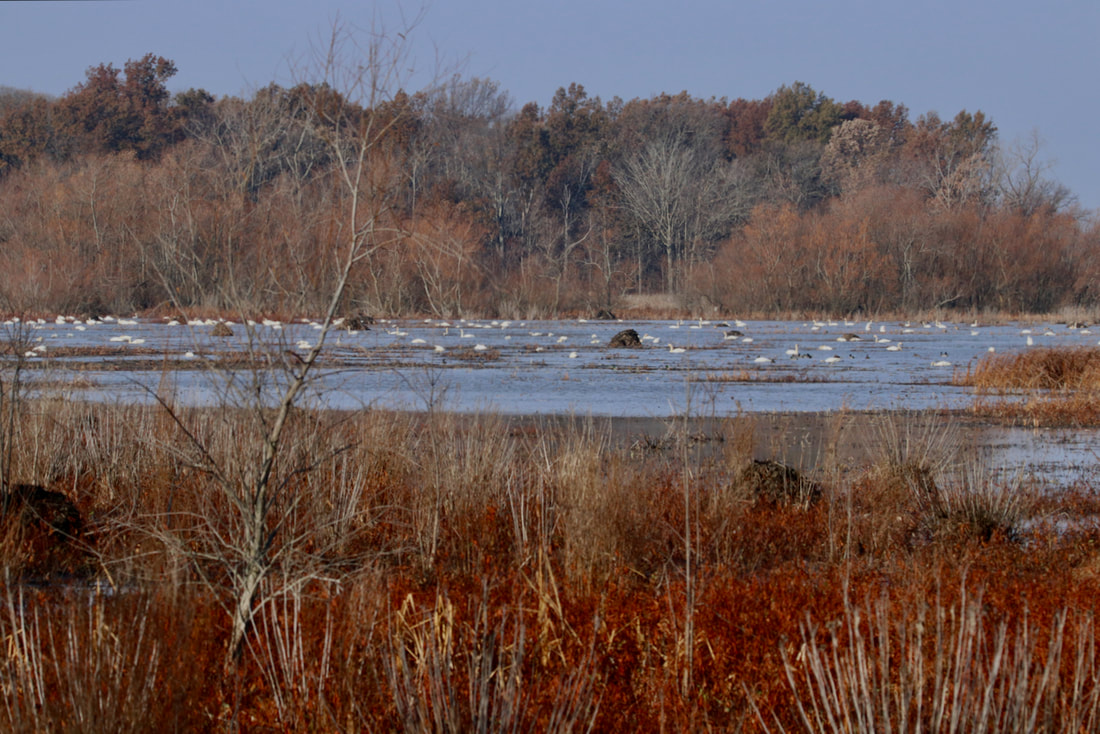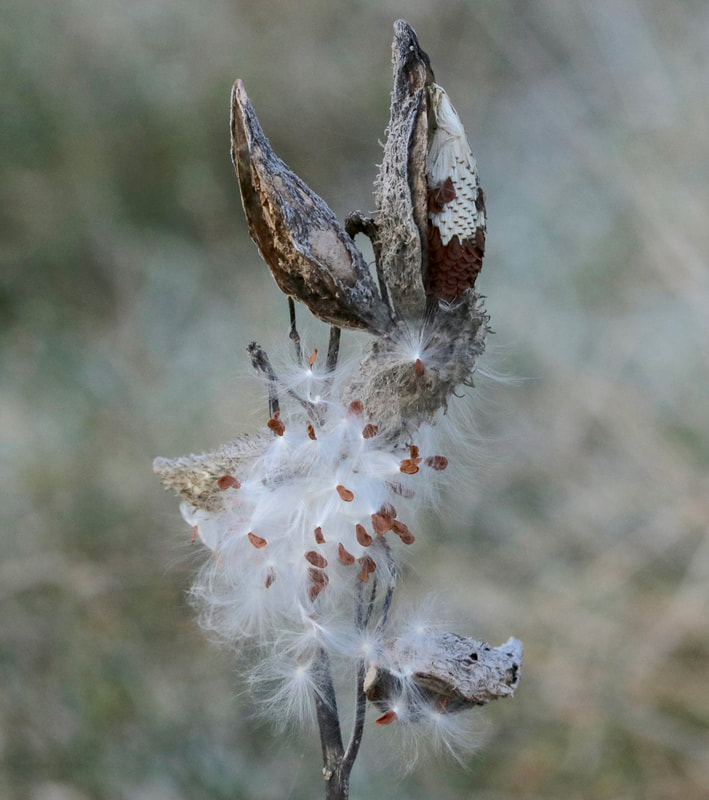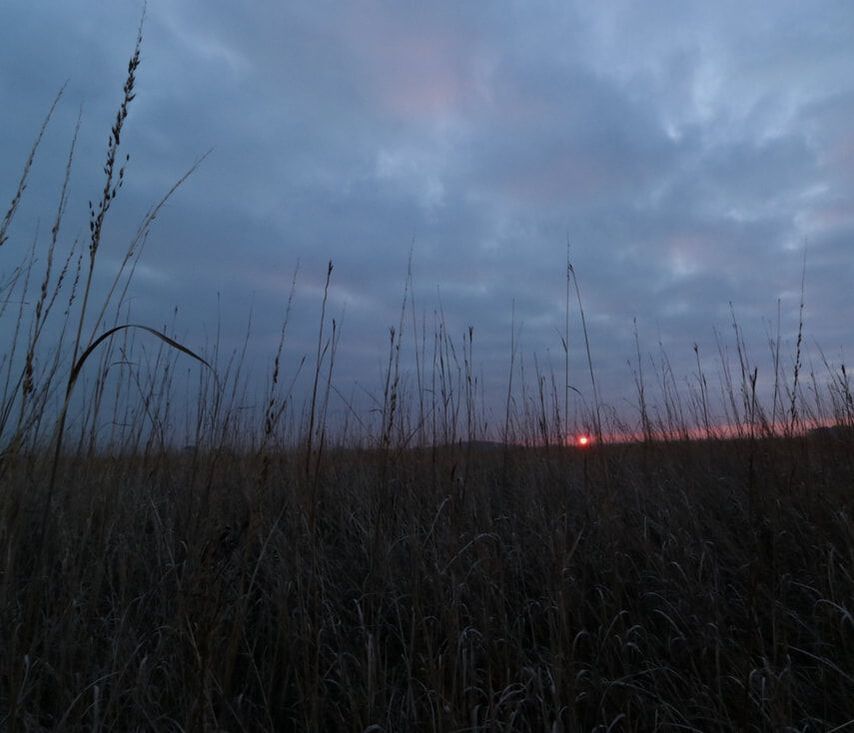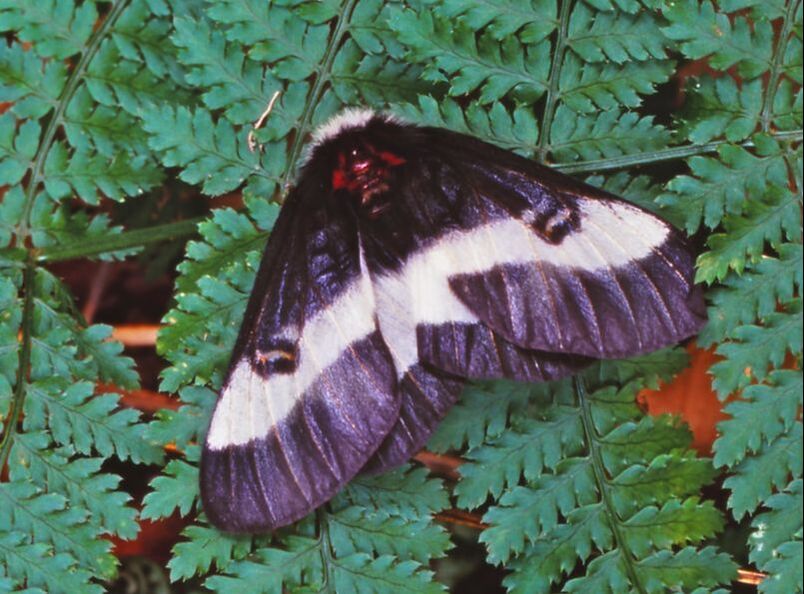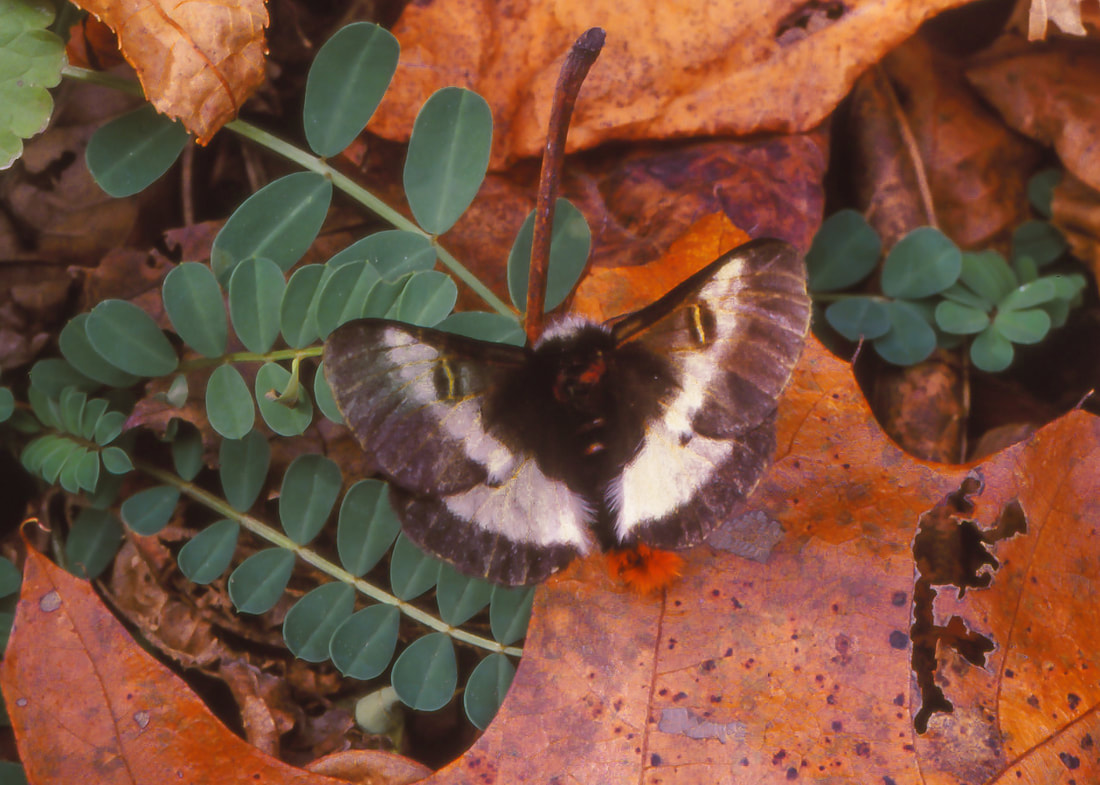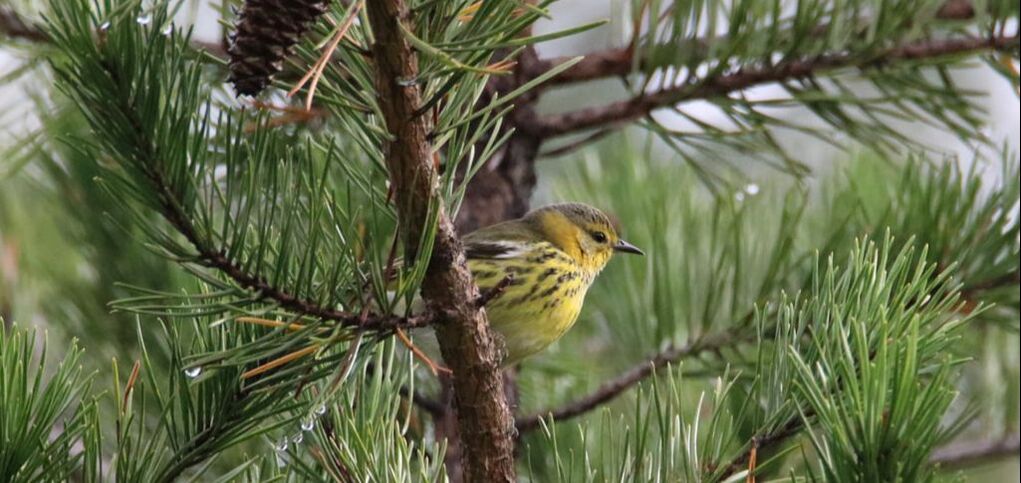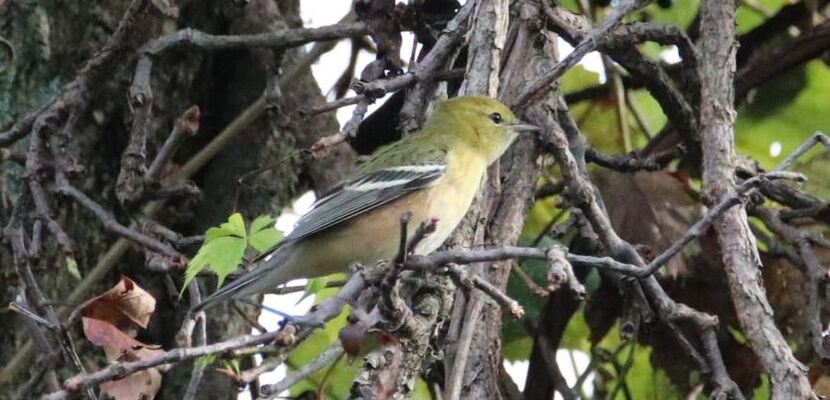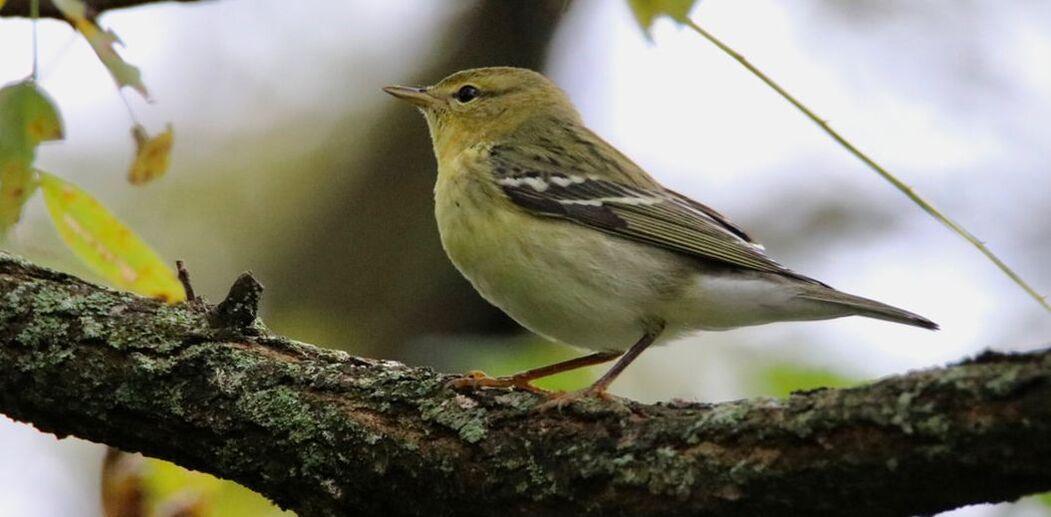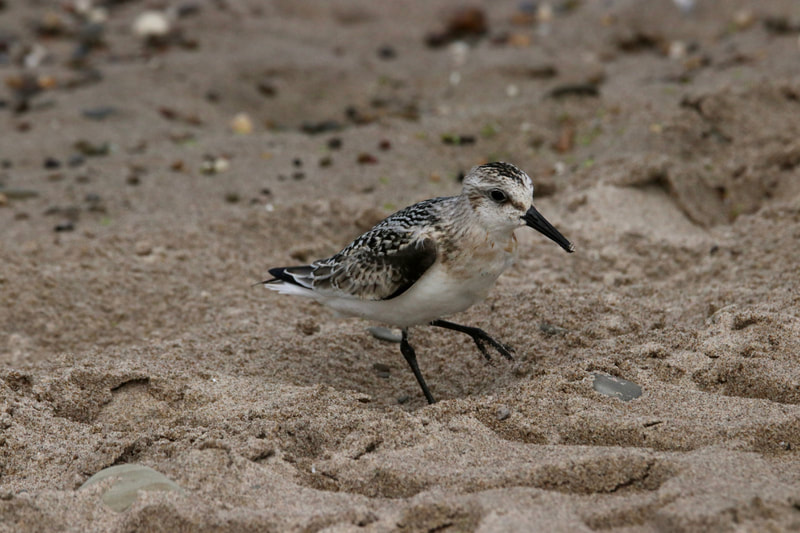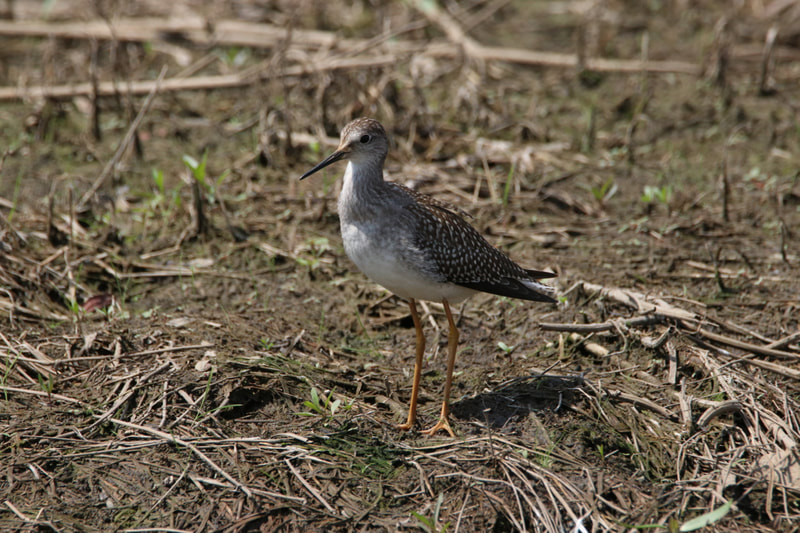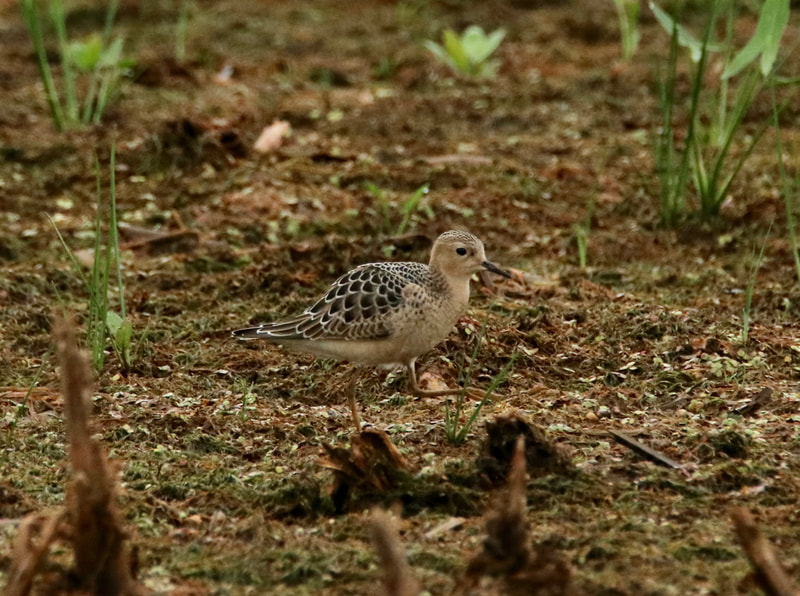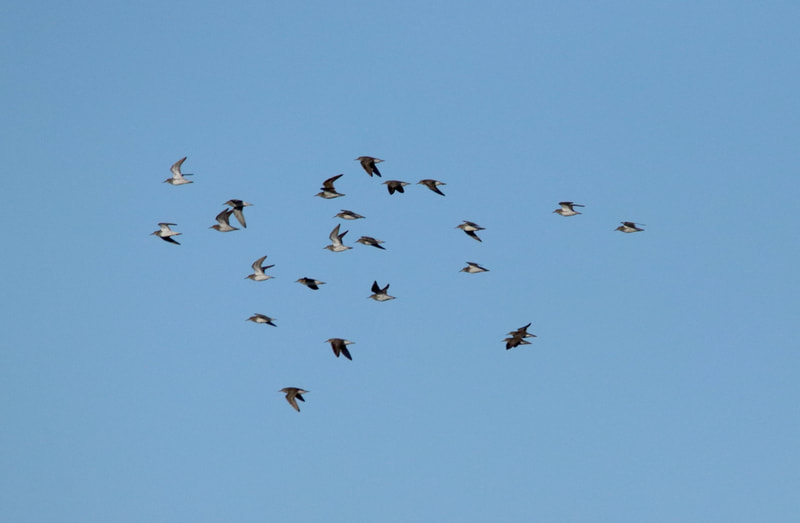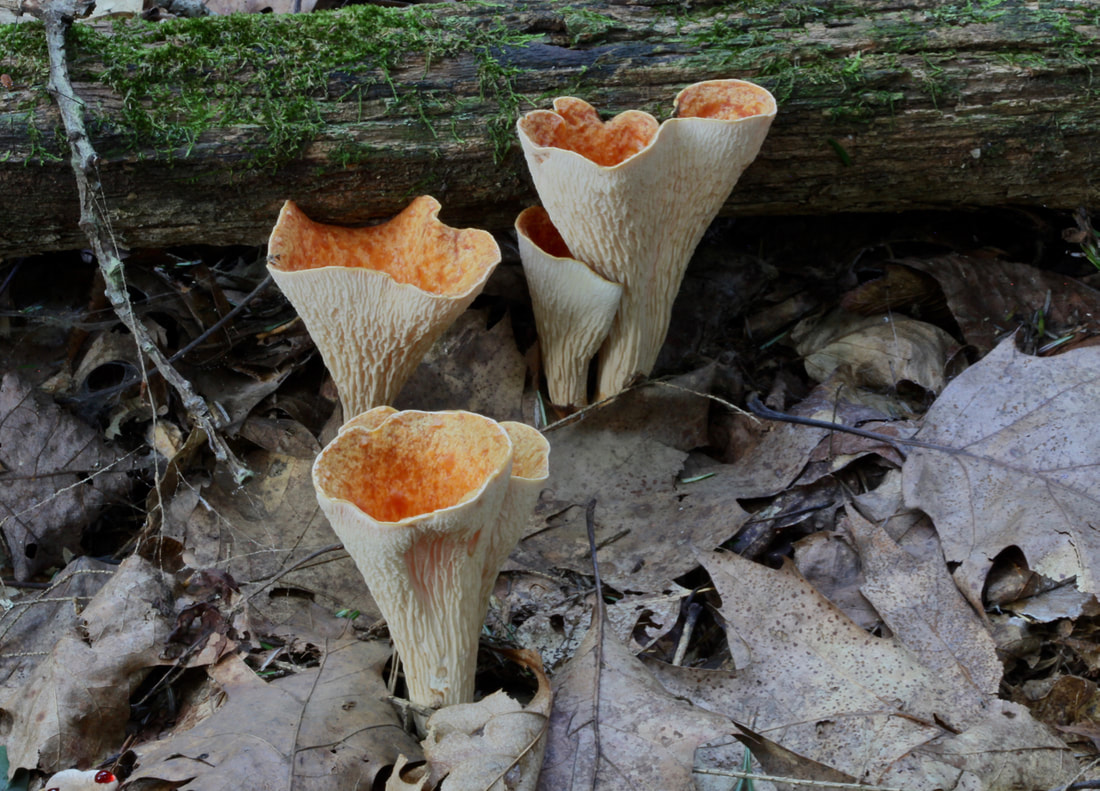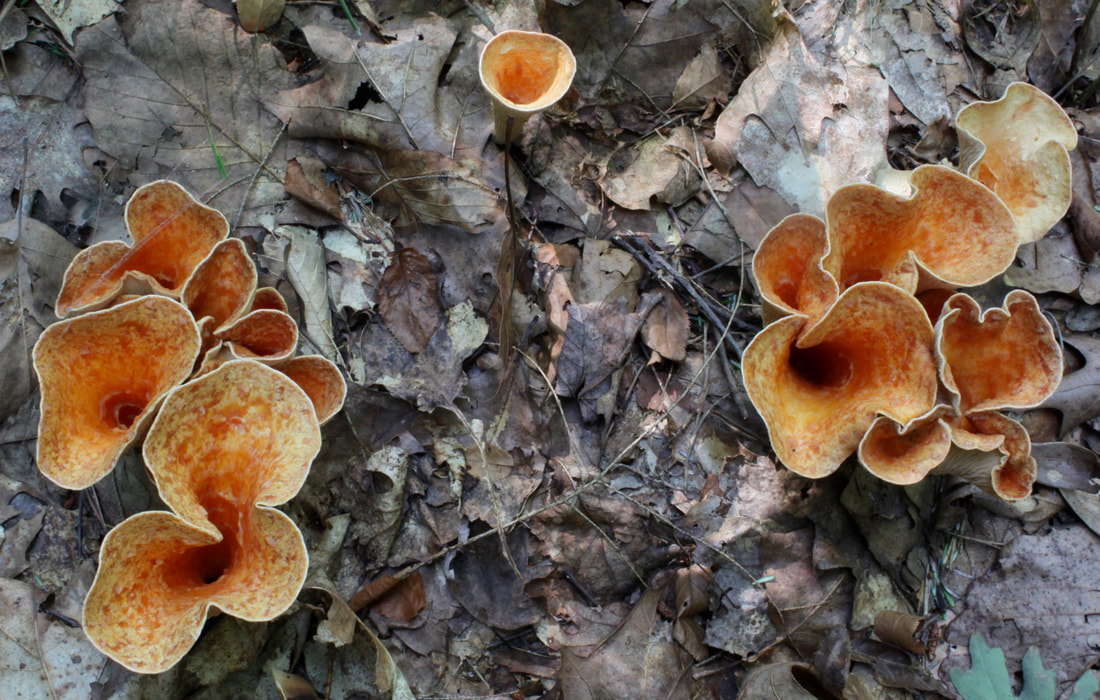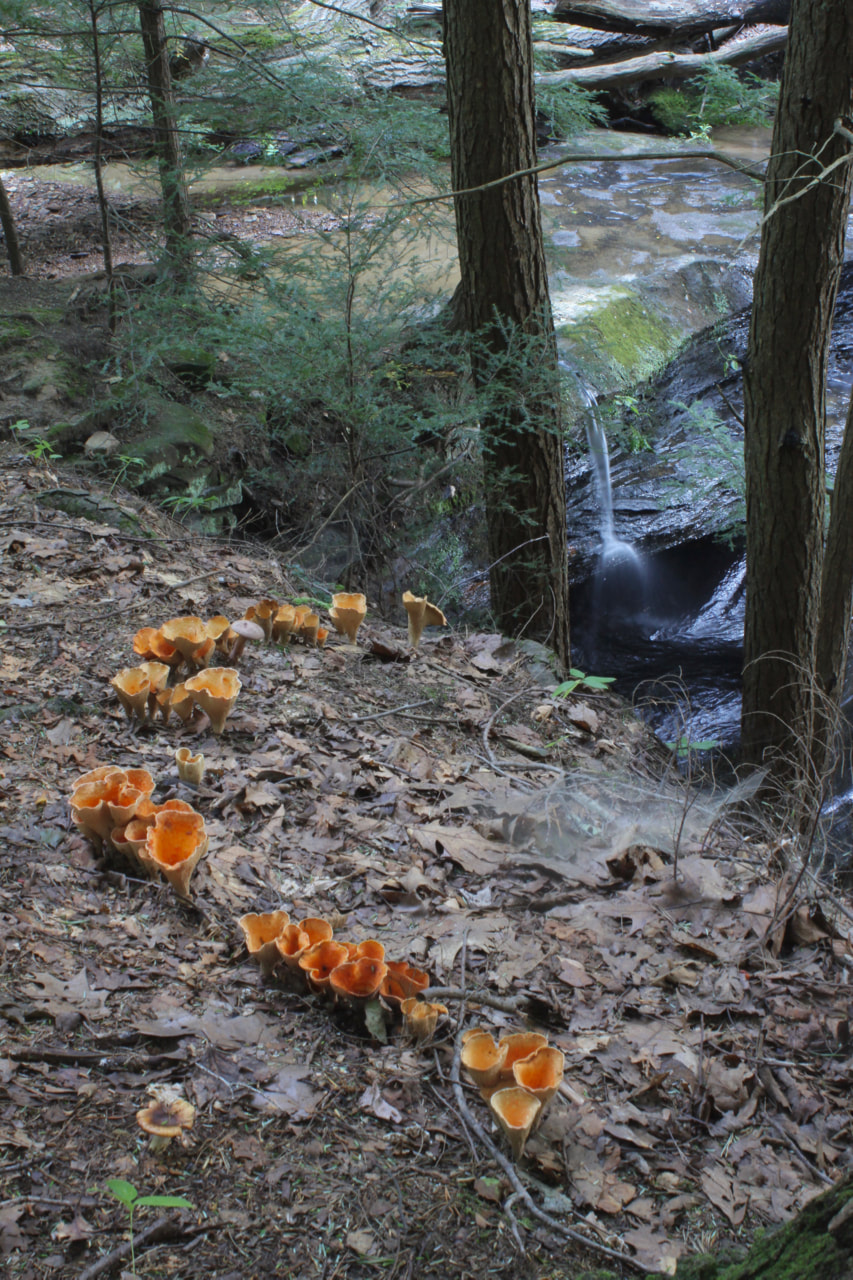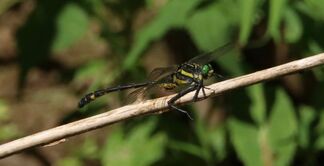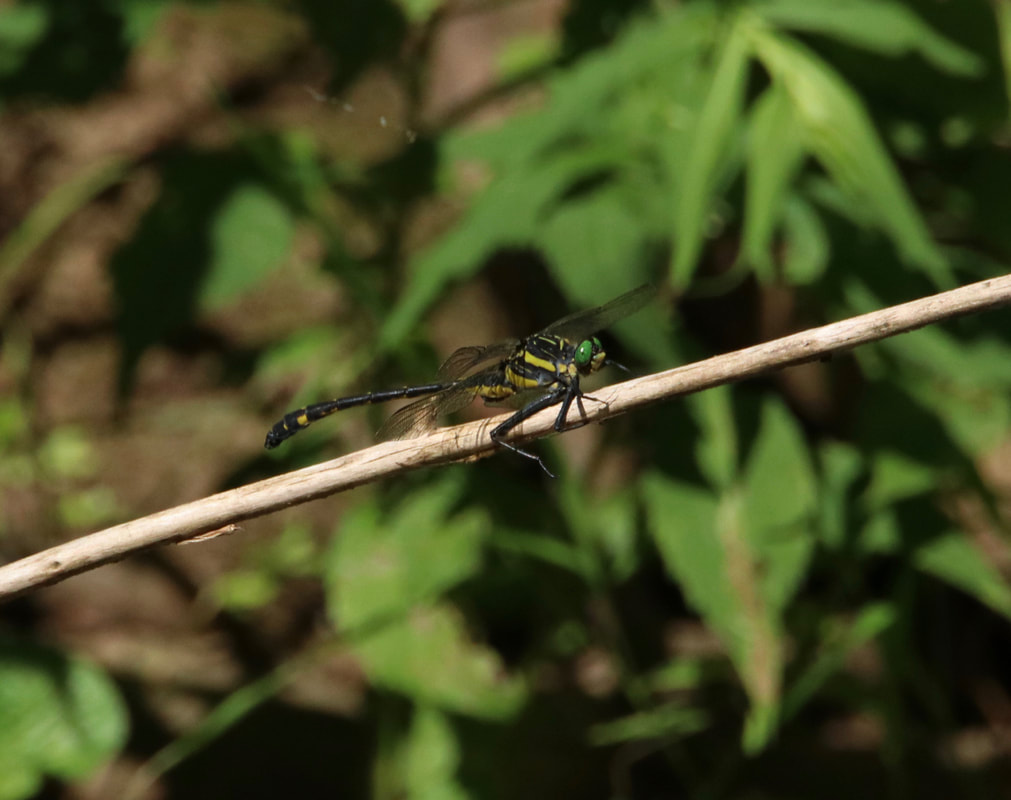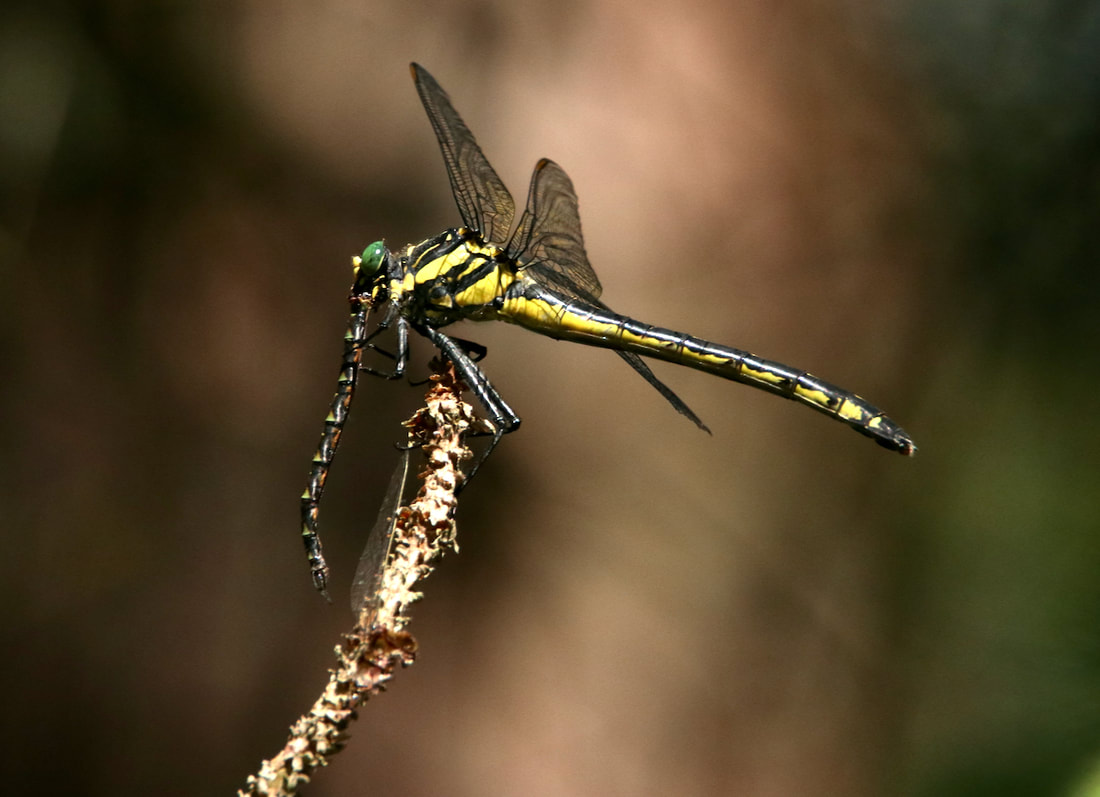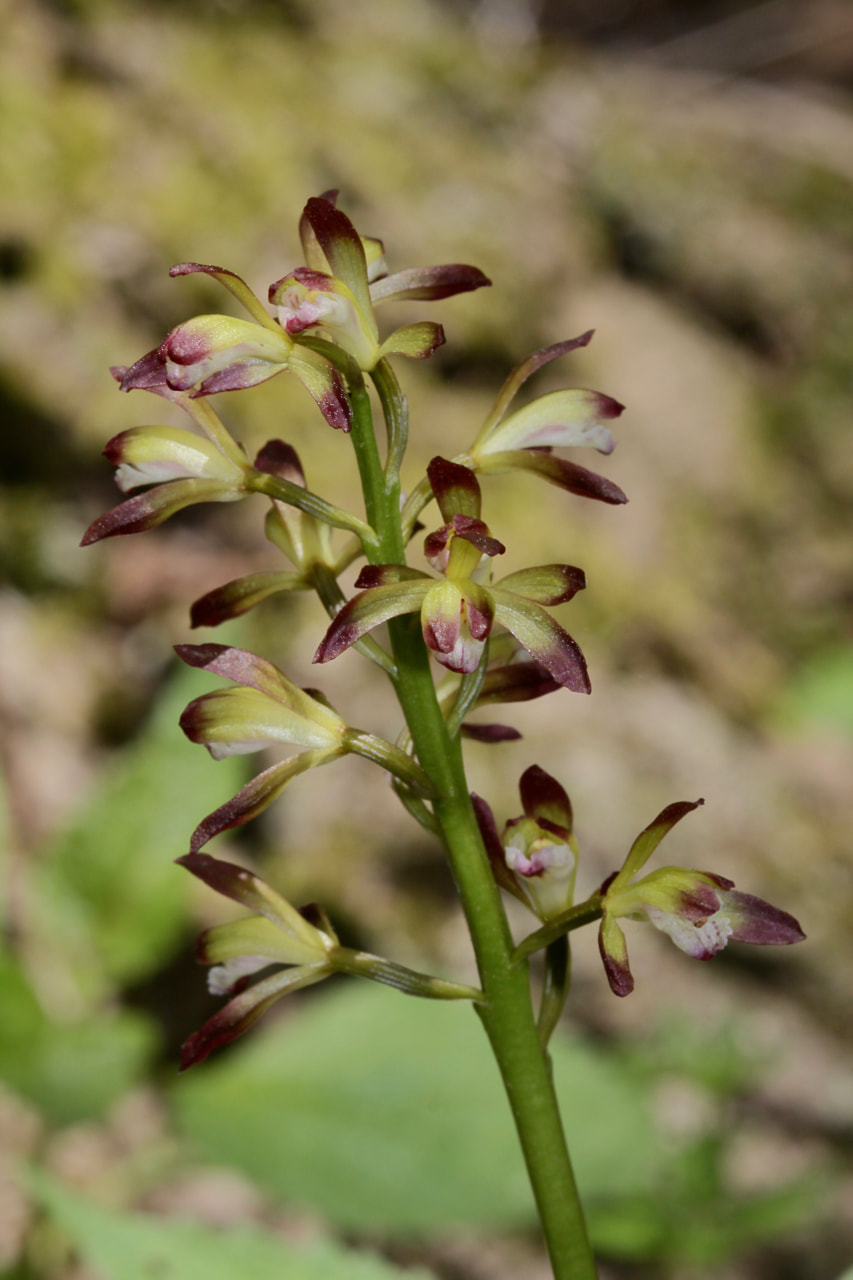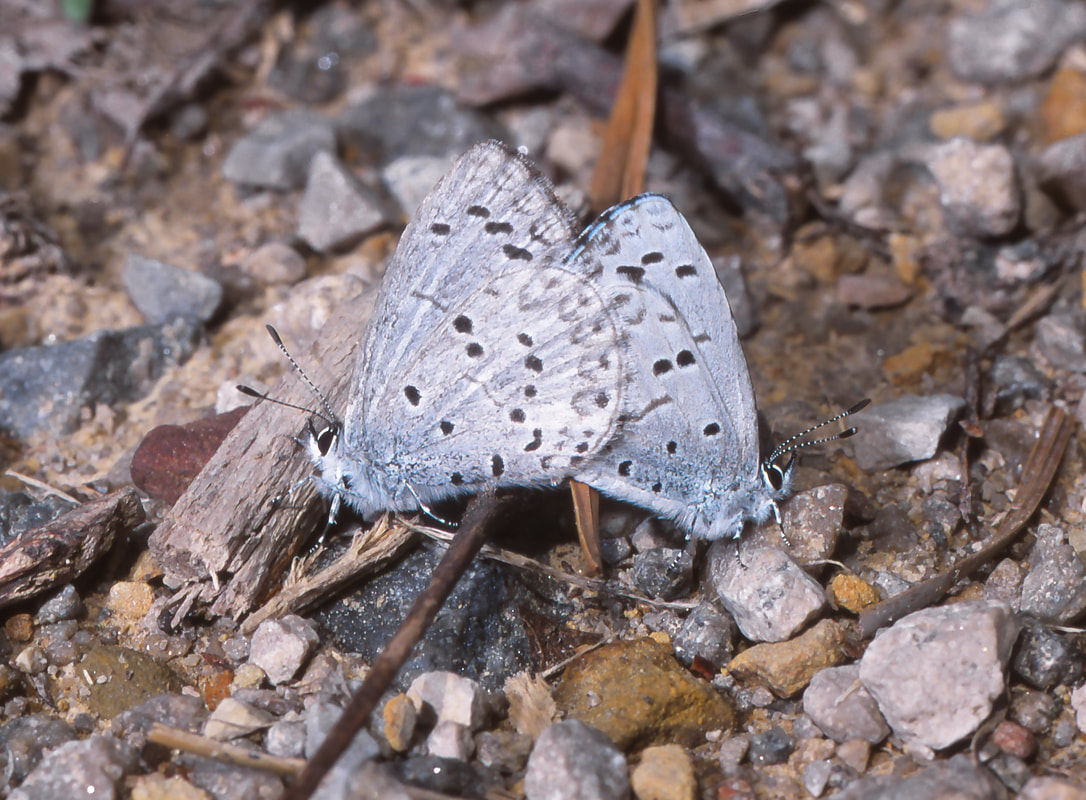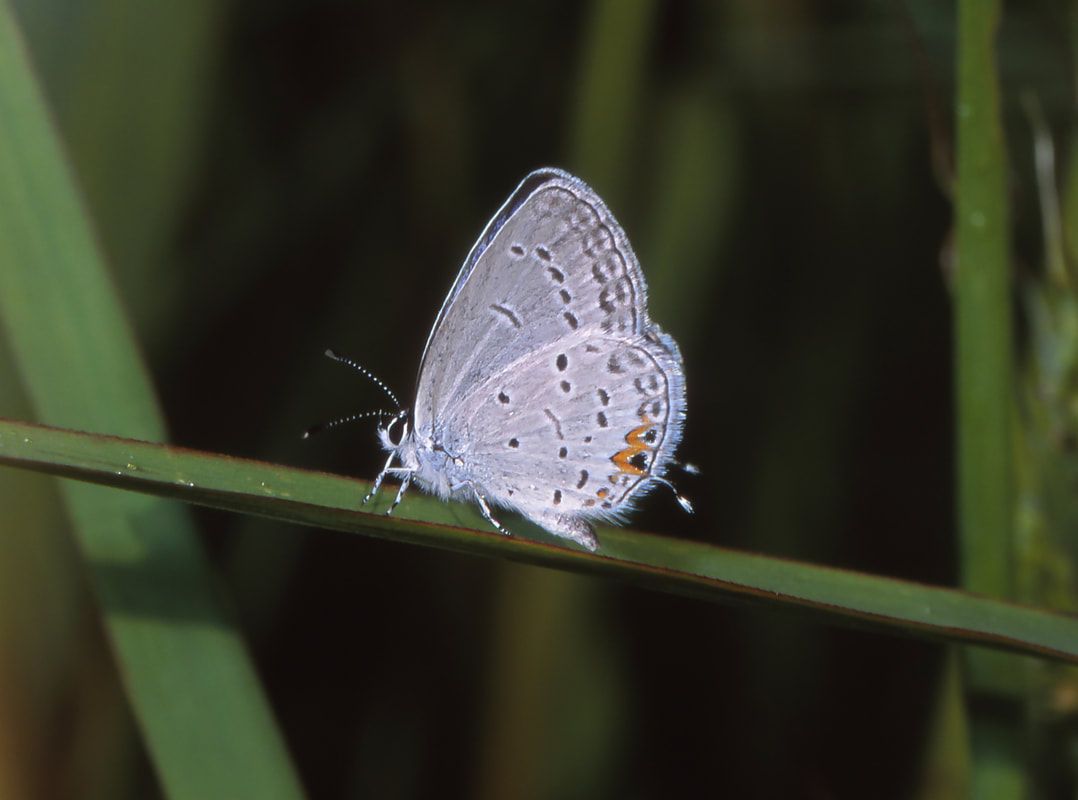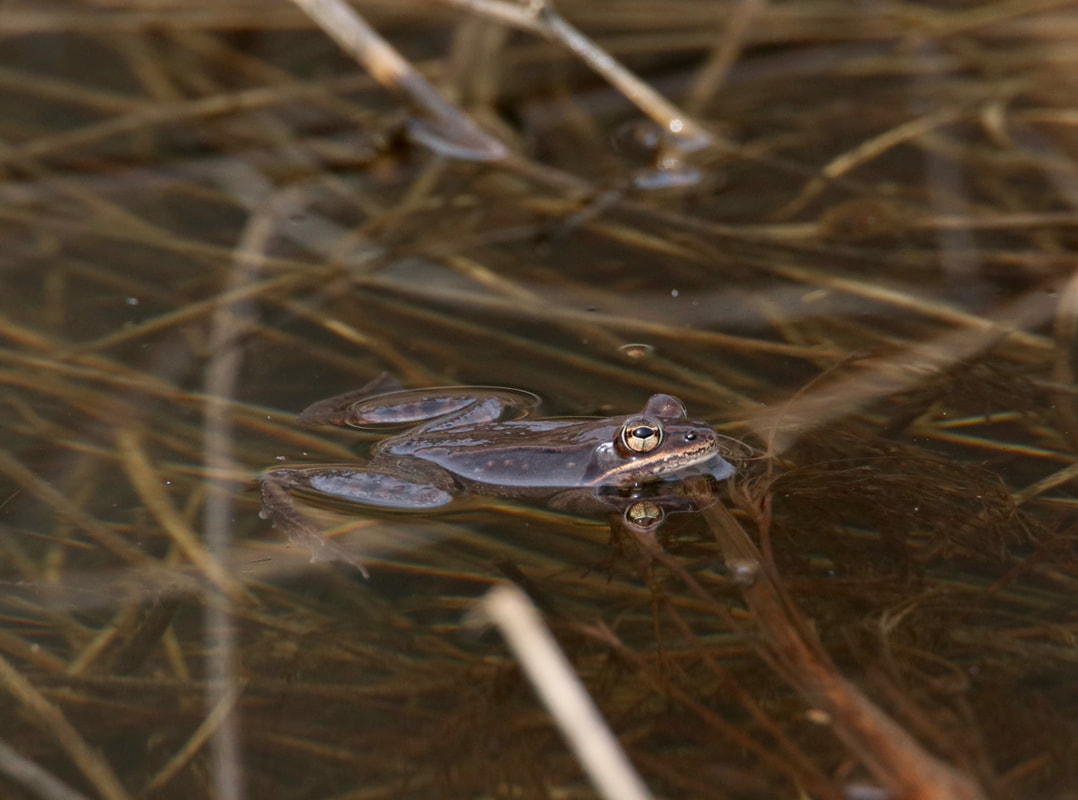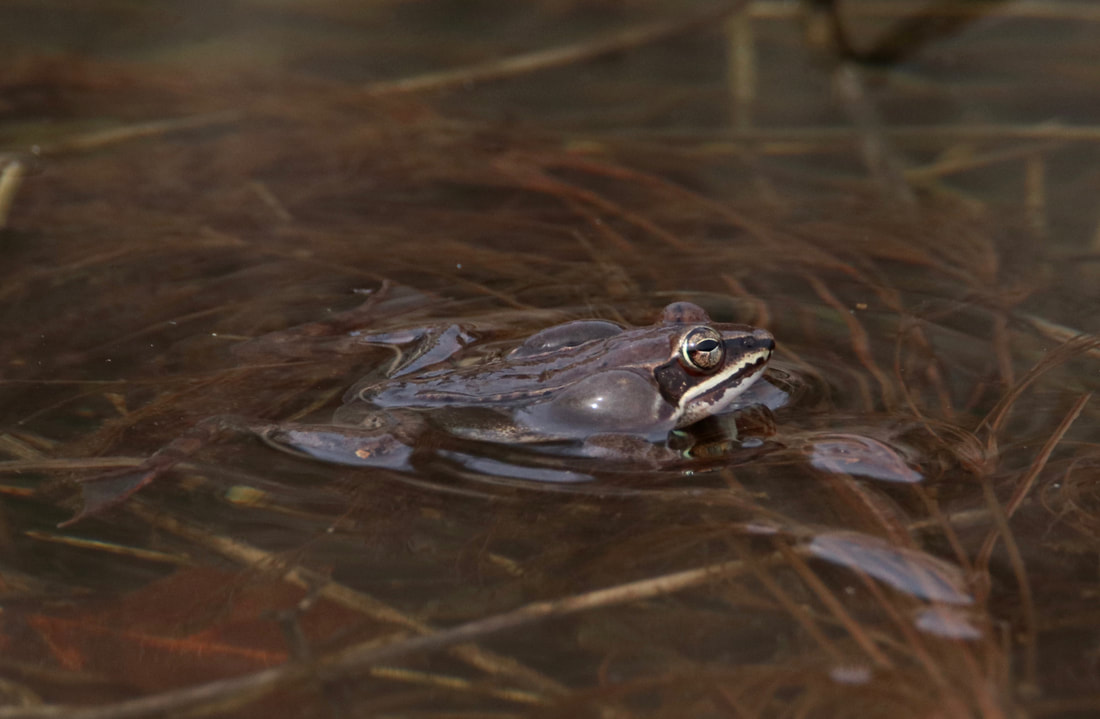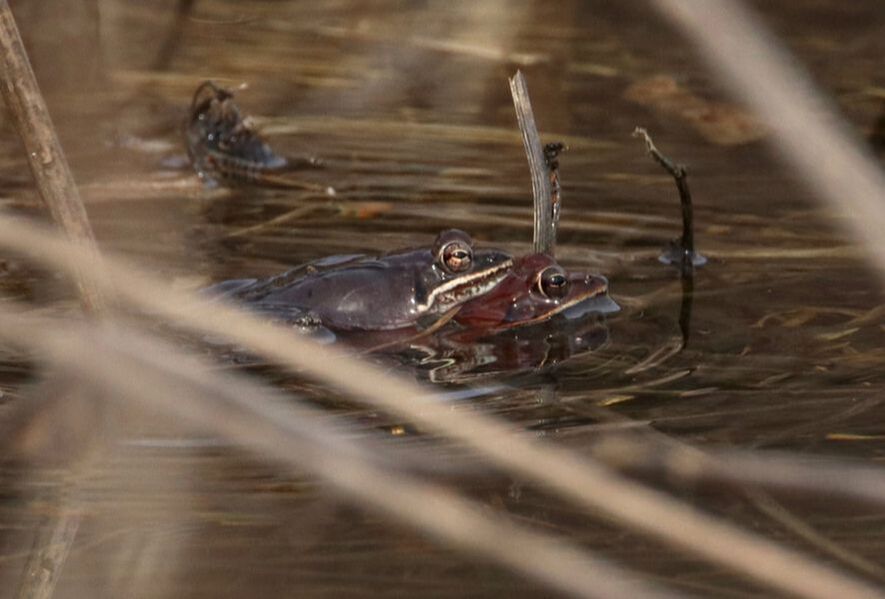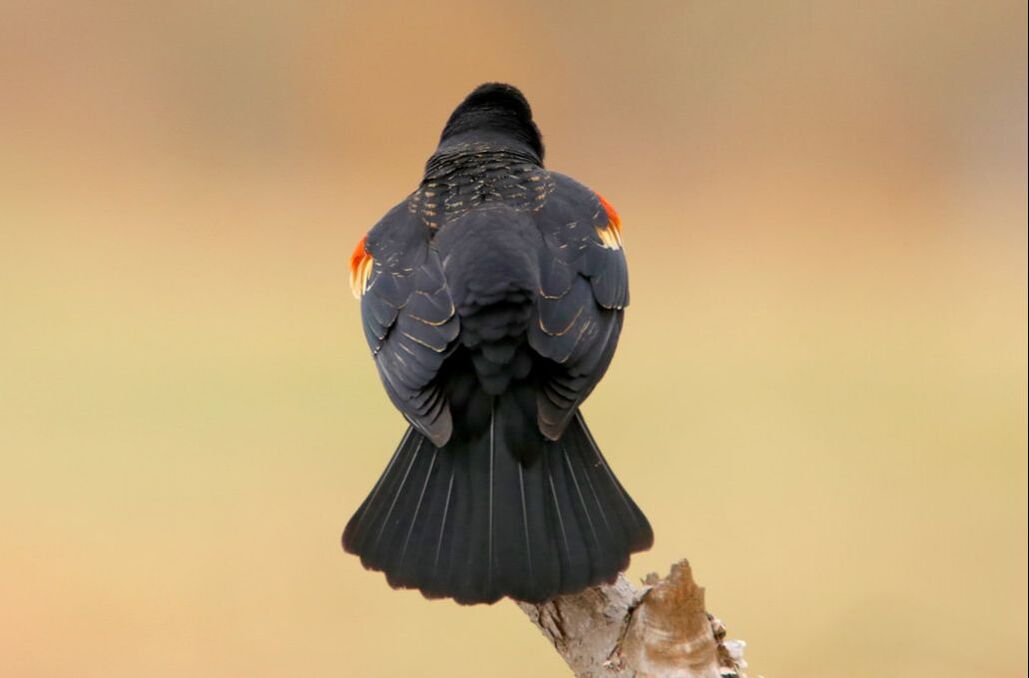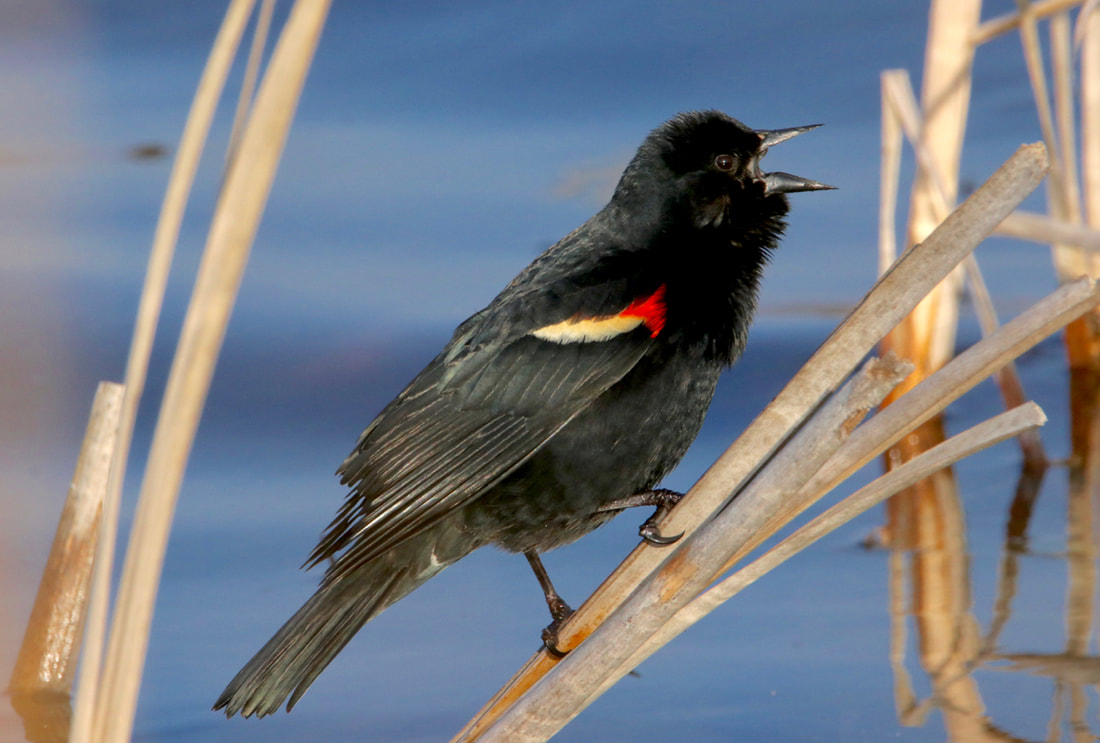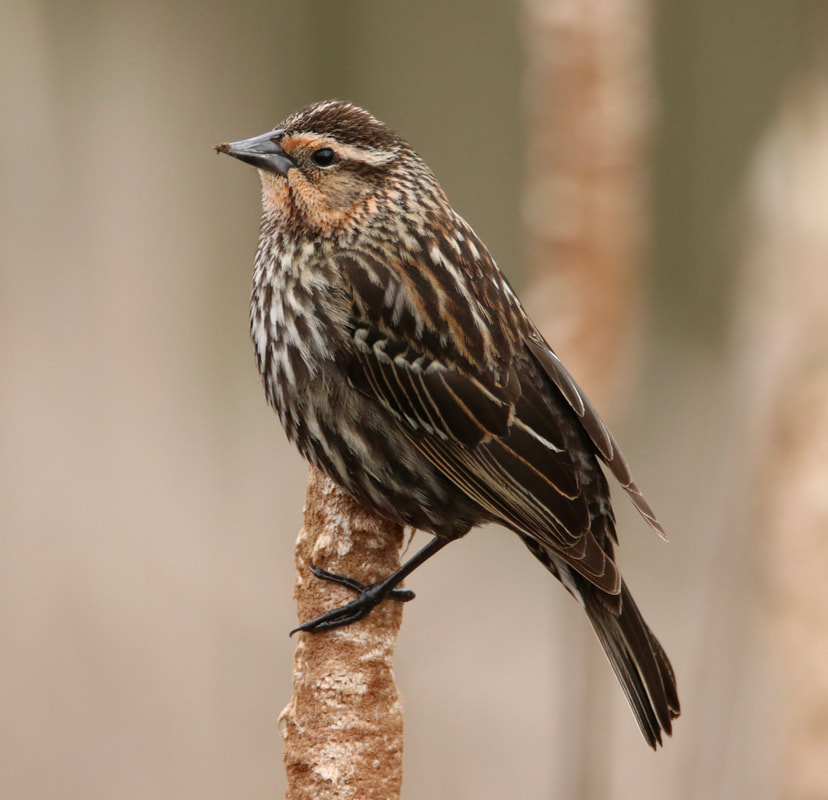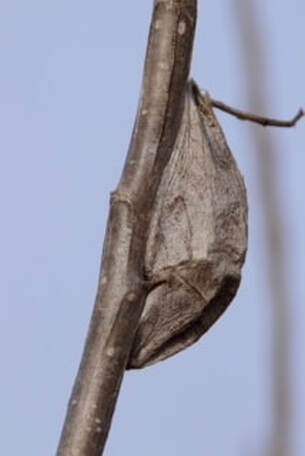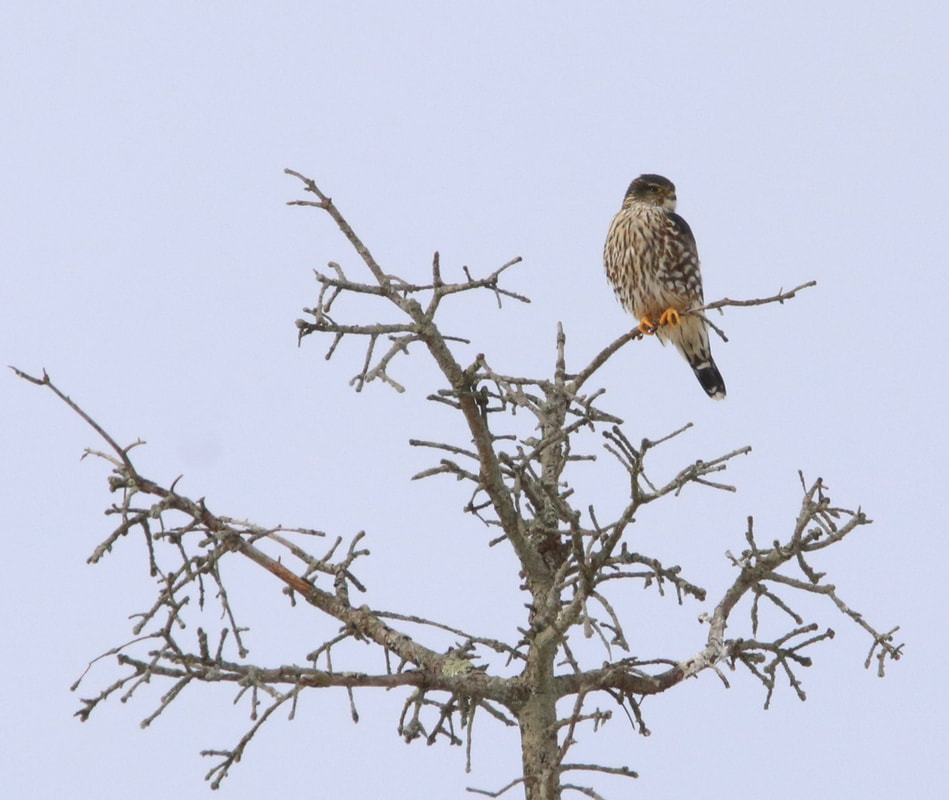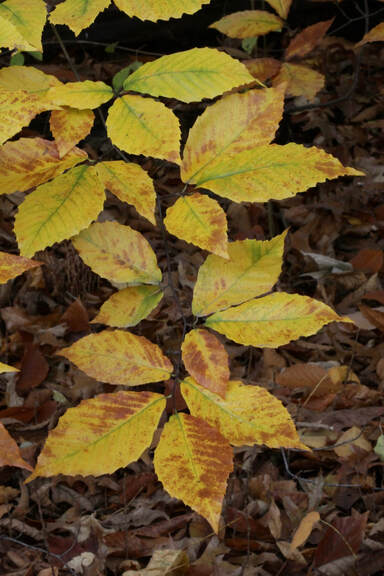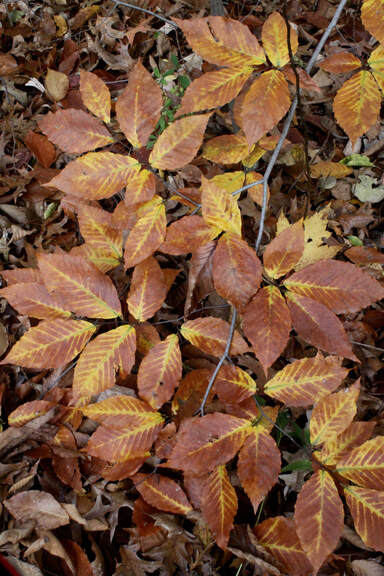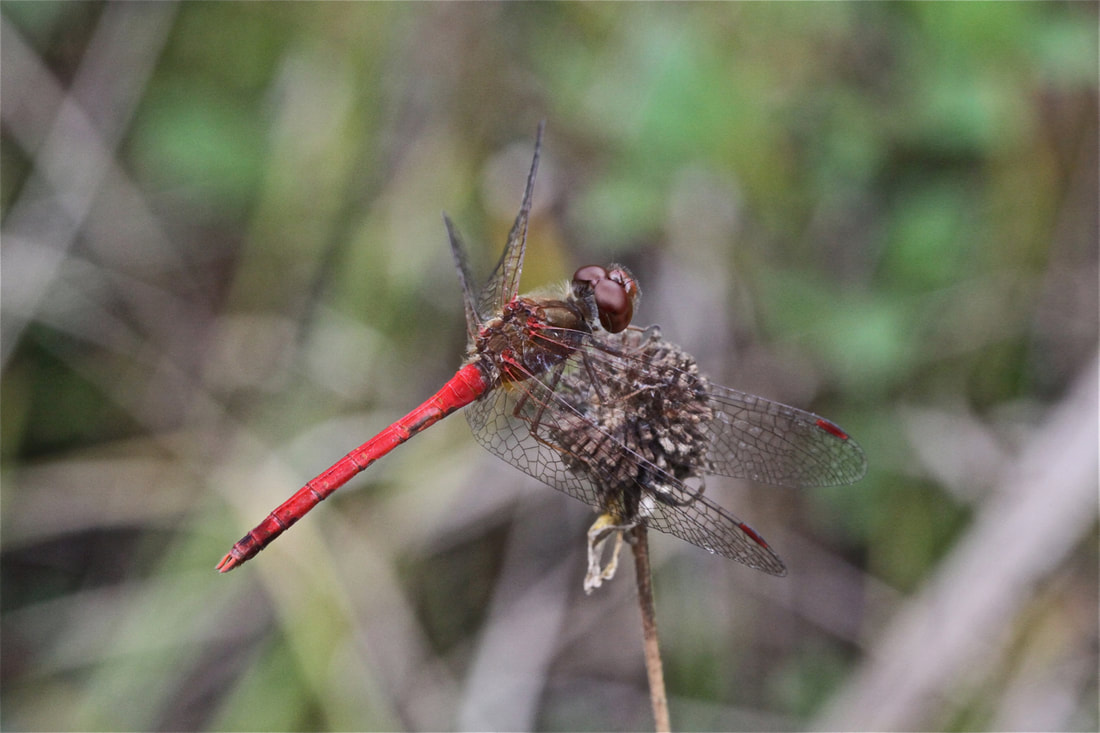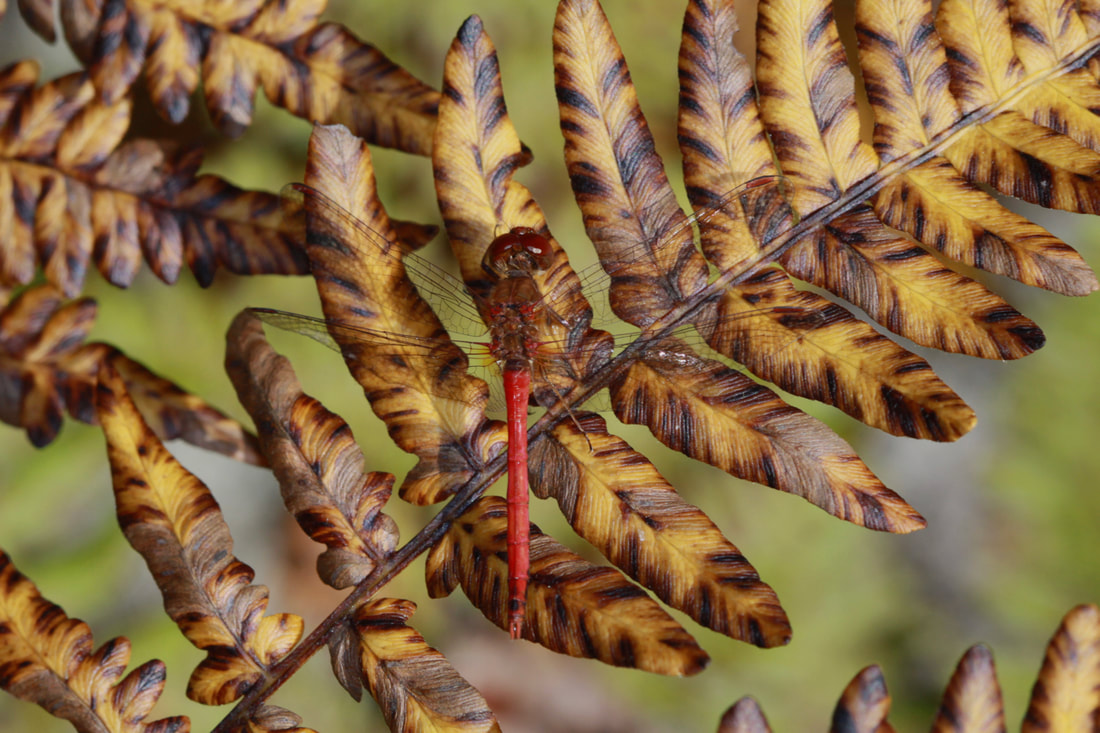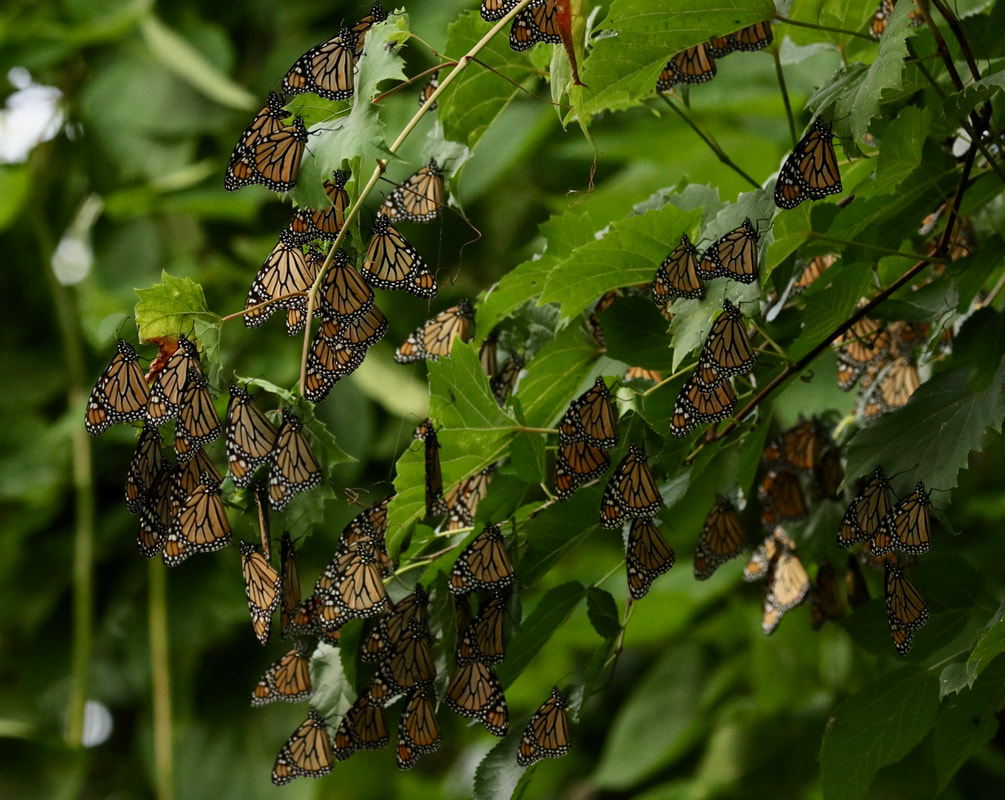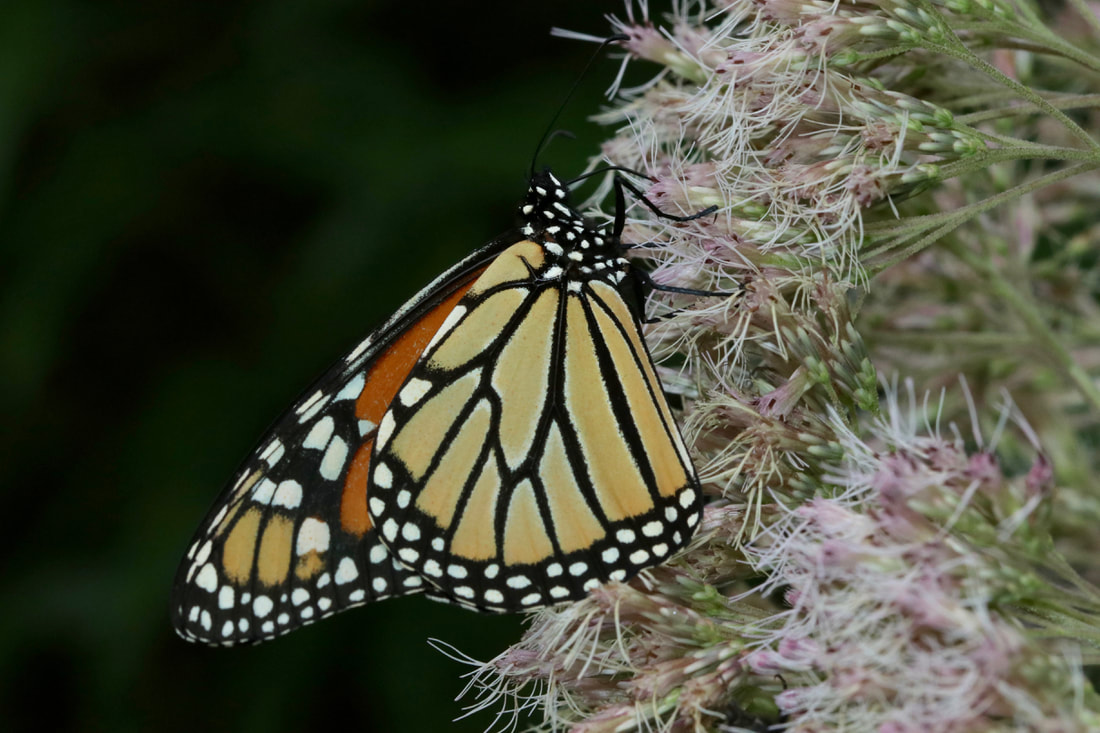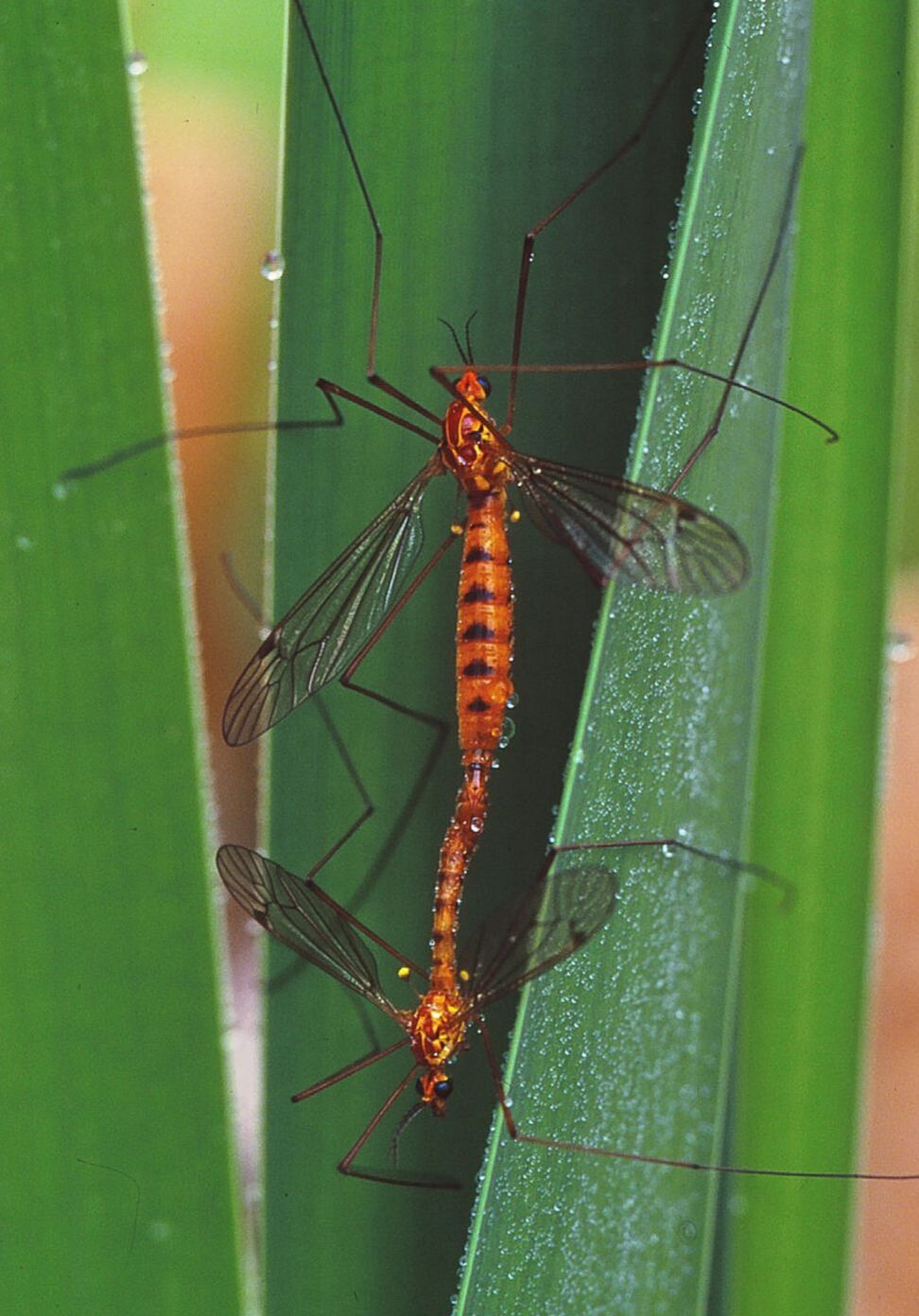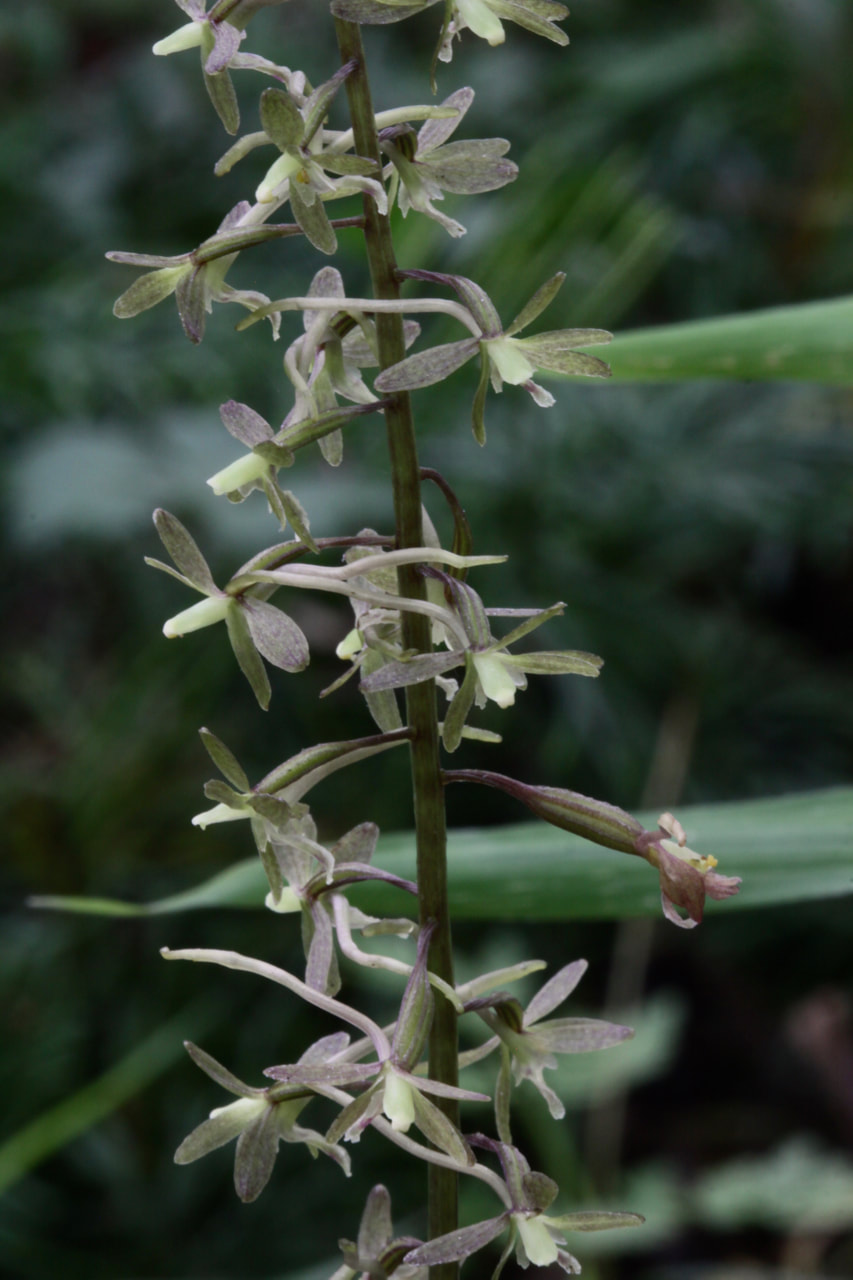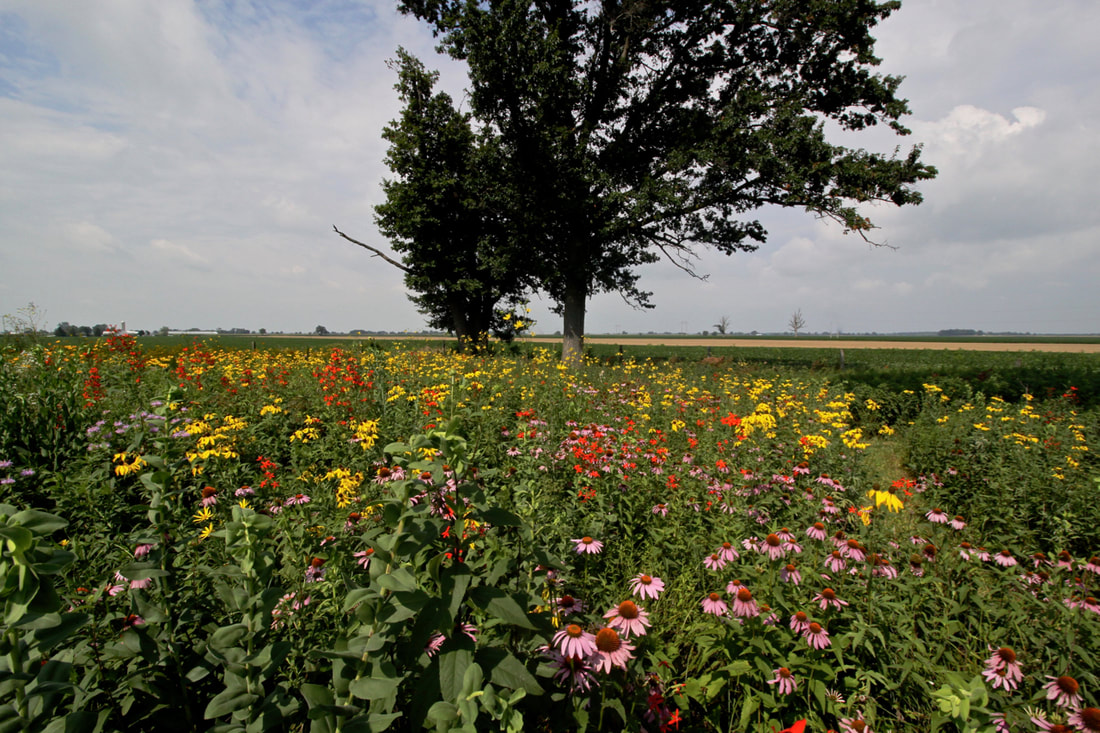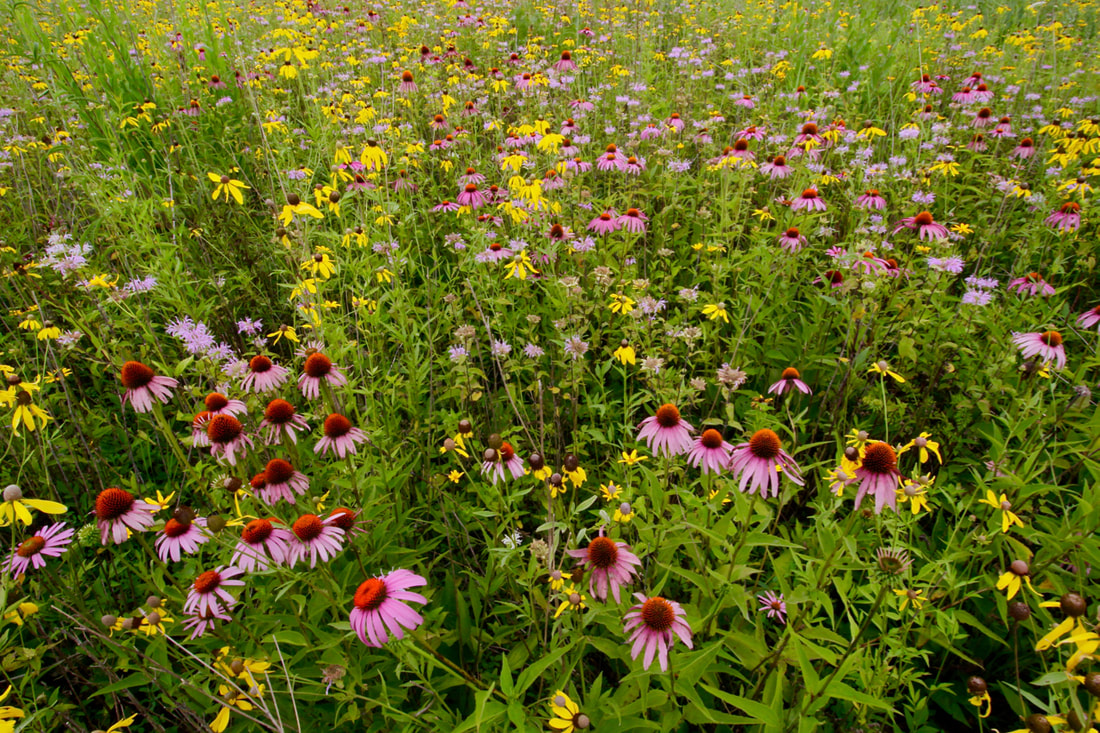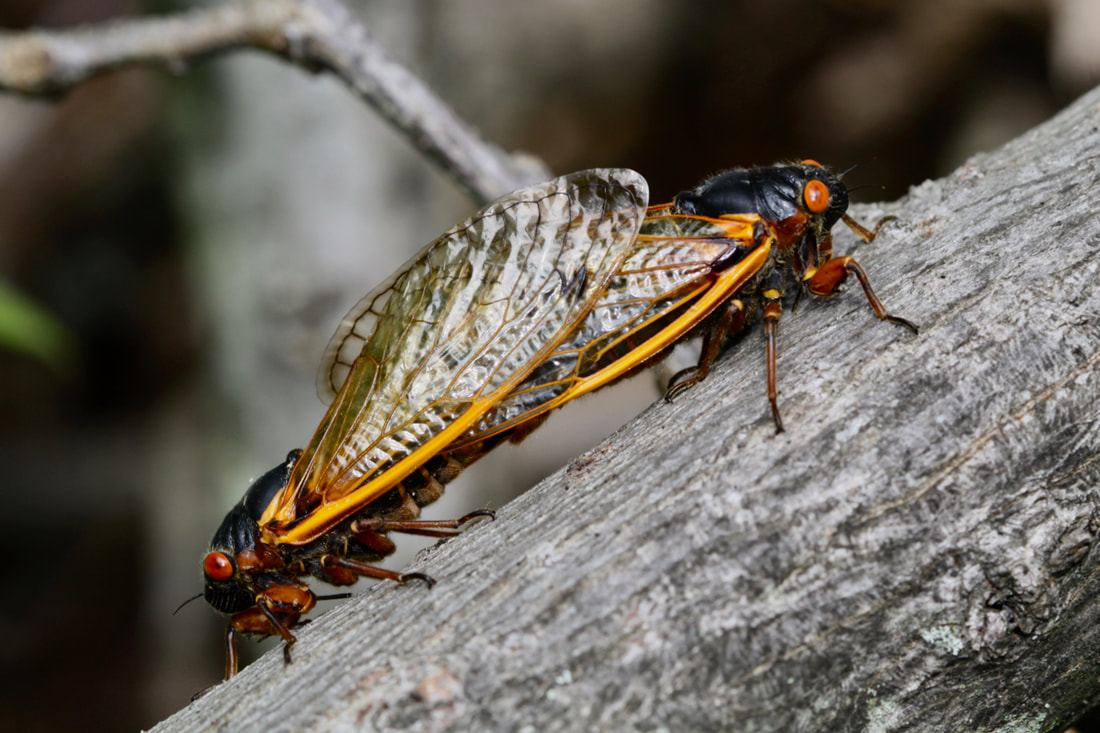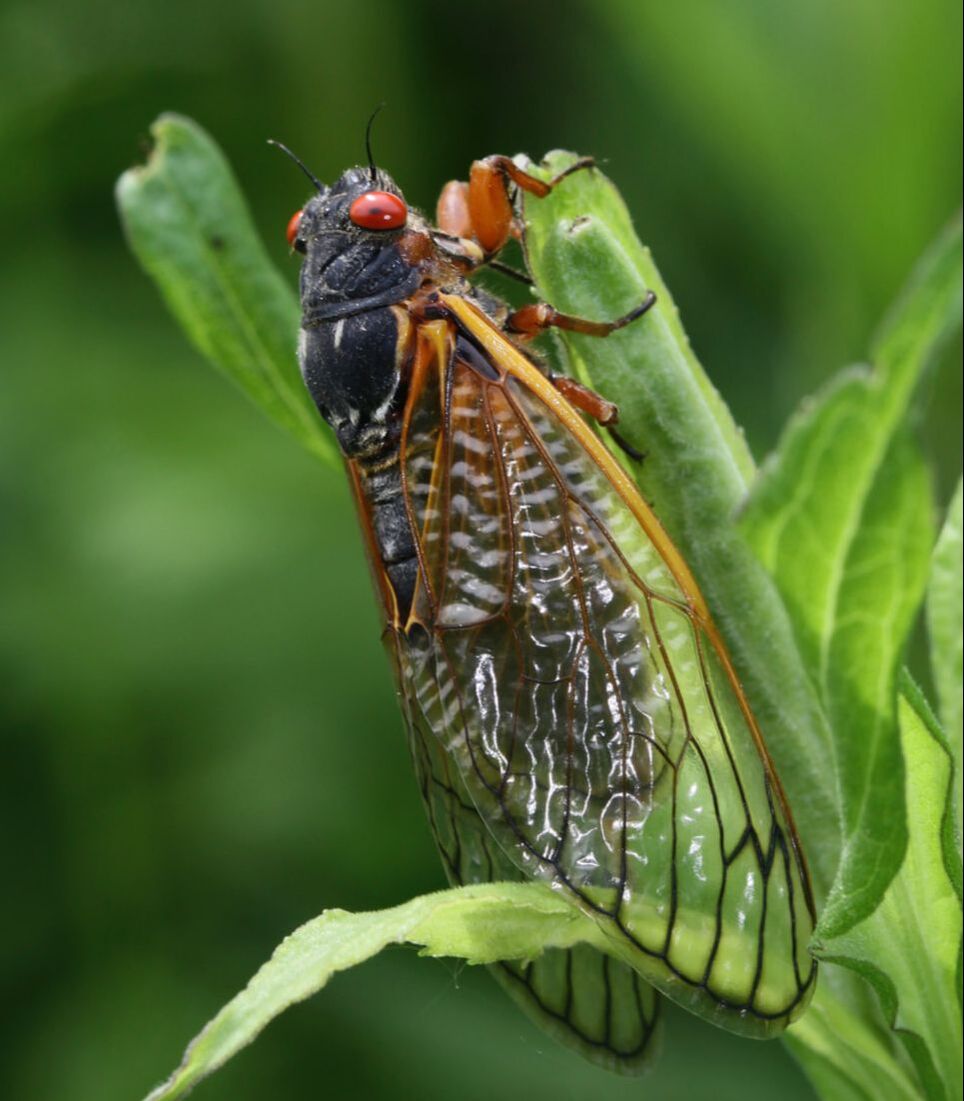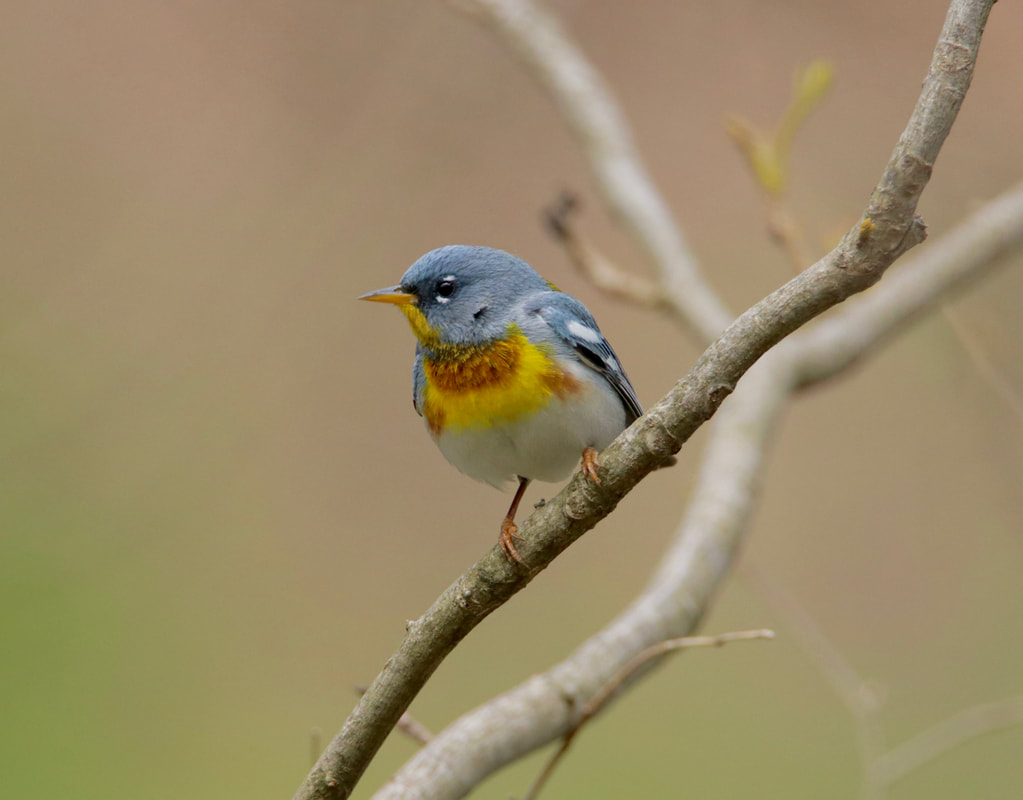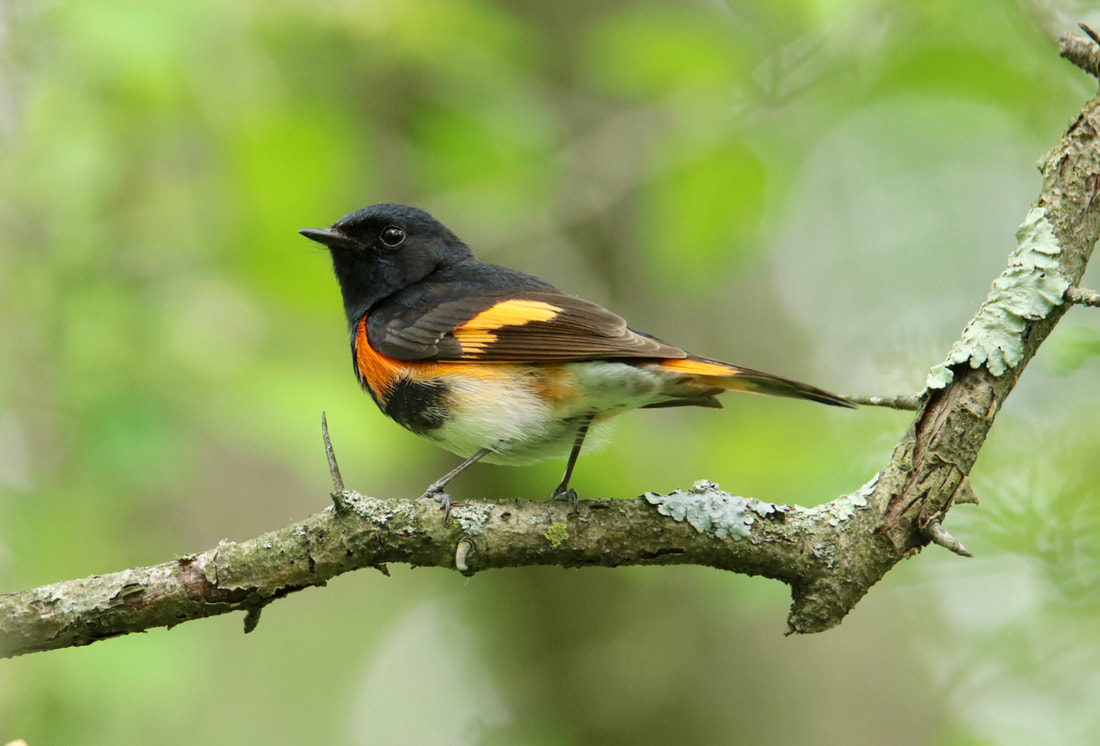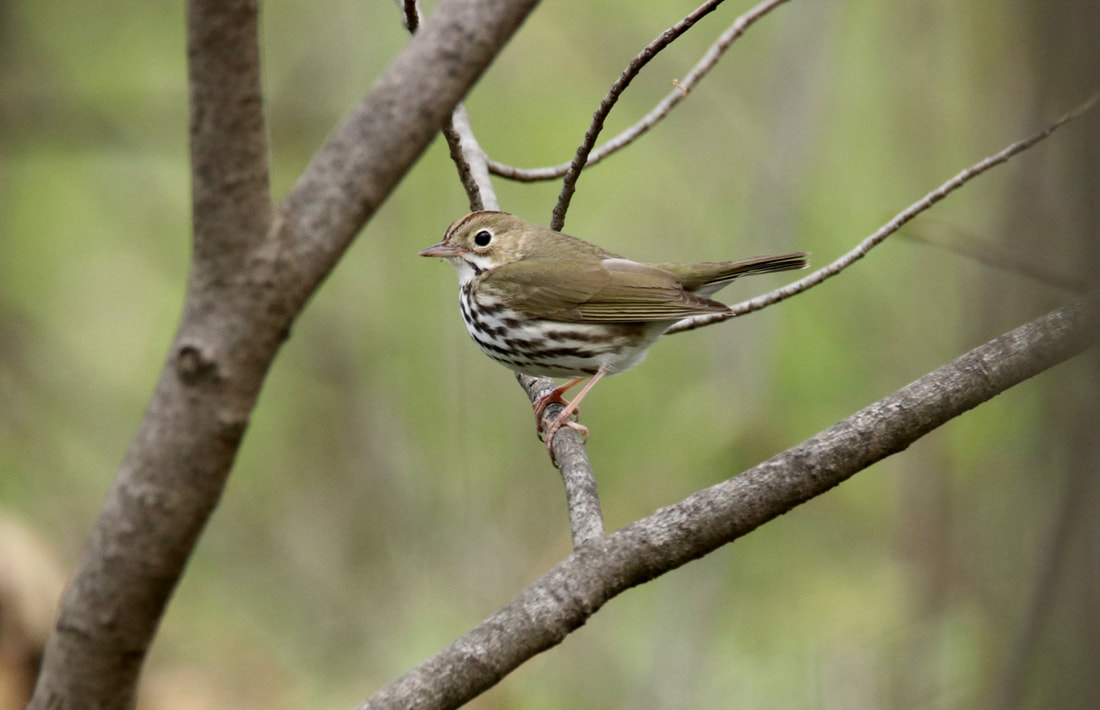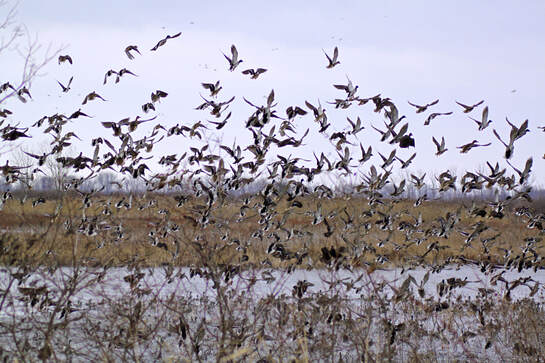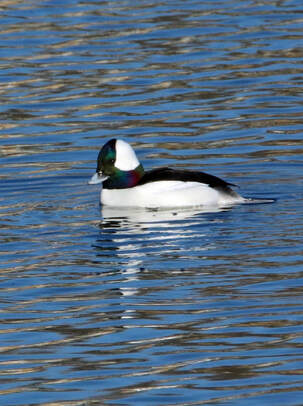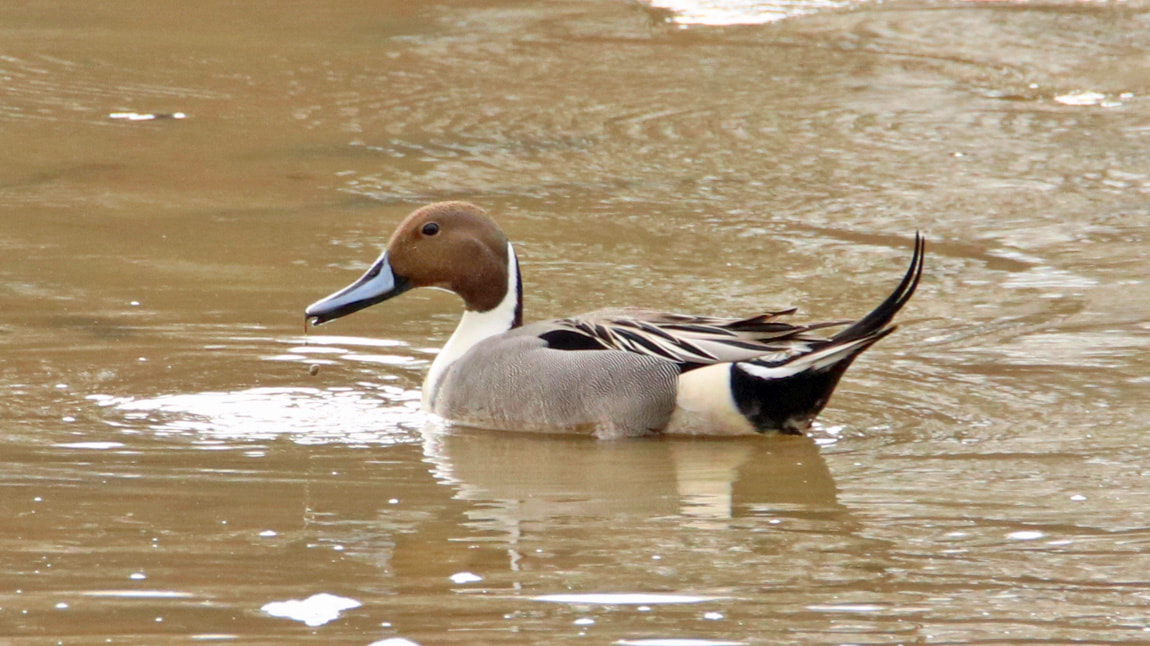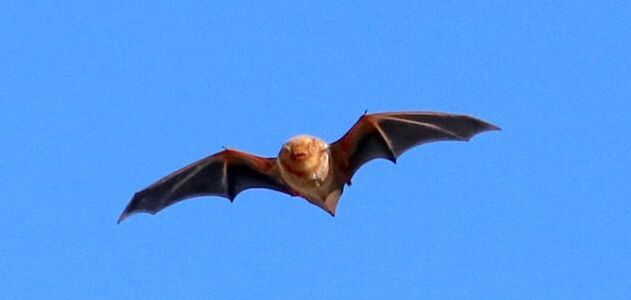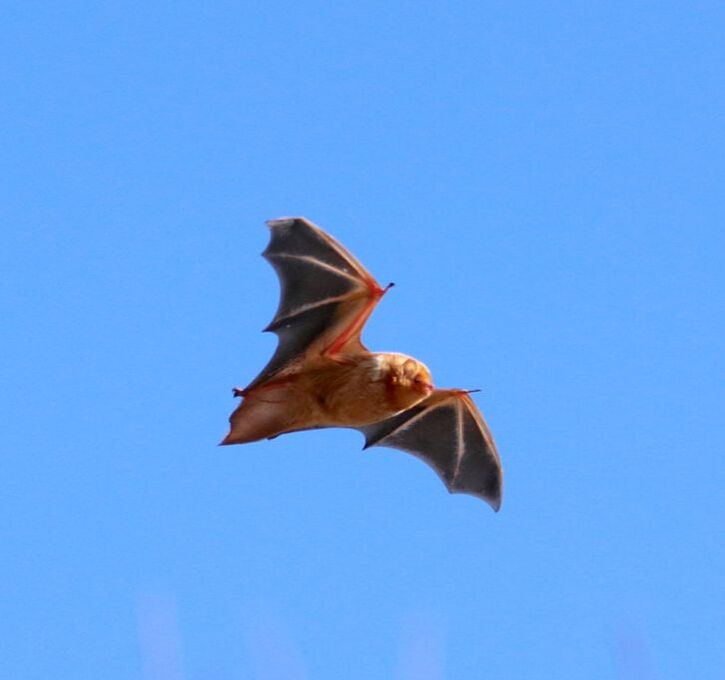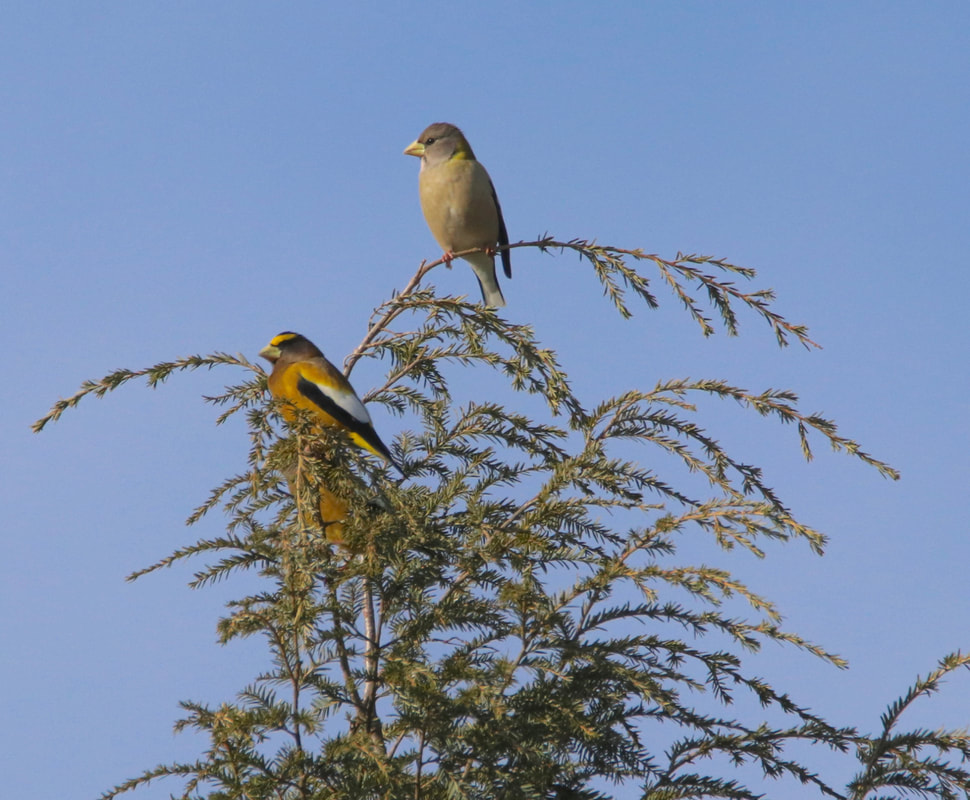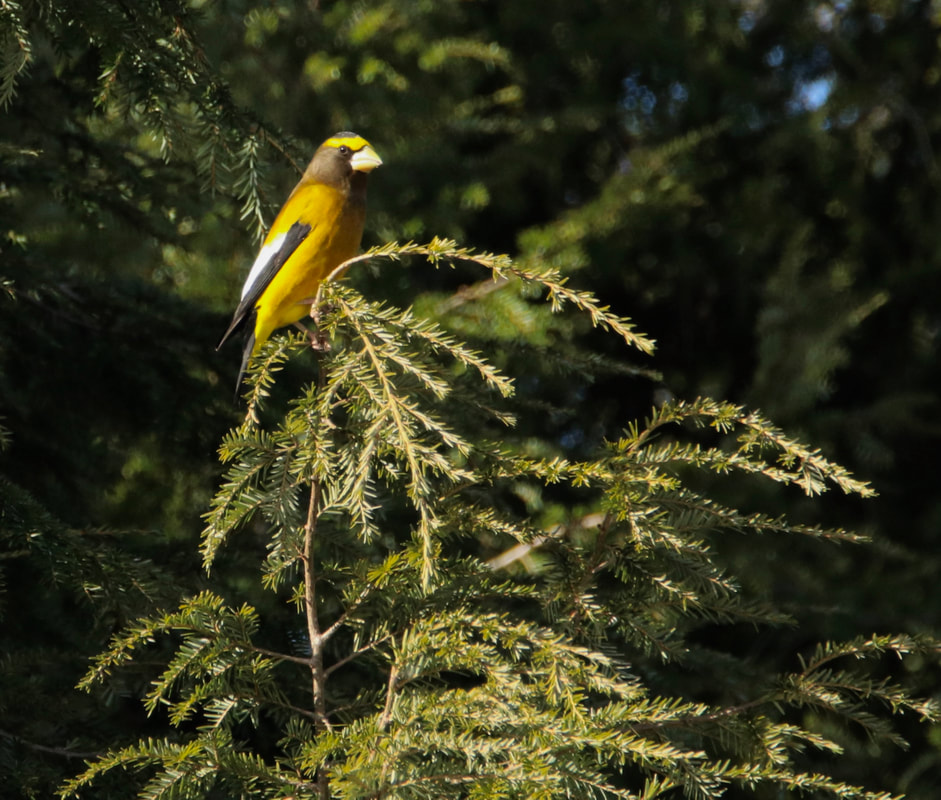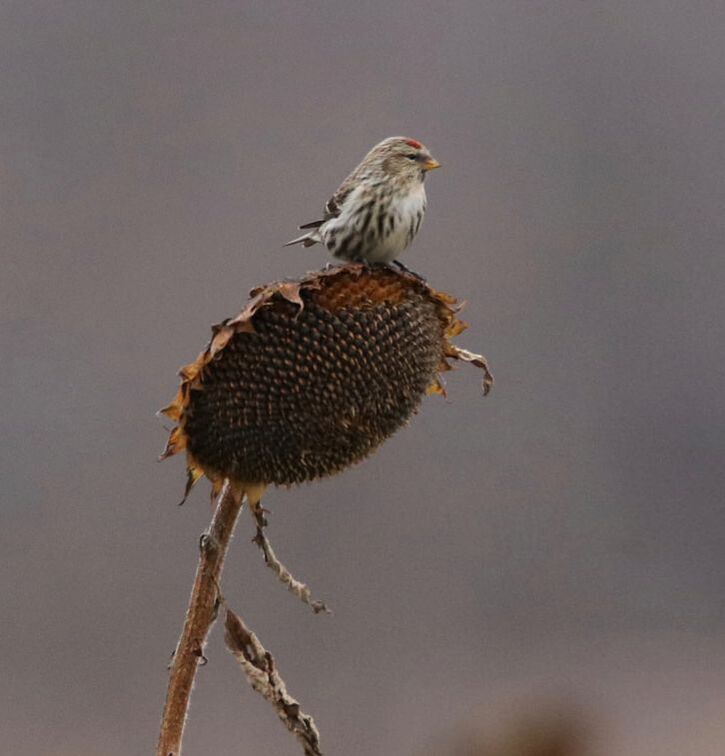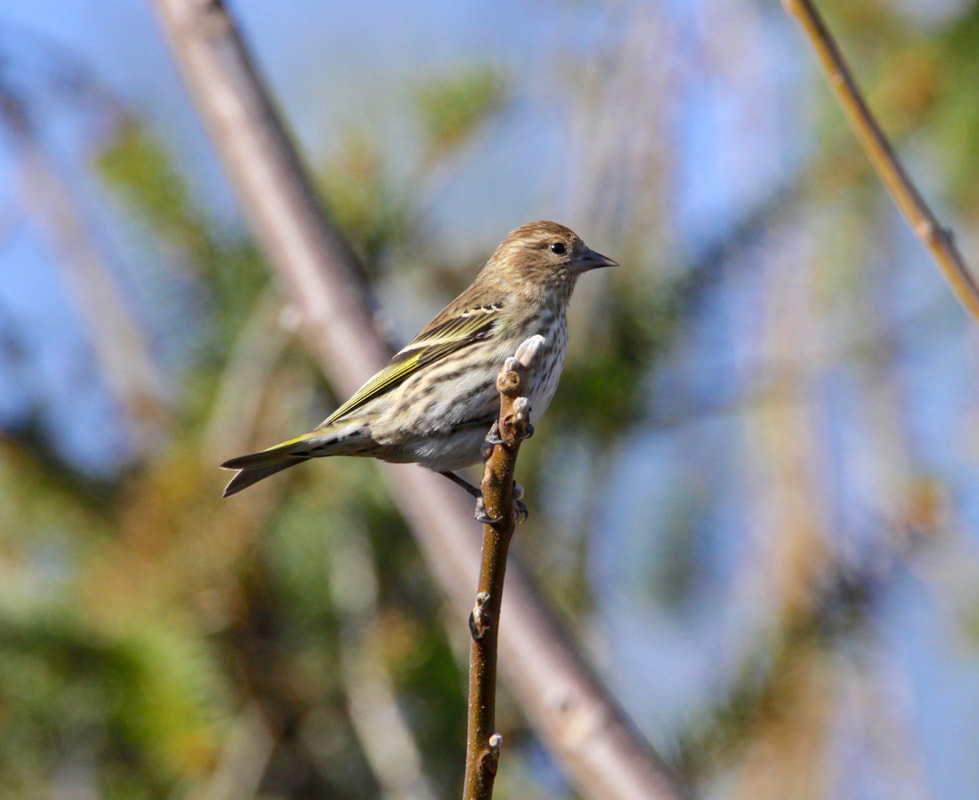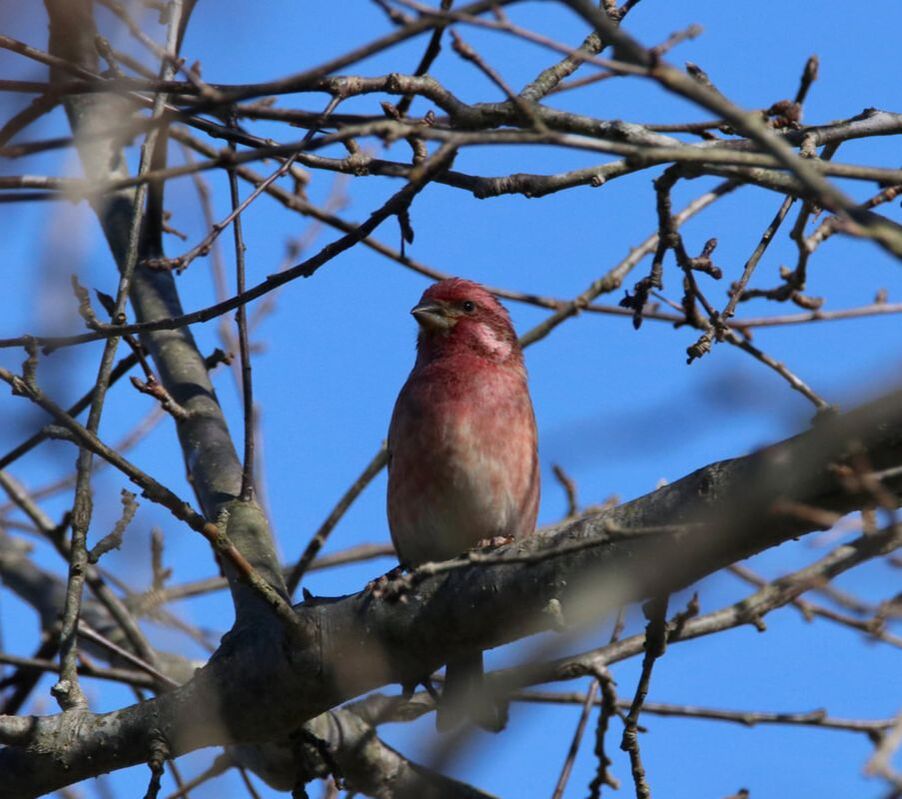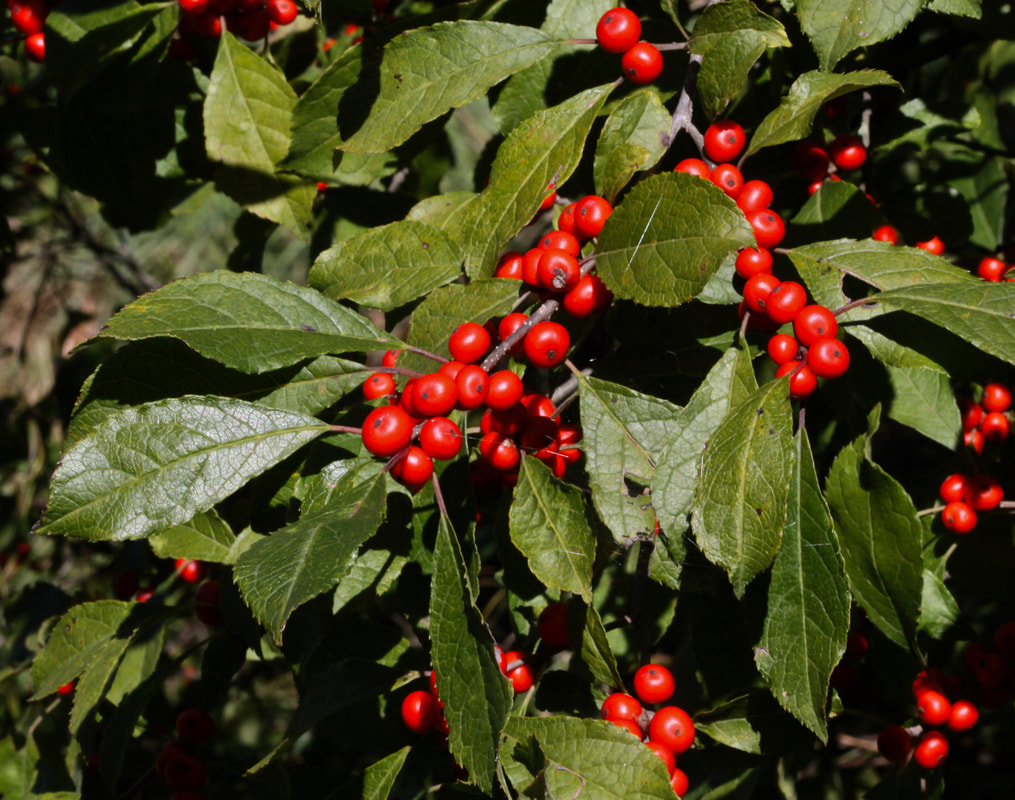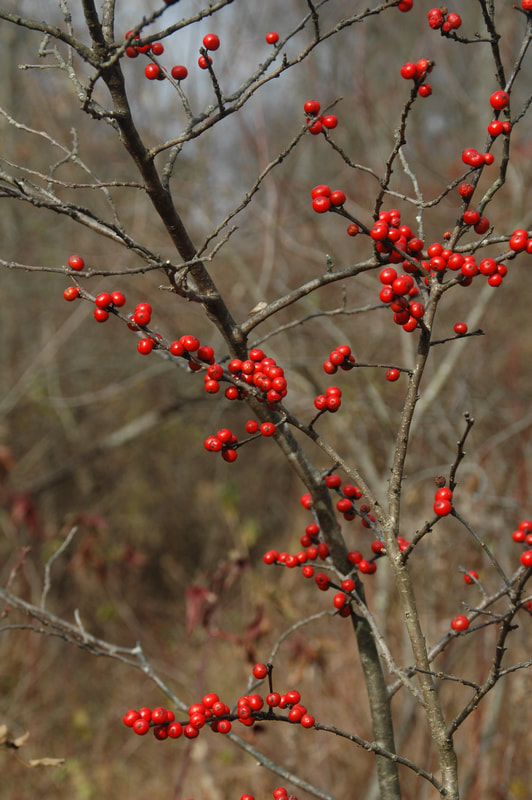IN OHIO'S FIELDS AND FORESTS
John Watts, retired resource manager with the Columbus and Franklin County Metro Parks, shares monthly posts
from the field. John is a member of the ONAPA Board of Directors.
from the field. John is a member of the ONAPA Board of Directors.
Giant Swallowtail one Ohio butterfly that will not go unnoticed this summer
|
Photo and story John Watts
As one strolls into the middle of summer, the bird songs begin to wind down and it’s time to look for other species. Butterfly occurrences peak in the summer months, especially in terms of numbers with 137 species of butterflies and skippers recorded for Ohio. Many of these species are small and can go unnoticed. The Giant Swallowtail is not, however, one of those species. With a wingspan of 4-6.5 inches this large, dark brown butterfly with two rows of bright yellow spots across the top of its wings has a strong but almost effortless flight pattern which an make them a challenge to follow. The underside of the wings is a bright creamy-yellow with a blue median |
spot band on the hindwing. This avid flower visitor nectars on a wide variety of summer wildflowers but is limited to two species of plants as a larval food source. The larva feed on the shrubs Prickly Ash (Zanthoxylum americanum) and Wafer Ash (Ptelea trifoliata), both members of the Rue or Citrus (Rutaceae); the same family that includes: oranges, lemons, and limes. While Prickly Ash and Wafer Ash are widespread in Ohio and can form dense stands in open, moist woods and calcareous banks. Where one finds those types of populations, the Giant Swallowtail is likely to be fairly common. In Ohio, both of these plants are more common in the western half of the state and Giant Swallowtails is fairly uncommon in the eastern and southeastern portions of our state.
The butterfly appears annually in two broods: one in late May and early June and the second during the second half of July and August. The second brood seems more prolific in most years and individuals are larger during the spring brood. While often seen flying quickly by, if you happen upon a mineralizing individual (possibly recently emerged) and you are patient and move slowly, it is possible to capture photos of them in flight as they lazily drift from spot to spot. It can be a wonderful experience to watch the movement of such a large butterfly with an almost tropical looking appearance right here in Ohio.
The butterfly appears annually in two broods: one in late May and early June and the second during the second half of July and August. The second brood seems more prolific in most years and individuals are larger during the spring brood. While often seen flying quickly by, if you happen upon a mineralizing individual (possibly recently emerged) and you are patient and move slowly, it is possible to capture photos of them in flight as they lazily drift from spot to spot. It can be a wonderful experience to watch the movement of such a large butterfly with an almost tropical looking appearance right here in Ohio.
Annual spring migration is in full motion as millions of birds move north to nest
|
Story and photos by John Watts
With spring migration well underway and the truly big waves moving north which will arrive in the next week or so, this is my annual message encouraging everyone to take the time to enjoy this spring phenomenon on some level. Whether it be alone in your backyard, at a nearby park or nature preserve, or by joining the masses in areas such as Magee Marsh during the Biggest Week of Birding it will be worth your effort. All of these areas can be very productive. My own small woodlot and backyard annually produces 80-90 species during the spring migration. Areas such as Sheldon’s Marsh and Headlands State Nature Preserves are some of the best areas in the state of Ohio to watch these birds stage and fuel up before riding a strong south wind across Lake Erie. While many of other groups of birds pass through and we should appreciate and learn about all of them, the wood warblers are certainly among |
the springtime favorites. Thirty-five species regularly pass through or nest in Ohio, but additional rarities are also
known to occur. Two true migrants in Ohio are the Black-throated Blue Warbler and the Cape May Warbler. Though appearances differ, these two striking species pass through annually in reasonable numbers but only during a small window of time. A new online tool you may find of interest is a site called BirdCast.info, part of the Cornell University family of bird information sites. This live interaction site provides real time data on nightly forecasts and predicts birds moving north across the United States. The findings can be tailored to your specific area. As I write this on May 1, the prediction for the United States tonight is 393 million birds moving north with a concentration in the mid-Mississippi Valley. Check it out as a fun tool to help you further enjoy spring migration! |
|
Bright red on Ohio's spring forest floor is Scarlet Cup Fungus
Story and photo by John Watts
An April hike through moist woodlands and ravines in Ohio will reveal a number of early spring wildflowers that might include Trout Lilies, Spring Beauties, Cut-leaved Toothwort and Blue Cohosh. Suddenly a bright red color catches your attention low on the ground emerging from among the early spring low vegetative growth. While some people focus on other spring fungi, the Scarlet Cup Fungus is one of the few bright red species found in Ohio’s early spring woodlands. This species of fungus appears to being growing on the ground, but moving some leaf litter will reveal its attachment to hardwood branches in the fairly moist, rich ravines, woodlands, and small stream bottoms throughout the state. Found singly or in a loose group, they are typically found in very late March and early April. They vary in size from ¾ to 23/8 inches long and ¾ to 11/4 inches wide and show a deep bright red cup with a white outer surface. The bright red color is produced by several types of carotenoid pigments. Michael Kuo (MushroomExpert.com) notes that field guides often treat this mushroom as "Sarcoscypha |
coccinea," though that species is actually found only in the Pacific Northwest.
"Sarcoscypha dudleyi" and "Sarcoscypha austriaca" are the eastern North American species--but separating them, unfortunately, requires a microscope. Keep an eye out for this fairly common species while enjoying the bounty of Ohio’s spring wildflower show. References: Kou, Michael. MushroonExpert.com. Lincoff, Gary H. 1987. The Audubon Society Field Guide to North American Mushrooms. Alford A. Knopf. New York. |
|
Early arriving Pine Warblers visit feeding stations
Story and photo by John Watts
Early March marks the arrival of our first spring warbler. Within the first few days, especially if we have an early warming trend, a striking yellow bird with wings bars and faint streaking on its breast may appear at feeding stations in southern Ohio. The Pine Warbler (Setophaga pinus) is the first of our breeding warblers to return to the dry pine woods of southern and southeastern Ohio. Territorial males typically return during the first week of March and become increasingly widespread between March 12-18 and the second half of the month. While our resident birds return during March, spring migrants passing northward through Ohio are typically observed during mid-April and early May with other waves of migrating spring warblers (Peterjohn 2001). While their early return is a welcome sign of spring, these early individuals will likely have to endure a few unpleasant days of snow showers and colder temperatures. During these times they may regularly visit suet feeders at backyard feeding stations. Peanut butter suet seems to be a favorite source of nourishment for these colder days. Pine Warblers continue to be rare winter visitors; however, in recent years their wintering numbers have increased and they are an annual winter resident in Ohio (Harlan 2022). This year reports of arriving Pine Warblers at feeding stations in Athens, Hocking, and Fairfield Counties were noted during the last week of February. As a breeding summer resident, they are rare to locally distributed statewide and are becoming a locally common |
resident in the dry ridgetop forests of eastern and southeastern Ohio’s unglaciated plateau. They tend to prefer woodlands with intermixed populations of native pines: Virginia, Pitch and Shortleaf Pines. In northwestern Ohio, they regularly use mature pine plantations for nesting. Shawnee State Forest in Scioto County supports one of the highest concentrations in the state, but they are regularly encountered in other forests and nature preserves in areas such as Hocking County and scattered locations in northeast Ohio. Keep an eye out on those cold days in March for a bright yellow visitor in your backyard.
References: Harlan, Robert N. 2022. Ohio Bird Records Committee Annotated Checklist of the Birds of Ohio. 65 p. Peterjohn, Bruce G. 2001. Birds of Ohio. The Wooster Book Company. Wooster, Ohio. pp. 441-443. |
|
February is the month for Ohio's 'Skunkers'
Story and photos by John Watts
As we continue to endure winter’s grip, February brings a couple of assurances that spring is on the way. Our first native wildflower, Skunk Cabbage, begins to emerge through to the surface in the southern half of the state and is generally above ground statewide by the end of the month. Finding a patch of the purple to reddish to green flowers along a streamside wetland, wooded forested seep, or bog edge is a welcomed site. Skunk Cabbage is a member of the Arum Family. The dark purple to red to green structure that is first noticed when one finds it, is called the spathe and envelops the club or spadix that possess the small yellowish flowers. Inside the spathe is a mini-sauna where temperatures are often as much as 50-degrees higher than the surrounding outside air temperatures allowing it to bloom while often surrounded in snow. This process is known as thermogenesis. The higher the temperature inside the spathe or hood, the more intense the odor produced by the flowers, which is generally described as unpleasant, wretched, or resembling decaying flesh. The specific name foetidus, in fact, means “evil-smelling.” The heating of the flowers also assists in attracting pollinators which are various scavenging flies and early season honey-bees. Ohio’s other “skunker” is a commonly encountered mammal, the Striped Skunk. The scientific name, Mephitis mephitis, is derived from Latin mephit, meaning “bad odor” referring to the noxious odor of the spray that is used as a defense mechanism and during mating battles with other males. One first begins to notice Striped Skunks during the middle of February in most years, often visiting the ground around bird feeders at night. However, the most noticeable aspect of their early season presence is the aroma of an emerging individual after a few days of warmer weather producing moderate evening and overnight temperatures. Skunks enter periods of inactivity or torpor in the northern portion of their range. Skunks may enter torpor numerous times over the course of winter with body temperatures during those times dropping from 96.8o-100.4o F to 78.8o F. In Manitoba, |
skunks have been known to “group nest” during the winters to preserve body temperature and fat; emerging in the spring with 26% body fat compared to 9% body fat for solitary skunks (Harder and Cameron 2022). With 2024 being a Leap Year, take advantage of February’s extra day to look for Ohio’s emerging “skunkers.”
References: McCarthy, Max. 2020. Turning Up the Heat: strange (and stinky) skunk cabbage. Tufts Pollinator Initiative News Website. Harder, John D. and Guy N. Cameron. 2022. Mammals of Ohio. Ohio University Press. Athens, Ohio. pp. 257-266. Martin, Laura C. 1994. Wildflower Folklore. The Globe Pequot Press. Chester, Connecticut. pp. 76-78. |
This Eurasian species is now an annual winter visitor to Ohio's Lake Erie shore
|
Story and photos by John Watts
Ohio offers many opportunities to enjoy a great variety of birdlife from season to season. The most recent Checklist of the Birds of Ohio lists 449 species (Ohio Bird Records Committee https://ohiobirds.org/resources/official-ohio-ornithological-society-bird-checklist/) that have been documented and accepted for the state. An interesting, yet very challenging, group of birds are the gulls. To date, twenty-three species of gulls have been documented as occurring in Ohio. Offering some considerable identification challenges, gulls are among some of our most difficult birds to learn. Beyond the identification challenges, enduring the winter weather conditions often encountered along the Lake Erie shore, especially the Cleveland Lakefront Region, to search and view these winter visitors can leave toes and fingers numb for the ride home. Let’s discuss one species, the Lesser Black-backed Gull (Larus fuscus). This Eurasian species of gull was not regularly encountered along the eastern North American coast until the 1960’s. Since that time, their winter populations have steadily increased and they are now annual winter visitors. Ohio’s first Lesser Black-backed Gull was discovered in Cleveleand on January 20, 1977. Reports continued through the 1980’s even producing spring and fall birds; however, they were always of single observations. The first report of multiple birds being observed at one time was November 1981 at Lorain |
(Peterjohn 2001). Since that time, Lesser Black-backed
Gulls have become uncommon, but annual, visitors to the Lake Erie shoreline especially from Huron to east of the Cleveland Lakefront. During the winter of 2022-2023 at least six individuals were present along the downtown portion of the Cuyahoga River and adjacent lakefront. Observations are also increasing steadily on Ohio’s larger inland reservoirs. While most inland observations are of 1-3 birds, an astounding 37 individuals were discovered and photographed by Troy Shively at Indian Lake State Park in Logan County on December 12, 2023 (eBird Checklist 12/12/2023; Macaulay Library). As the name implies, this species has a dark back that can be described as a slate to dark gray. The head generally shows dark streaking (especially concentrated around the eye on an adult), which gives the head and neck a smudged or dirty appearance. Older birds will also show a bright yellow bill and yellow legs. Learning all the aspects of gull identification, as with other species like shorebirds and warblers, will take several seasons and lots of warm clothes. However, this is another part of Ohio’s natural history that is available to the patient, studious naturalist. References: eBird.org/explore/species maps. Cornell Lab of Ornithology. Harlan, Robert N. 2022. Ohio Bird Records Committee Annotated Checklist of the Birds of Ohio. 65 p. Peterjohn, Bruce G. 2001. Birds of Ohio. The Wooster Book Company. Wooster, Ohio. pp. 234-235. |
This winter, watch Canada Geese flocks for the appearance of "white" geese
|
Story and photos sby John Watts
As we enter the winter months, flocks of Canada Geese become a very common sight across Ohio. While lakes, wildlife areas, crop fields, and farm ponds are the usual locations; storm water retention ponds in suburban housing and warehouse areas have also become a favorite staging area for some wintering flocks. Occasionally mixed in with these flocks will be one of two of Ohio’s “white” goose species. Historically, the only white goose in Ohio was the white phase of the Snow Goose. This continues to be our most common of the two species. However, in recent years a second white colored goose, the Ross’s Goose, has increasingly been observed. While usually considered a rare winter migrant, Ross’s Geese are now annually observed during Ohio’s winters. Ohio’s first record of a Ross’s Goose was in 1982. They were rarely observed until the past ten years or so when observations increased not only in Ohio, but across North America as the continental goose populations increased. By comparison, Snow Geese are considered locally common winter migrants, especially in the western half of Ohio. Snow Geese also have a color phase with a dark body and white head referred to as a blue phase or blue morph Snow Goose or Blue Goose. Snow Geese are known to congregate in impressively large numbers during migration and winter with flocks of tens of thousands not uncommon in their wintering areas. |
While superficially very similar at a glance, a closer look will reveal a couple of key identifying characteristics. The first field mark to check is the bill. Snow Geese will have a bill that slopes gradually from the head and shows a “grin patch” from the side. Ross’s Geese possess a short stubby bill that lacks the “grin patch”. Instead of gently sloping from the head, there is an abrupt drop from the top of the
head to the base of the bill. The second field mark to note is the length of the neck. Snow Geese are larger and show a longer neck versus a shorter neck and smaller size of the Ross’s Goose giving it an overall chunkier appearance. Both geese show black primary feathers in flight. Hybridization between the two is also known to occur. References: Harlan, Robert N. 2022. Ohio Bird Records Committee Annotated Checklist of the Birds of Ohio. 65 p. |
|
Stiff Gentian saves the best for last
Story and photo by John Watts
One of Ohio’s last blooming native wildflowers is the humble yet striking Stiff Gentian. This medium sized flowering plant is usually 15-20 inches tall but may reach heights close to 30 inches in wetter habitats. The flowers are comprised of five narrow, tubular corollas that range from pinkish-purple to violet and lilac with an occasional white specimen present. As with many of Ohio’s other gentians, this is a fall blooming plant that blooms from September and into November. In some years, Stiff Gentians may still be blooming near Thanksgiving. This gentian is scattered across southern and northern Ohio’s glaciated areas inhabiting a variety of dry to moist woodlands, openings, stream banks, fens, and prairies favoring alkaline soils. The Stiff Gentian is a biennial, meaning that is requires two years to mature to a flowering plant from a seed. This explains why a particular patch may appear to have more blooming plants in some years versus others. Also known as Agueweed, it is thought to have medicinal properties to reduce fevers as “ague” means fever. A bitter tea from the roots is also thought to stimulate digestion. The specific name, Gentianella, means “little Gentiana” named after Gentius, King of Illyria who is credited with discovering its supposed medicinal properties. Quinquefolia is from the Latin quinque meaning five and folia meaning leaves. This species was formerly in the genus Gentiana with many other species of the family. |
References:
Drake, Jim. 2011. Gentians of the Eastern United States. Breath O’Spring Inc., Suwanee, Georgia Website: swbiodiversity.org. SEINet Arizona-New Mexico Chapter. |
Great Plains Ladies'-tresses blooms well into autumn in a few Ohio locations
|
Story and photo by John Watts
My wife and I recently visited the Lakeside Daisy Preserve on the Marblehead Peninsula in Ottawa County on a cloudless, blue-sky, fall day. This is not the normal time of year many would consider visiting the preserve given that its namesake profusely blooms across the site in early May. I did see nearly a ground covering of Lakeside Daisy rosettes; however, this visit was to see another of Ohio’s rare plants, the Great Plains Ladies’-tresses. The Great Plains Ladies’-tresses, Spiranthes magnicamporum, blooms mostly in September and October with a few possibly lingering into very early November and represents one of Ohio’s last blooming orchids. Also known as the Prairie Ladies’-tresses, this species prefers dry alkaline prairies, dry grasslands, and dry shorelines and dune ridges. Its general distribution includes the eastern Great Plains extending east through the Prairie Peninsula Region, including Ohio, and extending as far east as isolated populations in Ottawa, Canada. In Ohio it may be found in a few locations in northwestern portion of the state and the dry, xeric prairies of the Adams County region. Ladies’-tresses as a group can be challenging to identify. Often it is important to note specific characteristics of the flower lip, color of the center of the flower, shape and curvature of the sepals, presence or absence of hairs on the stems, and other leaf characteristics. |
Great Plains Ladies’-tresses offers one more clue; a sweet aromatic fragrance that is worth kneeling down to enjoy. In larger populations the fragrance maybe noticeable when just standing among them. The Great Plains Ladies’-tresses is characterized with by a multi-ranked, tight spiral of white flowers, with a dull yellow center, and the sepals spreading and commonly arching above the petals.
While visiting the preserve on this nearly perfect fall day, we were also treated to a constant circling of Bald Eagles that totaled 12-15 different individuals. A few goldenrods and asters were also blooming and an occasional Autumn Meadowhawk dragonfly passed. Though fall color in Ohio receives its due attention, I encourage everyone to take a few moments to enjoy the other plants that may still be present during this season.
References:
Case, Frederick W. Jr. 1987. Orchids of the Western Great Lake Region. Cranbrook Institute of Science. Bulletin 48. 251 p.
Homoya, Michael A. 1993. Orchids of Indiana. Indiana Academy of Science/Indiana University Press. Bloomington. 276 p.
While visiting the preserve on this nearly perfect fall day, we were also treated to a constant circling of Bald Eagles that totaled 12-15 different individuals. A few goldenrods and asters were also blooming and an occasional Autumn Meadowhawk dragonfly passed. Though fall color in Ohio receives its due attention, I encourage everyone to take a few moments to enjoy the other plants that may still be present during this season.
References:
Case, Frederick W. Jr. 1987. Orchids of the Western Great Lake Region. Cranbrook Institute of Science. Bulletin 48. 251 p.
Homoya, Michael A. 1993. Orchids of Indiana. Indiana Academy of Science/Indiana University Press. Bloomington. 276 p.
Great Blue Lobelia spectacular blooms promise the approach of autumn
|
Reference: Gracie, Carol. 2020. Summer Wildflowers of the Northeast. Princeton University Press. Princeton, New Jersey.
|
Story and photo by John Watts
Spring wildflowers are such a welcomed sign in April after a long winter and much is made about their blooming and beauty. While this is true, fall wildflowers deserve their due as well. Even though summer is not really over as we enter September, the blooming of certain plants begins to remind us that cool, crisp, mornings and the blue-sky days of autumn are on the way. The Great Blue Lobelia feels like one of those plants. The beautiful deep violet color of the fresh flower spikes really jump out against the fading green leaves of summer. The distinctive petal arrangement of the flowers with three lower lobes and two partially upright upper lobes quickly identifies this as a Lobelia, a member of the Bellflower Family. Great Blue Lobelias are generally found in moist habitats with partial to full sun. Roadside ditches, wetland edges, streambanks, and sandbars are good places to search for this species in September. They are often found blooming with Turtlehead, Purple-stemmed Aster, Orange Jewel-weed, New England Aster, and even Cardinal Flower. While hummingbirds will occasionally visit Great Blue Lobelias, it is mostly pollinated by bumble bees. Some species of bumble bees are known to “steal” nectar from the flowers without pollinating by probing between slits in the lower corolla, gaining access to the nectar and thus avoiding the pollen and not pollinating every flower. Like many other wildflowers, an occasional white form of the Great Blue Lobelia can be found, though it’s fairly unusual. Even with a few hot days remaining, the Great Blue Lobelia is our promise of autumn’s return. |
Hiding in the Mid-Summer Shade – the Club-spur Orchid (Platanthera clavellata)
|
Story and photos by John Watts
A widely distributed orchid of mid-summer, the Club-spur Orchid, is a difficult orchid to find. Seeing the plant associated with a variety of acidic-organic-sandy seeps and wetland edge habitats will likely require being on your hands and knees in some type of shrubby vegetation. It prefers a fairly shaded habitat and is only rarely found in full sun. Also known as the small green woodland orchid, it is nearly always found in a shady situation often growing on a mossy log or a mossy hummock in a woodland seep. This type of substrate typically does not support other dense vegetation that may compete with it. Within Ohio, it will most likely be encountered in the eastern two-thirds of the state. The small green to white flowers bloom in July and August and are always arranged in a 45-degree angle away from the stem, |
making it the only orchid in this genus with this unique flower arrangement. The entire plant ranges from six to ten inches tall and only rarely exceeds twelve inches in height. It is Ohio’s smallest species in the Platanthera genus, which totals around a dozen species. The specific name clavellata is from Latin clavellatus, meaning “club-shaped” referring to the clubbed spur on the back of the flower.
making it the only orchid in this genus with this unique flower arrangement. The entire plant ranges from six to ten inches tall and only rarely exceeds twelve inches in height. It is Ohio’s smallest species in the Platanthera genus, which totals around a dozen species. The specific name clavellata is from Latin clavellatus, meaning “club-shaped” referring to the clubbed spur on the back of the flower. References: Homoya, Michael A. 1993. Orchids of Indiana. Indiana Academy of Science & Indiana University Press. Bloomington and Indianapolis. 148-151 pp. Luer, Carlyle A., 1975. The Native Orchids of the United States and Canada, excluding Florida. The New York Botanical Garden. 206-207 pp. |
American Snout butterfly makes it summer appearance in June
|
Story and photos by John Watts
One of Ohio’s more unique butterflies may be the American Snout. A small to medium sized butterfly with a wingspan ranging from just over 1.5 inches to just less than 2 inches, this species is widespread in Ohio but most frequently encountered in the western glaciated counties. This small brown butterfly has orange patches on both the fore and hindwings with a few small white spots near the tip of the forewing. The underside is a uniform light to dark brown with darker patterns and dark wing veins. The underside coloration mimics a dried leaf when perched on a twig giving it the perfect camouflage along wooded streams and wood edges. The most unique aspect of this butterfly is a facial feature – it’s snout! The long snout is actually an elongation of its palpi – pair of sensory organs that allows the butterfly to “taste” potential nectar and larval food plants. All butterflies possess palps; they are just much more prominent on the Snout. The Snouts primary foodplant is Hackberry (Celtis occidentalis) trees, but it may utilize Dwarf Hackberry (Celtis tenuifolia) in southern Ohio. |
American Snouts are a summer butterfly throughout Ohio, rarely appearing prior to early June, and they migrate northward annually. For the most part, they are not able to survive Ohio’s winters; however, there is some thought that they are possible residents along the Ohio River counties where they are found annually in the same locations. Northern Ohio individuals are certainly established by migrants annually.
References: Allen, Thomas J. 1997. The Butterflies of West Virginia and Their Caterpillars. University of Pittsburg Press. Pittsburg, PA. 388 p. Iftner, David C., John A. Shuey, and John V. Calhoun. 1992. Butterflies and Skipper of Ohio. Ohio Biol. Bull. New Series Vol. 9 No. 1 xii = 212 p. (includes 40 Pls.). |
|
The months for moths have arrived
Story and photo by John Watts
While recently enjoying the chatters and calls of our recently fledged Eastern Screech Owl family from my porch just after dusk, something caught my eye as it flew under the dim light. It was immediately obvious that it was not a May Beetle (June Bug) as it was large and the wing flutter made a very noticeable sound. I knew it was one of the Sphinx Moths, but which one? It finally stopped to rest on a porch beam allowing me to identify it as a freshly emerged Pandora Sphinx Moth! The freshness of this perfect specimen, with its uniform green coloration and large dark green patches in the basal forewing area, was highlighted by the visible pink veins and coloration on the fore and hindwings. The Pandora Sphinx (or Pandorus – Eumorpha pandorus) is widespread throughout the eastern half of North America from the southern Great Lakes and Canada to Florida. Its larval foodplants are members of the Grape Family and Virginia Creeper and it is found near most woodlots and fencerows where these species are common. Adults emerge in late afternoon and fly at dusk of the first evening. It is a common species which produces only one brood per year in the north; however, in the south multiple broods are likely as adults can be observed from April to September. Sphinx Moths or Hawk Moths as a family are common and often easily observed around lights or as day feeding moths. Adults of this group may be identified by the large and heavy body with a long-pointed abdomen. Many Hawk Moth caterpillars are called “hornworms” for the stiff |
pointed horn on the rear end of the body. Some species are often observed around garden plants carrying the larva, egg cases, or cocoons of various parasitoid wasps and flies. In North America and Canada at least 127 species of Hawk Moths have been reported.
References: Beadle, David and Seabrooke Leckie. 2012. Peterson Field Guide to the Moths of Northeastern North America. Houghton Mifflin. New York, New York. Missouri Department of Conservation Discover Nature Series Field Guide – Sphinx Moths. Website: mdc.mo.gov. Tuttle, James P. 2007. The Hawk Moths of North America-A Natural History Study of the Sphingidae of the United States and Canada. The Wedge Entomological Research Foundation. Washington D.C. |
|
Spring migration - here they come!
Story and photos by John Watts
The annual spring migration of birds is one of my favorite times of the year. In a period of 3-4 weeks, tens of millions of birds or more will pass through Ohio on a journey to their northern breeding grounds. During this time in late April and peaking in the first two weeks of May, with some luck and effort it is possible to see 100 - 150 species of birds in a single day. The southern shore of Lake Erie is a well-known staging area for birds awaiting southerly winds to push them across the lake and even further through the northern Great Lakes. While many species of birds will be observed during this annual show, few species are more sought after in their newly acquired breeding plumage than the eastern wood warblers. Thirty-five species of warblers regularly pass through Ohio during the spring with the first of them arriving in early April. Over the next four to six weeks, these small colorful birds will move across Ohio’s landscape and along river corridors to feed and fuel for the next stage of their flight. Nearly all of the forested State Nature Preserves offer opportunities to view a number of these species. Areas such as Headland Dunes and Sheldon’s Marsh State Nature Preserves on the south shore of Lake Erie provide areas to witness them in large staging numbers. |
|
Familiar signs of spring include variety
Story and photo by John Watts
Trilliums represent some of the most widely recognized species of our native spring wildflowers. They are easily identified, commonly encountered, and are fairly familiar as one of the first wildflowers many young naturalists and botanists learn. The Sessile Trillium (Trillium sessile) was the first of the sessile-flowered Trillium species named by Linnaeus. It is widespread throughout the Midwest region, including Ohio, in rich woodlands and floodplains near limestone or calcareous soils. This species earns its name from the “stalkless” or sessile leaves and flowers. The typical flower is three-petaled and maroon-brown with petals in an upright position. The flower is described as having a pungent, yet spicy odor in fresh flowers. The leaves are strongly to sparsely mottled except in individuals as described below. One color variation commonly encountered is referred to as forma viridiflorum. It was first described by Leonard Beyer in 1926 based on specimens he observed in West Virginia. In this form, flowers are a greenish-yellow color due to the lack of the anthocyanin, a pigment that produces the maroon color of our typical Sessile Trillium. This form is usually scattered among the typical Sessile |
Trillium plants. The lack of anthocyanin also produces a paler leaf that may be nearly all green or mottled with lighter colors than the typical darker mottled colors on most plants. While hiking our early spring woods keep an eye out for these and other variations among our common spring wildflowers.
References: Beyer, Leonard K. 1927. A Green Form of Trillium Sessile. Torreya. 27 (5): 83-84 September - October 1927. Torrey Botanical Club. New York. Case, Fredrick W., Jr. and Roberta B. Case. 1997. Trilliums. Timber Press. Portland, Oregon. Pg. 228-232. |
|
Smooth Alder (Alnus serrulata) is an early spring bloomer
Story and photo by John Watts
One of the first signs of spring in parts of Ohio is the blooming catkins of the Smooth Alder. Also called the Hazel Alder, is usually found in wetlands, streams, and lake edges as a multi-trunked shrub growing 12-20 feet tall and generally forming dense stands where they grow. Along lake edges they can be an effective bank stabilizer from wave action and provide valuable cover and habitat for a variety of wildlife. Smooth Alder is scattered throughout Ohio being more commonly encountered in southern and eastern Ohio and nearly absent from Ohio’s limestone region. Smooth Alder is one of the earliest woody plants to bloom in Ohio. The staminate male flowers are catkins that range in color from green to yellow to purple. The male flowers range from 1.5 to 2.5 inches in length and are quite noticeable when in bloom. The female, pistillate flowers, are small typically .5 inches in length in the tip of the stem and are usually a reddish-brown color. Smooth Alders can generally be found blooming in southern Ohio during the first week of March; however, this year the warmer late winter temperatures produced the flowering catkins the third week of February. While certainly early, let’s hope the spring’s arrival is just around the corner. References: Braun, E. L. 1961. The Woody Plants of Ohio. The Ohio State University Press. Columbus, Ohio. |
|
Watch for moths on warm February nights
Story and photo by John Watts
During mid and late winter, Ohio often experiences short warm spells of weather that tease us with thoughts of spring’s arrival. During these few days one might hear a Spring Peeper on a rainy evening, a calling American Woodcock, or even see moths around glowing porch lights. Most of these moths are not large, easily recognizable moths, but a few small brown and grayish species will fly during these warm spells. One species that I have encountered early in the year is a species in the group known as Gray Moths. This group of moths is a complex group consisting of about two dozen species. Members of this group, as the name implies, have a basic wing ground color of various shades of gray highlighted with black lines and spots often described as “peppery”. Some species such as the Brown-shaded Gray (Iridopsis defectaria) show warm brown shading near the black lines. Females of this species show no brown shading as shown in this photo of a mated pair. This is a common and widespread species in Ohio that maybe observed from February to November. The larva feed on a variety of woody plants. The Brown-shaded Gray is in the family of moths known as Geometridae. Geometrids represents one of Ohio’s largest families of moths. The name Geometridae is from the type genus Geometra (Linnaeus), which is Greek meaning |
"to measure the earth," referring to the larva, or inchworm, as they move in a looping fashion a common member of this family.
References: Horn, Dave Jr. PhD., 2017. Moths of Ohio Field Guide. Ohio Division of Wildlife Publication 5467. Columbus, Ohio Bugguide.net. Hosted by Iowa State University. Department of Plant Pathology, Entomology, and Microbiology. Beadle, David and Seabrooke Leckie. 2012. Peterson Field Guide to the Moths of Northeastern North America. Houghton Mifflin. New York, New York. p.611. McCormac, Jim. Personal communication. |
Birdfeeder birding provides an excellent study opportunity for birders of all ages
|
Story and photos by John Watts
During winter months, especially in periods of snowy weather, birdfeeder birding can provide an opportunity for close study of many bird species. Two permanent resident species that can cause some confusion when independently encountered in the Ohio’s forests are the Downy and Hairy Woodpeckers. Both species regularly occur across the state of Ohio in forested landscapes with the Downy being the more common of the two species. Downy Woodpeckers have adapted very well to forested urban areas and may easily be found in most city and county park lands. Hairy Woodpeckers, while occurring statewide, are more common in the mature hill country forests of eastern and southeastern Ohio, where they are often found in oak-hickory forests. They are very similar in physical appearance with a black and white pattern back, bright white throat, breast, and stomach and even the black and white check and eye-stripe pattern are very similar. Two physical features that separate them can be readily seen when found together at winter feeding stations. Hairy Woodpeckers possess a larger body size and longer, stouter beak than its smaller cousin. The beak of the Downy at close range appears pointed versus blunt as it is on the Hairy. In general, the length of the Downy Woodpecker’s beak is less than half the width of the head and the Hairy Woodpecker’s beak is longer than half the width of head. At close range, the larger size of the Hairy when compared to the Downy is fairly prevalent. Keep an eye on those feeders as a study guide to aide you later in the year when warmer temperatures have returned and you are looking for birds among Ohio’s forested areas. References: Rodewald, Paul G. et al. 2016. The Second Atlas of Breeding Birds in Ohio. University Park, PA: Penn State University Press. Pp. 232-235. |
|
Enjoy an annual holiday tradition - National Audubon Society's Annual Bird Count
Story and photos by John Watts
This year will mark the 123rd year for the National Audubon Society’s Christmas Bird Count annual winter census of birds in the United States and Canada (and other locations). Noted ornithologist, Frank Chapman, and 27 other birders conducted the first of these counts in 1900 as an alternate to the previous tradition of hunting “fur and feathers” during the Holiday Season. In that year, 25 counts across 13 states and two Canadian Provinces, including one at Oberlin, Ohio, tallied a nationwide total of 89 species. Since that first Christmas Bird Count, these annual winter counts have grown and during the 2020-21 season (121st year), 2,290 count circles were completed in the United States and Canada by 69,860 participants. Today there are about 67 active Christmas Bird Counts in Ohio. Forty-nine of these counts produced 60 species of birds during the 2020-21 Count Season. Counts at Toledo and Wilmont led the way with 94 species each. While learning birds is certainly a year-round endeavor, Christmas Bird Counts offer a beginning birder the opportunity to see a good number of species without feeling overwhelmed as can happen during the peak of spring migration. It’s also a great opportunity for a seasoned, more experienced birder to teach new birders what to look for in terms of field marks, face patterns, wing patterns, and habits as the lack of vegetation can make many species easier to find and observe. It is also a great way to meet new friends and birders who share a common interest in birds and the out-of-doors. |
To register for a Christmas Bird Count in your area, if you don’t know a local birdwatcher, visit audubon.org to find a count in your area. Counts will be conducted between December 14, 2022 and January 5, 2023. I encourage everyone to participate in a count to enjoy and learn our winter birds.
Reference: “History of the Christmas Bird Count” and “121st Christmas Bird Count Summary” (by Geoff LeBaron). National Audubon Society’s web page: audubon.org/conservation/history-christmas-bird-count. |
|
November a month of transition for nature
Story and photos by John Watts
Edwin Way Teale said, “How sad would be November if we had no knowledge of the spring?” November is certainly the final end of our growing season, but a period of transition on the field naturalist’s annual calendar. Fall color lingers into the first week or so, especially in the southern part of the state as the leaves of American Beech and the oaks tend to persist. Temperatures can stay warm into the first half of the month providing days for late season butterflies to continue to fly until the first good freeze. The early morning and late day skies seem to change in November and catching a dark blue-gray sunrise or sunset can be a treat. While most songbirds have passed through by early November, winter residents from the north continue to arrive often near feeding stations. A trip to Crane Creek and Magee Marsh or Ottawa National Wildlife Refuge may provide the opportunity to catch the arrival of Tundra Swans and Sandhill Cranes or Rusty Blackbirds along the boardwalk. Walking your favorite field or trail will reveal seed pods of some of our favorite summer plants. |
favorite field or trail will reveal seed pods of some of our favorite summer plants.
So, while we are headed into Ohio’s “gray” time of year there are many species and scenes to experience and appreciate, always with the knowledge that after the winter’s grip spring will return in a few months. |
|
Oak forests a haven for autumn moth
Story and photos by John Watts
Mid to late October marks the peak of fall color across Ohio, especially in the heavily forested region of the southern and southeastern hills. It is also the peak time for a fall moth that many may briefly encounter, wondering “What was that black and white moth that just flew past?” If one is hiking in the Oak Openings Region of northwest Ohio or the oak forests of southern Ohio it was very likely a Buck Moth. Buck Moths emerge during the middle of October and will only be present for a couple of weeks. The scientific name is Hemileuca maia. Maia is thought to be related to the constellation the Pleiades – The Seven Sisters, as Maia was said to be the most beautiful of the Seven Sisters. Hemileuca, translates to “half pale” a likely reference to the black and white wing pattern. Buck Moths have a wingspan of 2-3 inches across. The wings are a black ground color with a narrow white band across the center of the fore and hindwing. The forewing has a black-bordered kidney-shaped spot (reniform) that is very visible when perched. Males are slightly smaller but can be differentiated from the female by the red tip of the abdomen. While a few versions of the story can be found, the common name is generally associated with the fall breeding season and rutting activities of White-tailed Deer and being present during “buck season”. Buck Moths largely feed on a variety of oaks in the throughout their Ohio range. Males are most noticeable as they fly through oak woodlands searching for females, being most active between 10:00 a.m. and 3:00 p.m. on warm, sunny fall days. It is listed as a “Species of Concern” by the Ohio Division of Wildlife and may not be encountered everywhere. Searching for this species in the Oak Openings Region and areas such as Clear Creek State Nature Preserve and Metro Park in Hocking County should result in the opportunity to see this species. |
References:
https://entnemdept.ufl.edu/creatures/misc/moths/buck_moth.htm Holland, W.J. 1968. The Moth Book. Dover Publications. New York. 479p. Tuskes, Paul M., James P. Tuttle, and Michael M. Collins. 1996. The Wild Silk Moths of North America. Cornell University Press. Ithaca, New York. 250p. |
Warbler migration is starting - beginning birders may want to use helpful guide
Story and photos by John Watts
The annual migration calendar has flipped, and soon we will see a number of species migrating south from their breeding grounds in the north. As we noted last month, shorebird migration begins in July and peaks in late August and early September. By September, the first large groups of swallows have also moved south, and Common Nighthawks will be seen in the late afternoon and evening with groups passing through during the first week or so of the month. They are followed by the passerines, including the wood warblers. A small number of warblers begin to appear in the northern part of Ohio during the last week or so of August; however, the first large groups will begin to appear during the second week of September. Areas such as Sheldon’s Marsh and Headlands Dunes State Nature Preserves are excellent areas to see these birds as they arrive and move south.
While learning the spring warblers is generally considered a challenge for birders–and can be overwhelming for beginners–fall warblers take even more time, patience, and careful observation. In the fall, many species of warblers look similar to their bright spring breeding plumages with faded colors or less extensive markings on the head or throat. Others, however, look completely different and have lost nearly all of their breeding plumage. Compounding the issue is that many of these birds are young-of-the-year and have yet to obtain many, if any, of the adult markings. Learning these species can be a rewarding challenge and provides a great reason to get out and enjoy Ohio’s autumn mornings. The Warbler Guide, by Tom Stephenson and Scott Whittle, is an excellent guide for learning fall warblers with its many comparison photos.
The annual migration calendar has flipped, and soon we will see a number of species migrating south from their breeding grounds in the north. As we noted last month, shorebird migration begins in July and peaks in late August and early September. By September, the first large groups of swallows have also moved south, and Common Nighthawks will be seen in the late afternoon and evening with groups passing through during the first week or so of the month. They are followed by the passerines, including the wood warblers. A small number of warblers begin to appear in the northern part of Ohio during the last week or so of August; however, the first large groups will begin to appear during the second week of September. Areas such as Sheldon’s Marsh and Headlands Dunes State Nature Preserves are excellent areas to see these birds as they arrive and move south.
While learning the spring warblers is generally considered a challenge for birders–and can be overwhelming for beginners–fall warblers take even more time, patience, and careful observation. In the fall, many species of warblers look similar to their bright spring breeding plumages with faded colors or less extensive markings on the head or throat. Others, however, look completely different and have lost nearly all of their breeding plumage. Compounding the issue is that many of these birds are young-of-the-year and have yet to obtain many, if any, of the adult markings. Learning these species can be a rewarding challenge and provides a great reason to get out and enjoy Ohio’s autumn mornings. The Warbler Guide, by Tom Stephenson and Scott Whittle, is an excellent guide for learning fall warblers with its many comparison photos.
|
Cape May Warbler
Passing through in good numbers in the fall, Cape May Warblers can be found by watching evergreens, especially spruce trees. Gone is the brilliant chestnut cheek and face patch contrasting with the bright yellow to orange head and breast. The fine breast and flank streaks are still present along with a reduced wing bar or panel. The cheek patch is very light chestnut to gray. The dark eye line is generally present but is faded. Bay-breasted Warbler Early arrivals and some adult males still possess some of the chestnut color on the flanks, but the striking contrast between the black crown and chestnut throat and breast are greatly reduced to nearly gone in most individuals. The head and nape of neck vary from dark faded chestnut to yellow-green in color with visible streaking on the upper back or mantle. A good feature to look for are the dark legs and feet. This will help distinguish it from a Blackpoll Warbler. Blackpoll Warbler A complete change from the black cap, white cheek, and throat and flank black streaking in the spring, fall Blackpolls appear with greenish-yellow-olive tones to gray with faint streaking on the sides of the breast, flanks, and upper back. Pay particular attention to the legs and feet–which are pink or flesh colored–to distinguish them from the Bay-breasted. Blackpoll Warblers generally pass through Ohio in fewer numbers than Bay-breasted in the fall. |
Watch for the start of fall migration of shorebirds during lake shore and mudflat birding
By John Watts
While August doesn’t usually call to mind the autumn, if one notes the sequence of our natural world it is clear that fall or autumn is approaching. August is a time when many of our birds begin the southern treks to their wintering grounds. In fact, for some shorebirds, even early July can produce the first Least or Solitary Sandpiper beginning its return migration. Shorebirds are difficult, but as with any other group of species patient study can result in easy identification of many species. Of the 443 species of birds on Ohio’s official checklist (Ohio Ornithological Society -https://ohiobirds.org/resources/official-ohio-ornithological-society-bird-checklist/) 47 species are shorebirds. With some effort, one can expect to encounter 25-35 shorebirds in Ohio during a typical year. Fall shorebird migration begins to advance in mid-August and extends into late September. While numbers tend to decline in October and most individuals have departed by November, there are occasional stragglers that linger into December. Our most familiar shorebird, the Killdeer, may overwinter in Ohio in low numbers during some years. Wilson’s Snipe have also been recorded during our winter months.
Shorebirds utilize exposed mudflats often created by the drying out of wetland pools. Timing is everything as these areas can dry quickly under the August summer heat and lack of rainfall. For birdwatchers it is important to keep an eye on these areas as species may move on quickly if the habitat disappears. Many shorebirds migrant at night often resulting in significant changes in terms of number individuals and species at a given site. Many shorebirds travel thousands of miles during the biannual migrations often crossing continents and even open ocean. The Bar-tailed Godwit travels up to 6,000 miles non-stop as part of its migratory movements.
Nature Preserves such as Pickerington Ponds Metro Park in Franklin County, Sheldon’s Marsh in Erie County, and Headland Dunes in Lake County can be very productive shorebird stopover points. Also, wetland restoration areas in your local park districts and some State Wildlife Areas may also be productive. The two refences below are highly recommended field guides that are specifically focused on shorebirds and their identification.
While August doesn’t usually call to mind the autumn, if one notes the sequence of our natural world it is clear that fall or autumn is approaching. August is a time when many of our birds begin the southern treks to their wintering grounds. In fact, for some shorebirds, even early July can produce the first Least or Solitary Sandpiper beginning its return migration. Shorebirds are difficult, but as with any other group of species patient study can result in easy identification of many species. Of the 443 species of birds on Ohio’s official checklist (Ohio Ornithological Society -https://ohiobirds.org/resources/official-ohio-ornithological-society-bird-checklist/) 47 species are shorebirds. With some effort, one can expect to encounter 25-35 shorebirds in Ohio during a typical year. Fall shorebird migration begins to advance in mid-August and extends into late September. While numbers tend to decline in October and most individuals have departed by November, there are occasional stragglers that linger into December. Our most familiar shorebird, the Killdeer, may overwinter in Ohio in low numbers during some years. Wilson’s Snipe have also been recorded during our winter months.
Shorebirds utilize exposed mudflats often created by the drying out of wetland pools. Timing is everything as these areas can dry quickly under the August summer heat and lack of rainfall. For birdwatchers it is important to keep an eye on these areas as species may move on quickly if the habitat disappears. Many shorebirds migrant at night often resulting in significant changes in terms of number individuals and species at a given site. Many shorebirds travel thousands of miles during the biannual migrations often crossing continents and even open ocean. The Bar-tailed Godwit travels up to 6,000 miles non-stop as part of its migratory movements.
Nature Preserves such as Pickerington Ponds Metro Park in Franklin County, Sheldon’s Marsh in Erie County, and Headland Dunes in Lake County can be very productive shorebird stopover points. Also, wetland restoration areas in your local park districts and some State Wildlife Areas may also be productive. The two refences below are highly recommended field guides that are specifically focused on shorebirds and their identification.
References:
O’Brien, Michael, R. Crossley, and K. Karlson. 2006. The Shorebird Guide. Houghton Mifflin Company. New York, New York. 477pp.
Paulson, Dennis. 2005. Shorebirds of North America-The Photographic Guide. Princeton University Press. Princeton, New Jersey. 361pp.
O’Brien, Michael, R. Crossley, and K. Karlson. 2006. The Shorebird Guide. Houghton Mifflin Company. New York, New York. 477pp.
Paulson, Dennis. 2005. Shorebirds of North America-The Photographic Guide. Princeton University Press. Princeton, New Jersey. 361pp.
Clockwise, from top left: Sanderling at Headland Dunes State Nature Preserve; Lesser yellowlegs; pectoral Sandpipers in flight; Buff-breasted Sandpiper. Photos by John Watts.
|
Summer mushrooms add color to the forest floor
By John Watts
Spring is usually when many people think of mushrooms, as morels are highly prized edibles. However, summer and fall produces many of our most colorful species of fungi. All mushrooms are fungi but not all fungi are mushrooms. Fungi represents the entire kingdom of their species separate from plants and animals. Many species of fungi produce mushrooms. The “mushroom” plays a similar role as flowers and fruits play in our plants. The mushroom is the fruiting body of the plant that appears above ground. Weather certainly plays a role in the sudden appearance of many mushrooms. A perfectly timed rain can initiate their growth and they seemingly appear overnight. Many mushrooms only maintain the peak condition and color for a day or so before showing some decay. |
One mushroom of hemlock and pine forests in Ohio is the Scaly-vased Chanterelle (Turbinellus floccosus). Chanterelles are largely summer and fall mushrooms of various colors ranging from creamy white, red, yellow, orange to purple and even nearly black. The Scaly-vased Chanterelle is generally 3-8 inches tall and deeply funnel-shaped at maturity. The center of the vase is yellow to orange, possibly a reddish-orange, and possesses flattened lighter scales. The outside of the vase is whitish and wrinkled with veins or ridges and appear as early as June and lasting into September. They are mycorrhizal with many species of conifers including pines, spruces, firs, and hemlocks. Following the root structure of their host, they can take on interesting patterns across the forest floor. This species was first described in Pennsylvania, but is widely distributed across North America.
References:
Kuo, M. (2021, August). Turbinellus floccosus. Retrieved from the MushroomExpert.Com Web site: http://www.mushroomexpert.com/turbinellus_floccosus.html
Lincoff, Gary H. 1987. The Audubon Society Field Guide to North American Mushroom-3rd printing. Alfred A. Knopf Inc., New York, New York. pp. 396-397.
Kuo, M. (2021, August). Turbinellus floccosus. Retrieved from the MushroomExpert.Com Web site: http://www.mushroomexpert.com/turbinellus_floccosus.html
Lincoff, Gary H. 1987. The Audubon Society Field Guide to North American Mushroom-3rd printing. Alfred A. Knopf Inc., New York, New York. pp. 396-397.
|
Dragonhunter (Hagenius brevistylus): name says it all
In the past few years, access to guides that can identify dragonflies has become widespread. Many guides are now available which have photographs that can help one become acquainted with this interesting and important group of insects. While many dragonflies possess unique qualities and colors, few are more impressive than the Dragonhunter.
|
As the name implies, this dragonfly will prey upon many other dragonfly species. James Curry in his “Dragonflies of Indiana” describes its recognition as “colossal size, strong, robust thorax.” Dragonhunters do average 3 to 3 ½ inches in length and certainly catch your attention when one flies by along medium to large forested streams. They are largely black in color with bright yellow stripes on the thorax, the abdomen is etched in yellow along the topside, and their green eyes make them easy to identify. They are easily approached, often seemingly fearless, as they perch on a stick or branch overlooking a stream. As the name implies, they prey upon many species of dragonflies, butterflies, and are one of three species of North American dragonflies documented to prey upon hummingbirds. The exceeding long back legs provide the additional adaption to securing larger prey items. One of their favorite prey items along forested streams with permanent flowing water are Ebony Jewelwing dragonflies. In fact, their numbers may be highest along streams where Ebony Jewelwings are common.
Dragonhunters are members of the Clubtail family and are the only member of its genus in North America. Dragonhunters are distributed across the state of Ohio but are less commonly reported from northwest Ohio. Their flat-shaped larvae do not burrow in substrate as do many other species of dragonflies, but prefer to rest among leaf detritus which allows them to inhabit a large number of forested streams. Dragonhunters are present from early June to mid-September in Ohio. I encourage everyone to get out along Ohio’s forested streams during the early summer to see this King of Ohio’s Dragonfly world.
Dragonhunters are members of the Clubtail family and are the only member of its genus in North America. Dragonhunters are distributed across the state of Ohio but are less commonly reported from northwest Ohio. Their flat-shaped larvae do not burrow in substrate as do many other species of dragonflies, but prefer to rest among leaf detritus which allows them to inhabit a large number of forested streams. Dragonhunters are present from early June to mid-September in Ohio. I encourage everyone to get out along Ohio’s forested streams during the early summer to see this King of Ohio’s Dragonfly world.
References:
Curry, James R. 2001. Dragonflies of Indiana. Indiana Academy of Science. Indianapolis, Indiana. 303p.
Paulson, Dennis. 2019. Dragonflies and Damselflies-A Natural History. Princeton University Press. Princeton, New Jersey. 224p.
Paulson, Dennis. 2011. Dragonflies and Damselflies of the East. Princeton University Press. Princeton, New Jersey. 538p.
Rosche, Larry, Judy Semroc, and Linda Gilbert with illustrations by Jen Brumfield. 2008. Dragonflies and Damselflies of Northeast Ohio, second edition. Cleveland Museum of Natural History. Cleveland, Ohio. 300p.
https://u.osu.edu/ohioodonatasurvey/species-distributions-across-ohio/ Ohio Dragonfly Survey.
Curry, James R. 2001. Dragonflies of Indiana. Indiana Academy of Science. Indianapolis, Indiana. 303p.
Paulson, Dennis. 2019. Dragonflies and Damselflies-A Natural History. Princeton University Press. Princeton, New Jersey. 224p.
Paulson, Dennis. 2011. Dragonflies and Damselflies of the East. Princeton University Press. Princeton, New Jersey. 538p.
Rosche, Larry, Judy Semroc, and Linda Gilbert with illustrations by Jen Brumfield. 2008. Dragonflies and Damselflies of Northeast Ohio, second edition. Cleveland Museum of Natural History. Cleveland, Ohio. 300p.
https://u.osu.edu/ohioodonatasurvey/species-distributions-across-ohio/ Ohio Dragonfly Survey.
|
Putty-root Orchid's winter leaf produces May bloom
By John Watts “Winter Orchids” were the topic of my winter newsletter article with a focus on the leaves of two woodland orchids. These species produce leaves that persist throughout the winter, begin to die back during the spring, and produce a flowering stalk later in the year. The first of these species to bloom is the Putty-root Orchid (Aplectrum hyemale). The Putty-root begins blooming in early May, and possibly earlier in the very southern portion of the state, and blooms into mid-June. A 12-15 inch green, smooth, leaf-less flowering stalk arises from the leaf litter producing a loose raceme of 8-15 flowers. The flower petals display a white to mostly greenish color on the petal with a purple tip. The sepals are very similar to the petals. The lip of the flower is 3-lobed and white with purple markings. This cryptic pattern allows it to blend into its surroundings in the rich, mesic forests and along floodplain terraces making it often difficult to locate. If you do spot a patch during the winter, it is important to visit them often during mid-spring as once they begin to bloom the perfect bloom of the flowers fully open only lasts a few days. Remember that while you may have found dozens of leaves during the winter, it is likely that you will only find a small percentage of the leaves producing this beautiful woodland blooming species. While small bees and other insects may pollinate Putty-roots, they are also capable of self- |
pollination. Their general lack of fragrance and nectar offers little reward to pollinating suitors.
|
|
Welcome the spring blues!
By John Watts
Early season butterflies begin to fly by late March in southern Ohio and are widespread by mid-April. A couple of our most common early season butterflies are the Spring Azure and Eastern-tailed Blue. Both species are fairly common and found throughout Ohio. Often found in forested areas, the Spring Azure can be found stopping to nectar on a Spring Beauty or mineralize at a damp location. Eastern-tailed Blues are more often associated with woodland edges and open areas as they search for nectar sources low to the ground. Spring Azures have several forms which differ regionally and seasonally, and can be quite complex. Azures are known as a “multivoltine” species meaning they have more than one brood per year. A later brood in Ohio is known as the Summer Azure which is nearly identical in appearance to the spring form, but differs by being more whitish underneath and larger than the spring form. Both forms are a whitish-blue underneath with scattered black markings and azure blue above. Spring Azures form large “puddle clubs” as they feed on damp soil extracting nutrients and minerals. This provides a great opportunity to observe and photograph them. Eastern-tailed Blues also produce multiple broods with later summer broods being noticeably larger in size. Eastern-tailed blues are one of our most common butterflies in Ohio.
|
It is commonly found in open field, woodland edges and even yards with White Clover (Trifolium repens). Eastern-tailed Blues can be quickly distinguished from Azures by the diagnostic small tails extending from the hindwings. The underside also shows orange spots that appear as inward caps on dark spots near the tails and the ground color is darker than any of the Azure forms.
While other species of blues or small bluish butterflies occur in Ohio, these are the two most common species you are likely to encounter on your regular hikes. Keep an eye out for these early season butterflies this spring.
While other species of blues or small bluish butterflies occur in Ohio, these are the two most common species you are likely to encounter on your regular hikes. Keep an eye out for these early season butterflies this spring.
REFERENCES:
Glassberg, Jeffery. 1999. Butterflies through Binoculars-The East; A Field Guide to the Butterflies of Eastern North America. Oxford University Press. New York, New York
Opler Paul A. and George O. Krizek. 1984. Butterflies East of the Great Plains. The Johns Hopkins University Press. Baltimore, Maryland
Glassberg, Jeffery. 1999. Butterflies through Binoculars-The East; A Field Guide to the Butterflies of Eastern North America. Oxford University Press. New York, New York
Opler Paul A. and George O. Krizek. 1984. Butterflies East of the Great Plains. The Johns Hopkins University Press. Baltimore, Maryland
|
Wood frogs first amphibians heard in the spring
By John Watts
The first warm days accompanied by a rainy night or two summons our earliest amphibian to their breeding pools; the Wood Frog. Triggered by rising temperatures they march en masse on a journey to the annual breeding pools which they exhibit extreme faithfulness to during their adult lifespan returning to the same pool each year. Wood Frogs are known as “explosive breeders”. The entire mating ritual from arrival at the pool to |
mating to egg laying to departure from the pools occurs within a few days to a week. Males arrive ahead of the females to establish their presence and initiate “advertisement calls” as the females approach. These calls are most often compared to the sound a group of feeding mallard ducks consisting of a short series of loud quacks, clucks or croaks depending on your descriptive preference. Once the breeding period has concluded they return to the adjacent woods and continue a fairly reclusive life under leaves, logs, and other woodland debris. Wood Frogs are our most terrestrial frogs even being found in dry oak-hickory woodland ridgetops in southeastern Ohio outside of the breeding season.
Wood Frogs have one of the longest periods of annul activity among Ohio’s amphibians. They may be active as early as January in southern Ohio during warm mild winters. Throughout Ohio most Wood Frogs started hibernation during October or early November. This species is also one of the few amphibians to range north of the Arctic Circle. Within their blood structure they possess natural freeze tolerance organic solutes, known as cryoprotectants, allowing their body to survive nearly frozen conditions during hibernation. Post-thaw recovery to normal behavioral function can occur within 24 hours but may take several days.
To experience this short-lived but spectacular annual experience, watch the weather beginning in late February and early March and check pools adjacent to woodlands often. One day will be silent and the next a deafening chorus of quacks and clucks.
To experience this short-lived but spectacular annual experience, watch the weather beginning in late February and early March and check pools adjacent to woodlands often. One day will be silent and the next a deafening chorus of quacks and clucks.
REFERENCES:
Pfingsten, R.A., J.G. Davis, T.O. Matson, G.J. Lipps, Jr., D. Wynn, and B.J. Armitage (Editors). 2013. Amphibians of Ohio. Ohio Biological Survey Bulletin New Series. Volume 17 Number 1. Xiv + 899 pp.
Davis, Jeffery G. and Scott A. Menze. 2002. In Ohio’s Backyard: Frogs and Toads. Ohio Biological Survey Backyard Series No. 3 Columbus, Ohio. X + 141 pp.
Pfingsten, R.A., J.G. Davis, T.O. Matson, G.J. Lipps, Jr., D. Wynn, and B.J. Armitage (Editors). 2013. Amphibians of Ohio. Ohio Biological Survey Bulletin New Series. Volume 17 Number 1. Xiv + 899 pp.
Davis, Jeffery G. and Scott A. Menze. 2002. In Ohio’s Backyard: Frogs and Toads. Ohio Biological Survey Backyard Series No. 3 Columbus, Ohio. X + 141 pp.
|
|
Return of the Red-winged blackbird an early sign that spring is on its way
|
By John Watts
As we transition from January to February, one begins to notice that suddenly it is still light after 6:00 p.m.!! While we are over a month from being released from the grips of winter, suddenly small anticipated signs of spring begin to appear. One may notice the emergence of the ornamental bulb known as Snowdrops in a flower bed or old homesite on a woodland hike.
While the American Robin has long been known as an early sign of spring, the arrival of the first Red-winged Blackbirds in mid-February mark some of our earliest migrants. These first arrivals begin to appear in Ohio between February 5-10 and become expected between February 18-25. These first groups are comprised almost entirely of adult males and on moderately sunny days, some calling and territorial behavior may be observed. This is short-lived for when more seasonal February winter days return, they go silent except for an occasional call-note.
Late winter weather may push them back into groups that suddenly appear at bird feeders looking for easy meals to get them through a few cold, snowy days. As February draws to a close, their numbers and daily activity continues to increase with the anticipation of the arriving females. Females begin to arrive during early to mid-March and as warmer, sunny spring days replace the gray clouds of winter, territorial displays and courtship takes center stage.
Until spring fully arrives, take the opportunity to enjoy these annual transitional events.
As we transition from January to February, one begins to notice that suddenly it is still light after 6:00 p.m.!! While we are over a month from being released from the grips of winter, suddenly small anticipated signs of spring begin to appear. One may notice the emergence of the ornamental bulb known as Snowdrops in a flower bed or old homesite on a woodland hike.
While the American Robin has long been known as an early sign of spring, the arrival of the first Red-winged Blackbirds in mid-February mark some of our earliest migrants. These first arrivals begin to appear in Ohio between February 5-10 and become expected between February 18-25. These first groups are comprised almost entirely of adult males and on moderately sunny days, some calling and territorial behavior may be observed. This is short-lived for when more seasonal February winter days return, they go silent except for an occasional call-note.
Late winter weather may push them back into groups that suddenly appear at bird feeders looking for easy meals to get them through a few cold, snowy days. As February draws to a close, their numbers and daily activity continues to increase with the anticipation of the arriving females. Females begin to arrive during early to mid-March and as warmer, sunny spring days replace the gray clouds of winter, territorial displays and courtship takes center stage.
Until spring fully arrives, take the opportunity to enjoy these annual transitional events.
REFERENCES:
Bent, Arthur Cleveland. 1964. Life Histories of North American Birds of Blackbirds, Orioles, Tanagers, and Allies. Dover Publications Inc., New York. 549p + plates. pp. 123-150.
Peterjohn, Bruce G. 2001. Birds of Ohio. The Wooster Book Company. Wooster, Ohio. pp. 532-533.
Bent, Arthur Cleveland. 1964. Life Histories of North American Birds of Blackbirds, Orioles, Tanagers, and Allies. Dover Publications Inc., New York. 549p + plates. pp. 123-150.
Peterjohn, Bruce G. 2001. Birds of Ohio. The Wooster Book Company. Wooster, Ohio. pp. 532-533.
Search for signs of our largest moth during your winter walks in the forest
|
By John Watts
On warmer days especially, we often catch glimpses of insects during winter hikes. Sunny, calm days in the mid to upper 40’s can spur midges to hatch. A few degrees warmer may stir a Mourning Cloak, Question Mark or Eastern Comma butterfly to fly for a few hours before returning to its winter slumber. Winter stoneflies emerge from stream bottoms during the winter months and can be observed crawling across snow and ice on the coldest of days. Other species of insects, such as our silk moths, over winter in a protective silk shelter called a cocoon. The word cocoon is from French coque, meaning shell. The cocoon is spun by the larva or caterpillar of the moth to provide a “shell” for its final stage of development before emerging as an adult. One of the easiest cocoons to find during the winter is that of our largest moth, the Cecropia. The cocoons are spun in two types: a compact cocoon or a bag cocoon. The type of cocoon spun seems to be dependent upon the spatial arrangement of the attachment points at the spinning site. Cecropia Moths are found commonly across Ohio, emerging as adults in June and July. As our largest moth, the adults have wingspans of up to six inches across. The grayish brown ground color of the wings with spot and line highlights of red and white make it unmistakable. The thorax is also a bright reddish color with a white collar. |
REFERENCE: Tuskes, Paul M., J. Tuttle, and M. Collins. 1996. The Wild Silk Moths of North American-A Natural History of the Saturniidae of the United States and Canada. Cornell University Press.
Uncommon Merlin falcon may magically appear on a perch near you in December
|
By John Watts
Recently my wife and I were driving along Route 33 in Fairfield County when we passed a small to medium sized hawk perched on a roadway sign. As we passed I said, “That was a Merlin.” She replied, “That’s an interesting name…why is it called a Merlin?” I had to admit that I really didn’t know why, which made me realize that I should investigate. Merlins are medium sized falcons, larger than an American Kestrel but smaller than a Peregrine Falcon. Their genus name Falco, is from Latin falx meaning a sickle, referencing the possible shape of the wings in fight, beak or talons. The specific epithet, columbarius, relates to pigeons (a likely reference to the other bird as a prey item). The common name Merlin originates in Old French esmerillon, a name for this species which in turn comes from Latin merula, meaning blackbird (also referencing a preferred food item). |
Merlins were formerly accidental winter visitors in Ohio; however, that has changed substantially since the 1990’s. They are now generally considered rare to uncommon winter residents and are most often found in urban and semi-urban areas throughout Ohio. Within these areas, cemeteries with scattered spruces and open perches seem to produce several reports each winter, sometimes of multiple birds in the same cemetery. Many of these birds are first observed in early December and as they establish a temporary winter territory. While they hunt adjacent residential and wooded areas, they often return to a favorite perch throughout the day. Merlins rarely breed in Ohio; however, there are a few confirmed records. Keep your eyes open this winter for this dark, medium size falcon, as they can magically appear anywhere.
REFERENCES:
Meiter, Gary H. 2020. Bird is the Word, An Historical Perspective on the Names of North American Birds. McDonald Woodward Publishing. Newark, Ohio p. 226.
Peterjohn, Bruce G. 2001. Birds of Ohio. The Wooster Book Company. Wooster, Ohio. pp. 131-133.
Rodewald, Paul G. et al. 2016. The Second Atlas of Breeding Birds in Ohio. University Park, PA: Penn State University Press. pp. 242-243.
Meiter, Gary H. 2020. Bird is the Word, An Historical Perspective on the Names of North American Birds. McDonald Woodward Publishing. Newark, Ohio p. 226.
Peterjohn, Bruce G. 2001. Birds of Ohio. The Wooster Book Company. Wooster, Ohio. pp. 131-133.
Rodewald, Paul G. et al. 2016. The Second Atlas of Breeding Birds in Ohio. University Park, PA: Penn State University Press. pp. 242-243.
Late fall color: the American beech saves the best for last
|
By John Watts
Scattered commonly throughout Ohio’s woodlands, the American Beech tree is one of my favorite trees. The smooth gray bark stands out in almost any woodland, especially in late winter and early spring, with the trees often forming small groves of large scattered older trees. Naturalist Donald Culross Peattie in his book A Natural History of North American Trees wrote: “As settlers moved west for greater opportunities, beech became a symbol of fertile soil, and pioneers across Ohio and Indiana set up farms alongside the range of beech. A beech is, in almost any landscape where it appears, the finest tree to be seen”. |
During late October and early November when Autumn’s fall display begins to fade, the beech lights up the woods for one final colorful act before winter. The leaves initially turn a pale yellow with green highlighting the veins. As fall progresses and November arrives, they turn a golden-brown color retaining yellow or light green on the veins for at least a couple of weeks. By mid-November many of the leaves have turned golden-brown and are still crisp before advancing to a light tan color as they persist on especially younger trees throughout the winter.
The accompanying photos were captured November 8, 2013 at Blacklick Woods Metro Park in the Edward S. Thomas State Nature Preserve east of Columbus, Ohio. I encourage all to take advantage of late fall to observe the last of our fall color, a late flying Clouded Sulphur butterfly, or maybe your first Dark-eyed Junco reminding us that winter is on its way.
The accompanying photos were captured November 8, 2013 at Blacklick Woods Metro Park in the Edward S. Thomas State Nature Preserve east of Columbus, Ohio. I encourage all to take advantage of late fall to observe the last of our fall color, a late flying Clouded Sulphur butterfly, or maybe your first Dark-eyed Junco reminding us that winter is on its way.
Hardy Autumn Meadowhawk dragonfly continues to fly into October, even November
Autumn Meadowhawk adds a streak of red to changing colors in Ohio's fall landscape.
By John Watts
As the fall season progresses, we consciously or not note signs of the seasonal changes. Some are obvious such as leaf color change, shorter days, cool crisp weather and migrating birds. There are other less noticeable events, such as fewer insects. Many of Ohio’s dragonflies flight dates diminish substantially as we enter October. However, one species, the Autumn Meadowhawk, continues to fly throughout most of Ohio through October and even into November. In fact, they can even survive that first blast of winter and still be found in late November as far north as northeast Ohio. In the northern part of Ohio, if you observe a meadowhawk it is almost certainly an Autumn. Formerly known as the Yellow-legged Meadowhawk for its distinctive yellow to greenish-yellow legs, this small dragonfly possesses a blood red face and eyes, a bright red abdomen and red wing stigmas. Autumn Meadowhawks are common throughout Ohio and are most numerous near small ponds, wetlands and slow-moving streams. They will venture to nearby uplands in search of basking areas to stay warm during cooler fall days. During these days there are very approachable for observation and photographs.
As the fall season progresses, we consciously or not note signs of the seasonal changes. Some are obvious such as leaf color change, shorter days, cool crisp weather and migrating birds. There are other less noticeable events, such as fewer insects. Many of Ohio’s dragonflies flight dates diminish substantially as we enter October. However, one species, the Autumn Meadowhawk, continues to fly throughout most of Ohio through October and even into November. In fact, they can even survive that first blast of winter and still be found in late November as far north as northeast Ohio. In the northern part of Ohio, if you observe a meadowhawk it is almost certainly an Autumn. Formerly known as the Yellow-legged Meadowhawk for its distinctive yellow to greenish-yellow legs, this small dragonfly possesses a blood red face and eyes, a bright red abdomen and red wing stigmas. Autumn Meadowhawks are common throughout Ohio and are most numerous near small ponds, wetlands and slow-moving streams. They will venture to nearby uplands in search of basking areas to stay warm during cooler fall days. During these days there are very approachable for observation and photographs.
References: Rosche, Larry, Judy Semroc, and Linda Gilbert with illustrations by J. Brumfield. 2008. Dragonflies and Damselflies of Northeast Ohio, second edition. Cleveland Museum of Natural History. Cleveland. Ohio. 300p..
Left, migrating butterflies drape shoreline trees. Right, monarch butterfly on sweet Joe pye weed.
By John Watts
As a kid, one of my favorite and most influential books was a children's book titled The Travels of Monarch X. The book described the life cycle of a Monarch Butterfly tagged near Toronto, Canada, and followed along its fall migratory route through the eastern United States to the Gulf Coast and then to San Luis Potosi, Mexico. On the tag was also a request for the eventual finder to contact the scientist with the butterfly's final location if it was recaptured.
I had always heard about the Monarch's migration along the southern shore of Lake Erie but had never observed it until September 2020. I visited Lake Erie on September 13 and 14 to search for birds and while scoping across the lake, I noticed Monarchs regularly passing through my field of view over the lake half-to-a-mile off shore. I later visited Headland Dunes State Nature Preserve to find the trees draped with resting Monarchs. This phenomenon occurs annually along Lake Erie's south shore and islands. The main migration takes place between September 10 and September 25, but I would encourage anyone interested to keep an eye out any time after Labor Day. At Headland Dunes State Nature Preserve alone, there were thousands of butterflies. Other parks and preserves along the shore were reporting good numbers. This period also coincides with the migration of fall passerines, especially warblers. Whether interested in lepidoptera or not, I would encourage all to get out and see the spectacular migration of this butterfly recognizable to almost everyone.
As a kid, one of my favorite and most influential books was a children's book titled The Travels of Monarch X. The book described the life cycle of a Monarch Butterfly tagged near Toronto, Canada, and followed along its fall migratory route through the eastern United States to the Gulf Coast and then to San Luis Potosi, Mexico. On the tag was also a request for the eventual finder to contact the scientist with the butterfly's final location if it was recaptured.
I had always heard about the Monarch's migration along the southern shore of Lake Erie but had never observed it until September 2020. I visited Lake Erie on September 13 and 14 to search for birds and while scoping across the lake, I noticed Monarchs regularly passing through my field of view over the lake half-to-a-mile off shore. I later visited Headland Dunes State Nature Preserve to find the trees draped with resting Monarchs. This phenomenon occurs annually along Lake Erie's south shore and islands. The main migration takes place between September 10 and September 25, but I would encourage anyone interested to keep an eye out any time after Labor Day. At Headland Dunes State Nature Preserve alone, there were thousands of butterflies. Other parks and preserves along the shore were reporting good numbers. This period also coincides with the migration of fall passerines, especially warblers. Whether interested in lepidoptera or not, I would encourage all to get out and see the spectacular migration of this butterfly recognizable to almost everyone.
References: Hutchins, Ross E., 1966, The Travels of Monarh X. Rand McNally. Chicago, Illinois. 64 p.
The Crane-fly Orchid - tipularia discolor - is efficient seed producer
|
By John Watts
Though it may lack in color, the Crane-fly Orchid is one of the more unique in Ohio among the 50 native wild orchids recorded. It belongs to a genus of three species worldwide, with two species in Asia and one in North America. Its common and scientific names are derived from its resemblance to a group of insects knows as crane flies (specifically Tipula crane flies). The projecting flowers and flower parts along the smooth upright stem were thought to look like a swarm of these long, dangly legged insects. The specific name, discolor, is from Latin meaning "of different colors" or "faded" referring to the dull color of the blossoms that have bee described as a "watery purplish green." |
Above, mating crane flies, Licking County, Ohio. At right, Crane-fly Orchid, Hocking County, Ohio.
|
It takes great focus to find this plant as it blends in very well with sticks, leaves and filtered beams of light across the summer forest floor. Close inspection of a flowering stem will show that the flowers are angled and arranged on the side of the stem, some to the left and others to the right. This is known as floral positioning and appears to play an important role in pollination. Retired Ohio professor and orchid expert Dr. Warren Stoutamire, observed that floral positioning of the flowers controlled the placement of pollinaria (masses of collected pollen) on the eyes of pollinators. Crane fly orchids are pollinated by several species of nocturnal moths. When visiting the flowers, moths with pollinaria attached to their right eye pollinate "right handed flowers" and the same occurs with pollen on the left eye visiting "left handed flowers." While only a small percentage of plants in a population tend to bloom, this mechanism of pollination must be fairly efficient as it is not uncommon to see fully developed seed capsules in the fall on previously blooming plants.
References: Homoya, Michael A., 1993, Orchids of Indiana. Indiana Academy of Science & Indiana University Press. Bloomington and Indiana. 276 p.
Luer, Carlyle A., 1975, The Native Orchids of the United States and Canada, Excluding Florida. The New York Botanical Garden. 361 p.
References: Homoya, Michael A., 1993, Orchids of Indiana. Indiana Academy of Science & Indiana University Press. Bloomington and Indiana. 276 p.
Luer, Carlyle A., 1975, The Native Orchids of the United States and Canada, Excluding Florida. The New York Botanical Garden. 361 p.
For the month of July, visit a prairie for a fireworks show of color
|
By John Watts
At the time of settlement, there was a just over 1,000 square miles of native prairie in Ohio. Today, it is likely that no more than 1,000 acres of native prairie remains statewide. A number of restoration efforts throughout the state has restored a few thousand acres of prairie that provide opportunities to preserve original genetics, reintroduce rare plants, manage for related wildlife species, and provide great educational and hiking areas to allow everyone to enjoy this important feature of Ohio’s natural heritage and landscape. Prairies represent one of Ohio’s most unique native habits in the state and are generally found scattered south to north in the western half of Ohio. Within these areas plant species can differ widely from the dry xeric prairies of Adams County to the tallgrass prairies of the Darby and Sandusky Plains to the dry and wet sand prairies of the Oak Openings. Many of these areas are accessible either through local County and Metro Park Districts or the Division of Natural Areas and Preserves. |
“Every American has the right as part of his cultural heritage to stand in grass as high as his head in order to feel some small measure of history coursing his veins and personally establish an aesthetic bond with the past.” - William H. Elder, “Needs and Problems of Grassland Preservation”.
|
Largest hatch of 17-year cicada broods returns: Let the singing begin
|
By John Watts
The return of this year’s 17-year cicada hatch is a noteworthy event. Known as “The Great Eastern Brood” or Brood X it is the largest of the 12 broods of periodical cicadas that occur in the eastern United States. As their name suggests, periodical cicadas only emerge during specific periods of 13 years in southern United States and 17 years in the northern portion of their range. Their emergence during those specific years is triggered by ground temperatures. As the soil warms to 64 degrees at a depth of eight inches, the nymphs begin to ascend their tunnels, emerge, crawl up a tree, and shed their skins to become adults. While their nymph stage represents the longest development of any of our insects, the adults only live a few weeks. After the mass mating period is completed, the females lay their eggs and by mid-July the brood is silent for 17 years. Ohio has three species of periodical cicadas Magicicada cassinii, M. septendecula, and M. septendecim that are differentiated by the size of the body, differences in the abdominal sterna, and habitat. Thirteen and Seventeen Year Periodical Cicadas are unique to our eastern deciduous forests and some feel their long-term populations could be threatened by deforestation. In fact, Brood XI has been considered extinct since around 1954. |
Three different broods of periodical cicadas occur in Ohio at different emergence times: Brood V, Brood XIV and our current Brood X.
Their adult life cycles end when the females make a V-shaped incision into a tree twig, inserts her ovipositor and deposits the eggs. While the end of the twig is damaged and leaves at the tips of the trees turn brown, rarely does this kill the tree. Occasionally small trees and shrubs can be weakened. So, if you live in the heart of an emergence, certainly the sound of their singing and the “crunch” as you walk across your yard can be annoying, but it will all be over soon - for 17 years. Reference: Wong, Kate and Sinnen Cherle. Scientific American. Brood X Cicadas Are Emerging at Last. May 10, 2021. https://www.scientificamerican.com/article/brood-x-cicadas-are-emerging-at-last1/. |
Early to mid-May is peak time for warblers migrating through Ohio
|
By John Watts
Spring bird migration is one of the most exciting times of the year. The arrival of birds during the six to eight weeks period is often predictable as some arrive in early April, others mid to late April, and then the big push from early May to mid-May. But for many the anticipated excitement of this annual northward journey of migrating birds is a highlight of the naturalists’ yearly calendar. The peak of this movement generally occurs during the first half of May with late migrants lingering into late May. While many species of birds are part of this phenomenon, few groups receive more attention than the eastern wood warblers. Ohio has recorded 40 species of warblers with 36 of them occurring annually. Most are very striking, displaying an array of yellow, orange, black and bluish-gray colors. Others such as the Ovenbird, Worm-eating Warbler, Bay-breasted Warbler, Louisiana Waterthrush, and Northern Waterthrush are predominantly brown to greenish-brown ground color. Learning all 36 warblers is challenging since many closely resemble each other and we only have the opportunity to see some of them for a short period of time each spring. Local metro parks, city parks, small woodlots, and even a wooded yard provide productive birding areas. |
Many notable sites occur along Lake Erie, including
Sheldon’s Marsh State Nature Preserve and Headland Dunes State Nature Preserve, where large concentrations stop to fuel up before venturing across Lake Erie and continuing northward. The viewing of these large numbers is truly impressive. Beyond appreciating and enjoying their beauty, take a moment this spring to consider the wonder of spring migration. The extraordinary feat these small birds accomplish as they travel from their wintering grounds in Central and South America to their breeding areas across the United State and Canada is nothing short of amazing. |
|
Tan ribbons sway and float in headwater streams: Least Brook Lamprey
By John Watts Six species of native lampreys occur in Ohio (one additional species is non-native). Often referred to as living fossils, these jawless, eel-like fish have changed little over the past 360 million years. While some lampreys are parasitic, the Least Brook Lamprey is a non-parasitic species and is Ohio’s smallest lamprey measuring 6-7 inches in total length. The Least Brook Lamprey lives a rather cryptic life inhabiting small forested streams in eastern, southern and southeastern Ohio. |
Least Brook Lamprey excavating a nest
|
Least Brook Lampreys are tan to brown in color, blending in perfectly with the small gravel of sandstone bottom streams. While there are many unique features of this species, their spring spawning process is an extraordinary sight to see. Spawning takes place in the spring when water temperatures exceed fifty degrees. The water temperature triggers the males to move to areas of small clean gravel to begin excavating nests and wait for the females to arrive. Least Brook Lampreys are the earliest of the Ohio lampreys to spawn beginning as early as late March peaking in April. Mating is completed by the males and females vibrating against each other side by side releasing sperm and eggs into the nests. Once spawning is completed and their energy is spent, they will die within a short period of time. While hiking this spring, take a moment to pause before crossing those small streams and watch for what will look like a tan ribbon swaying in the clean sand and gravel for a chance to see this remarkable aquatic species.
References:
Rice, Daniel L., and Gary Meszaros. 2014. Native Fishes of Ohio. The Kent State University Press, Kent, Ohio. 113 p.
Rice, Daniel L., and B. Zimmerman. 2019. A Naturalist Guide to the Fishes of Ohio. Special Publication of the Ohio Biological Survey. Vii + 391 p.
Trautman, Milton B. 1981. The Fishes of Ohio. The Ohio State University Press, Columbus, Ohio. 782 p.
References:
Rice, Daniel L., and Gary Meszaros. 2014. Native Fishes of Ohio. The Kent State University Press, Kent, Ohio. 113 p.
Rice, Daniel L., and B. Zimmerman. 2019. A Naturalist Guide to the Fishes of Ohio. Special Publication of the Ohio Biological Survey. Vii + 391 p.
Trautman, Milton B. 1981. The Fishes of Ohio. The Ohio State University Press, Columbus, Ohio. 782 p.
|
Migrating waterfowl head north to Lake Erie in March
By John Watts
While late April and early May are the “fireworks finale show” of spring bird migration, March should not be overlooked as a time to witness the movement of waterfowl heading north. While no solid numbers exist, fall aerial surveys suggest that as many as 180,000 ducks pass through western Lake Erie. It is likely that a similar number may be present during peak early spring movements. Within just Maumee Bay and areas near Port Clinton as many as 35,000 individual ducks are present each spring on their trek north to their breeding grounds . Waterfowl can be found on almost any body of water ranging from farm ponds to inland lakes to Lake Erie. In the western basin of Lake Erie groups of divers that include Canvasbacks, Common Goldeneyes, Buffleheads and Lesser Scaup begin to congregate in large flocks across bays and inlets in late February. This can also be observed further south in Ohio during years when Lake Erie freezes as waterfowl are held up on inland lakes and rivers to the south that provide open water. |
By mid-March groups of Redheads, Ring-necked Ducks and Lesser Scaup can be commonly seen using a farm pond or inland lake as stopover areas. Wetlands with dead standing vegetation should be searched for dabbling ducks such as Northern Pintails, Northern Shovelers and Green-winged Teal. These ducks continually move in and out of the vegetative cover as they feed and “dabble” for food.
Ohio’s official bird checklist (as compiled by the Ohio Ornithological Society) lists 43 species of waterfowl which includes ducks, geese, swans and mergansers. By planning a few trips to lakes and wetlands one should be able to observe around 25 species during migration. (Brendan Shirkey, Research Coordinator at The Winous Point Marsh Conservancy, contributed information and data for this article. Above photo of dabbling ducks in flight courtesy of Winous Point Marsh Conservancy. Photos of Bufflehead and Pintail duck by John Watts.. |
By John Watts
Ohio hosts eleven species of bats. Bats are considered unique within Ohio’s animal species as our only true flying mammal (flying squirrels actually glide). We usually don’t think about seeing a bat during the winter months in Ohio as our bats generally migrate further south to avoid Ohio’s winter temperatures. Some species hibernate in cave systems or buildings to survive winter; however, the Red Bat utilizes trees and thick leaf cover to hibernate in the southern part of Ohio. During “winter thaw periods” if air temperatures warm to around 66-degrees they may be roused to fly for a few hours and even foraging on winter insects that have also been triggered to emerge. Your best chances to encounter a winter Red Bat will be in the southern part of Ohio. When found, they are generally very observable as they fly a pattern back and forth near the emerging insects. After a couple hours or so they return to their solitary winter roost well before dark and continue their winter hibernation. Red Bats are easily recognizable by their large size and distinguishing color as they are Ohio’s only red to reddish-orange bat.
The following references are recommended for additional information about Ohio’s bats.
Belwood, Jacqueline J. 1998. In Ohio’s Backyard: Bats. Ohio Biological Survey. Backyard Series No. 1.
Brack, Virgil Jr. et al. 2010. Bats of Ohio. Publ. No. 4. Indiana State University Center for North American Bat Research and Conservation.
Ohio hosts eleven species of bats. Bats are considered unique within Ohio’s animal species as our only true flying mammal (flying squirrels actually glide). We usually don’t think about seeing a bat during the winter months in Ohio as our bats generally migrate further south to avoid Ohio’s winter temperatures. Some species hibernate in cave systems or buildings to survive winter; however, the Red Bat utilizes trees and thick leaf cover to hibernate in the southern part of Ohio. During “winter thaw periods” if air temperatures warm to around 66-degrees they may be roused to fly for a few hours and even foraging on winter insects that have also been triggered to emerge. Your best chances to encounter a winter Red Bat will be in the southern part of Ohio. When found, they are generally very observable as they fly a pattern back and forth near the emerging insects. After a couple hours or so they return to their solitary winter roost well before dark and continue their winter hibernation. Red Bats are easily recognizable by their large size and distinguishing color as they are Ohio’s only red to reddish-orange bat.
The following references are recommended for additional information about Ohio’s bats.
Belwood, Jacqueline J. 1998. In Ohio’s Backyard: Bats. Ohio Biological Survey. Backyard Series No. 1.
Brack, Virgil Jr. et al. 2010. Bats of Ohio. Publ. No. 4. Indiana State University Center for North American Bat Research and Conservation.
|
Invasion of Winter Visitors:
Northern Finches Move South During the Winter 2020-21 By John Watts Northern species of birds moving south as part of their normal fall migration in preparation for or to escape winter is an annual event. However, this year has brought about a phenomenon not seen in Ohio in more than 20 years; a “superflight of winter finches.” Superflights are defined as southern flights of all eight eastern species of finches: Evening Grosbeak, Common Redpoll, Hoary Redpoll, Purple Finch, Pine Siskin, White-winged Crossbill, Red Crossbill and Pine Grosbeak. This winter all of these species have been observed in Ohio except the Pine Grosbeak, which would be a very rare sighting. Evening Grosbeaks have been observed as far south as Florida! Reasons for these irruptions are generally related to cone crop failures across the Canadian Forest; however, population increases as a result of successful breeding seasons and other factors can also play a role. While these finches have been scattered across Ohio this year, they appear to have settled into the northern third of the state for the winter. For daily reports check out Ohio eBird Rare Bird Alerts. Also refer to “A Superflight of Finches in the East” by Matthew Young and Ryan Mandelbaum at the American Birding Association, for additional superflight information. Photos by John Watts
|
|
Natural holiday décor in Ohio’s landscape
While hiking Ohio’s landscape this winter, keep an eye out for the most common of the two native holly species in Ohio, Winterberry (Ilex verticillata). Winterberry (sometimes called Common Winterberry) is native to the eastern United States and widespread across Ohio’s swamps, stream edges, and flat stream bottoms. While it is widespread, it tends to be more common across the northern third of Ohio regularly occurring in most of the bogs and fens. Unlike many nursery holly species that are evergreen, Winterberry is deciduous and loses its leaves in the fall. The fruit are produced on only the female plants - a trait known as dioecious. Male plants are nearby for summer pollinating. The bright red berries persist well into winter, providing beauty to our winter landscape and a food source for many species of fruit eating birds. Species known to eat winterberries include the American Robin, Eastern Bluebird, Cedar Waxwing, Brown Thrasher and Northern Mockingbird.
|
Above: Winterberry makes a statement in the winter landscape. (Photo by Jennifer Windus)
Winterberry in summer. (Photo by John Watts) |



